- THE PRINCESS PASSPORT
- Email Newsletter
- Yacht Walkthroughs
- Destinations
- Electronics
- Boating Safety


The All-Electric Yacht Evolution
- By David Schmidt
- January 13, 2022
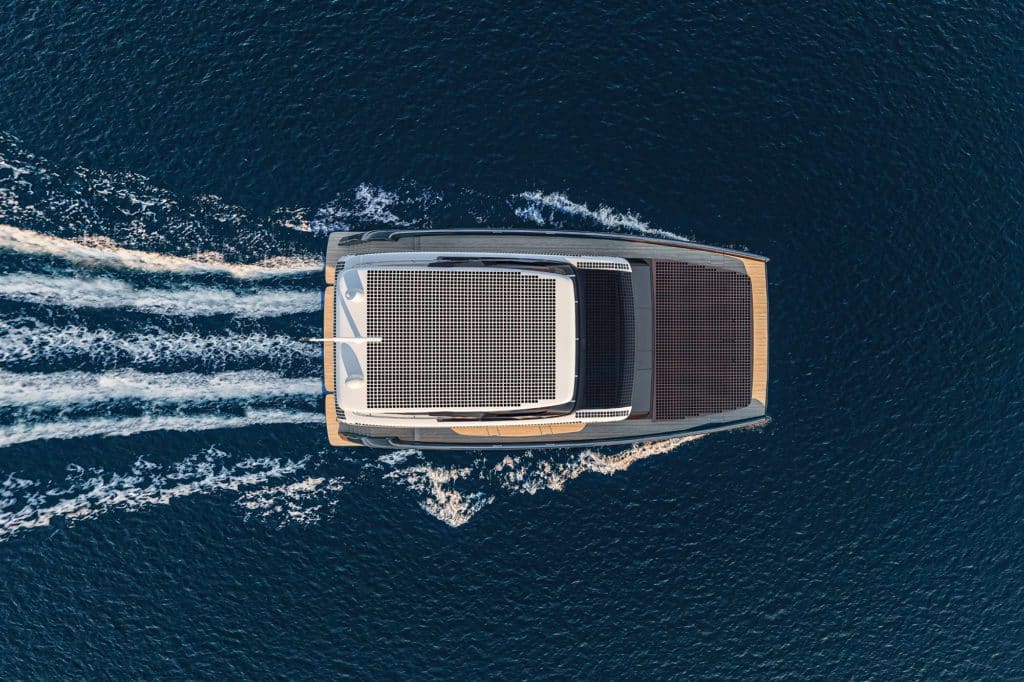
The powerboat drivers idle near their starting lines off Monaco, waiting for the signal to punch the throttles. But they’re different from those who have raced here since 1904: These nine boats are competing in the Solar Class at the 2021 Monaco Energy Boat Challenge.
Every July, the Monaco Yacht Club organizes this race, which features next-generation technologies. This year, after five days of competition—including a 16-nautical-mile-lap race, slalom racing and a championship race—the Dutch-flagged Sunflare solar team claimed top honors in the sun-powered class.
Is their boat’s top speed of about 29 knots going to break any world speed records? No. But the Monaco Energy Boat Challenge is a harbinger of recreational boating’s not-so-distant future.
That future, of being carbon-free, has been a long time coming. German inventor Moritz von Jacobi created an early electric boat in 1839, a 24-footer that could carry 14 passengers at roughly 2.6 knots. In 1882, Anthony Reckenzaun, an Austria-born electrical engineer, built Electricity , a steel-hulled launch with onboard batteries that was considered one of the first “practical” electric vessels. Other innovations continued until circa 1910, when Ole Evinrude’s gasoline-fired outboards began their own revolution.
Now, a century later, electric yachts harness technologies such as solar panels, electric drivetrains, lightweight construction in carbon fiber, lithium-based batteries and, in some cases, hydrofoils. These boats’ performance, comfort and range can rival some traditionally powered yachts—and they are clean and quiet. Much like Teslas, they sometimes also come with memorable acceleration curves.
Contemporary electric boats range in size and complexity. There are displacement monohulls such as Zin Boat’s 20-foot Z2T and Z2R and X Shore’s 26-foot Eelex 8000. There are hydrofoilers such as the upcoming Navier 27 (see sidebar). There are also boats like those contesting the Monaco Energy Boat Challenge, as well as bluewater cruisers with multiple hulls.
“The first advantage is space,” says Michael Köhler, CEO of Silent-Yachts . “Catamarans have more surface area, which benefits the number of solar panels that can be installed.”
Other advantages of multiple hulls in electric-boat design include increased form stability (no ballasted keels) and reduced drag. “This low resistance means they’re better suited for electric motoring, as they need a lot less energy to move than monohulls,” says Nicolas Lapp, Sunreef Yachts’ strategy consultant for research and development.
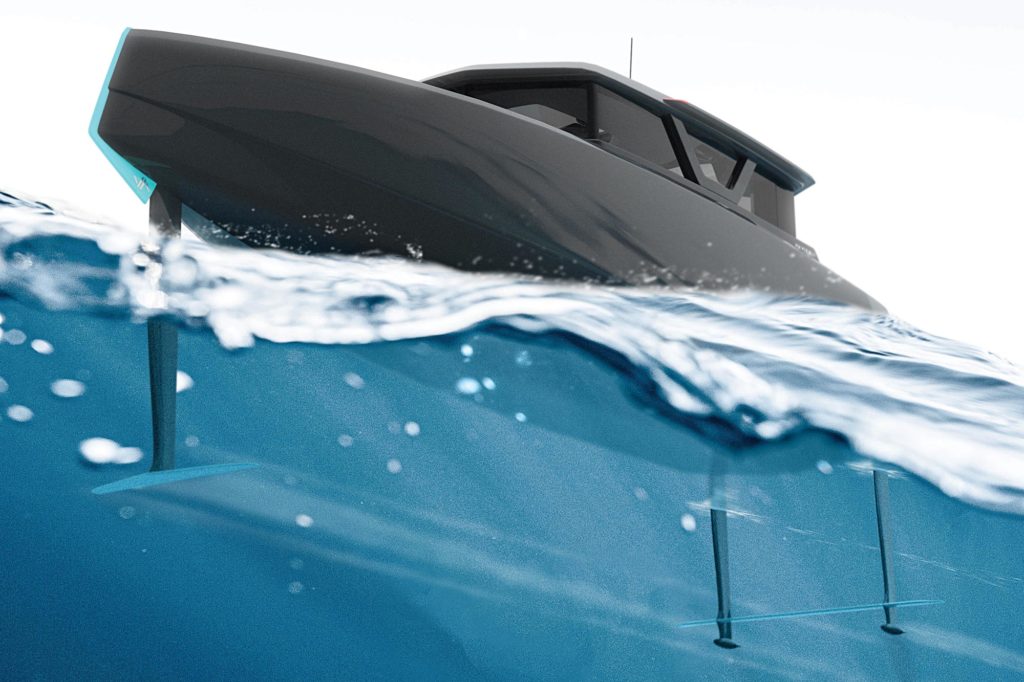
One key to reducing a yacht’s energy requirements involves reducing its displacement. “The lighter the yacht, the less energy is needed to move it,” Köhler says. “For this reason, our yachts are made of lightweight carbon fiber.”
While all of the yachts discussed in this article can be charged via shore-supplied AC power, cruisers typically want greater autonomy. To that end, Silent-Yachts and Sunreef Yachts use solar panels. The team at Silent-Yachts specs its panels from California-based SunPower, while Sunreef Yachts created the marine industry’s first flexible solar panels, which are flush-mounted on hulls, masts and superstructures.
Aesthetics matter in yachting, and not everyone wants to cruise aboard a solar farm. Here, Lapp sees an opportunity. “If you want sustainability to be cool and attract the attention of new generations, the appeal of the product is something you cannot neglect,” he says. “Seamless integration of the solar panels was a way for us to prove that sustainability [can] generate green power [and] cool looks.” (After all, no one buys a Tesla because it looks like a Chevy.)
While the Caribbean and Mediterranean are blessed with abundant lumens, other world-class cruising grounds—say, the Pacific Northwest—aren’t equally illuminated. Because of this, electric cruising yachts typically also include redundant systems to ensure that the navigation lights stay on without heading to a marina.
“Every Silent yacht is equipped with a backup generator,” Köhler says. “This makes sure you never run out of energy, even when facing longer periods of unfavorable weather conditions.”
Rainy-day alternatives can include other green-power solutions. Sunreef Yachts typically specs dual wind generators atop its yachts’ rooftops. However, Lapp is realistic about their capabilities.
“Wind turbines can only supply a small fraction of the energy that our solar panels can,” he says, explaining that, in the right conditions, Sunreef’s panels typically generate 40 times more juice than the turbines. “What’s nice about working with wind is that your generators work all the time.” That includes under navigation, at the dock and throughout the night.

Energy sources aside, these experts say that high-quality batteries offering high performance are critical. Larger-capacity battery banks ensure more power reserves, but adding them can affect a yacht’s performance.
“The weight of the battery banks is also an important factor, as it can reduce or increase the overall efficiency,” Köhler says.
Battery performance is also critical for electric-powered coastal craft. One example is X Shore’s Eelex 8000, which has a high-performance 225 kW electric motor and dual 63 kWh lithium-ion batteries that can be charged anywhere there’s a power socket, or supercharged using the same technology as electric cars.
“The batteries can be charged in five to eight hours with three-phase power plugs and one to two hours with superchargers,” says Elias Wästberg, X Shore’s project manager.
While superchargers don’t exist in the middle of oceans, builders of electric-powered bluewater boats have already done this math. Silent-Yachts says its power catamarans are built to offer transatlantic autonomy, but a lot depends on how the owner uses the boat to minimize energy consumption.
“During sunny conditions, a general rule of thumb is that cruising at 6 knots maintains a balance between consumption and production,” Köhler says. “This basically means unlimited range. …The main thing that owners can do to increase range is reduce speed and turn off any appliances.”
This begs the question: Do owners need to downshift their expectations for onboard comfort when going electric?
“There’s no need to make any sacrifices or closely monitor energy levels,” Lapp says. “A lot of energy saving is done automatically. For example, at night, the air-conditioning system focuses solely on selected areas and cabins. … It consumes 70 percent less energy than most systems.”
And should the battery banks get thirsty, there’s always the generator.
Cruising with zero emissions might be a selling point for some customers, but one need not squeeze trees to embrace yachting’s future. “Running costs and maintenance levels are much lower compared to regular-motor catamarans,” Köhler says.
Then, there are unquantifiable returns. “You get to enjoy the absolute luxury of cruising in total silence and without disturbing the marine life around you,” Lapp says, adding that this experience helps owners create “better connections with the environment.”
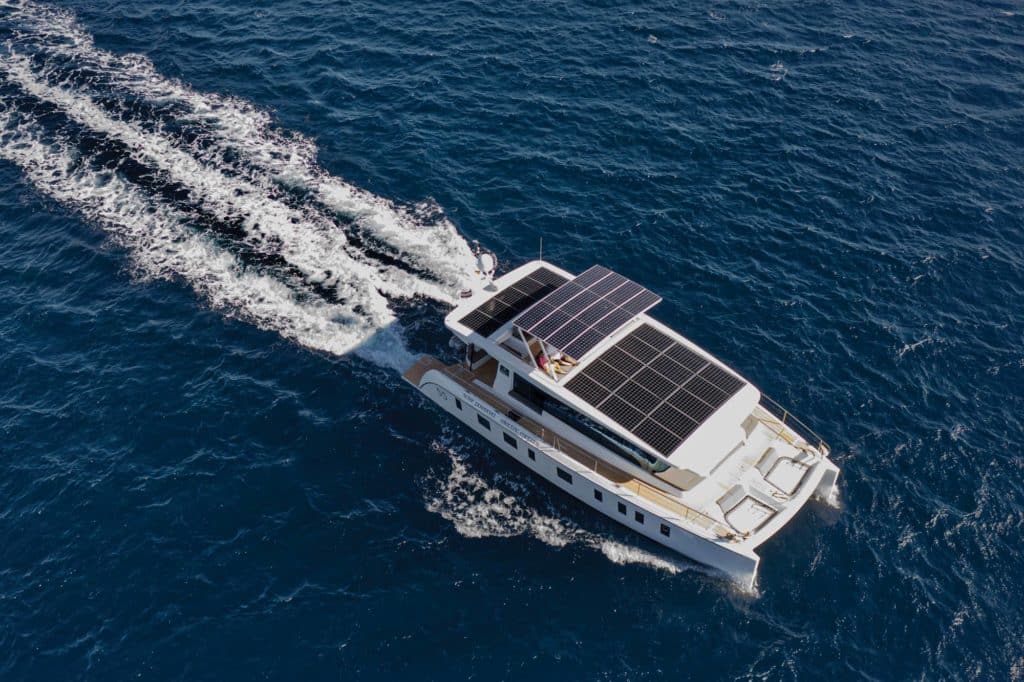
Finally, there can also be the grin factor. “The Eelex 8000 can accelerate from 0 to 20 knots in 4.2 seconds,” Wästberg says. “The software captures 150 data points every second, allowing for real-time analytics of battery and engine performance, including temperature, humidity, pressure, location and the craft’s system status.”
While electric yachts boast some impressive capabilities, free lunches are unicorns. Electric yachts don’t emit carbon dioxide, but their carbon footprint likely deepens with stem-to-stern life-cycle assessments of their photovoltaic panels, carbon-fiber hulls and lithium-based batteries. Then there’s the inconvenient financial truth that all batteries have a finite number of charge cycles and eventually need refitting. Also, for now, diesel mechanics greatly outnumber certified electric-boat technicians, especially in remote locales.
Still, few people gifted with foresight would have bet against Evinrude’s outboards in the early 20th century. The same holds true for today’s electric boats. One only has to look at the Monaco Energy Boat Challenge to realize that some of the brightest minds in the marine and technology fields are committed to a carbon-free future.
Couple this trend with the fact that electric yachts are already providing better performance and compromise-free cruising, and yachting’s future is looking bright (green).
Navier Boats teamed up with Paul Bieker, an America’s Cup-winning naval architect and hydrofoil expert, to create the Navier 27. It delivers 30-plus-knot top speeds or a 75-nautical-mile range at slower speeds. While impressive, hydrofoils require active control, which is a crux that Navier solved by creating an autonomous foil-control system.
Sunreef 100 Eco
It’s one thing to build a solar-powered vessel for the Monaco Energy Boat Challenge; it’s a different challenge to build an electric 100-footer that can accommodate 12 guests and five crewmembers. The Sunreef 100 Eco’s flexible solar panels mean this cat can accommodate 2,610 square feet of solar-farm space and generate up to 46 kilowatts per hour of DC power, which should keep its high-performance lithium-ion batteries topped off.
Hands on the Helm
While the Navier 27 will initially require human hands on its helm, down-the-road software releases are expected to enable autonomous driving.
Panel Planners
While photovoltaic panels can be fitted to any yacht, catamarans present themselves as an ideal platform, given their beam and broader coach-roof space.
- More: Electric , Electric Boats , Electric Motors , Electric Yachts , Silent-Yachts , Sunreef Yachts , Yachts , Zin Boats
- More Yachts
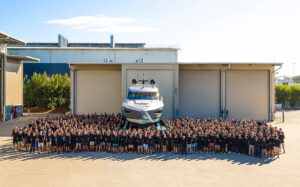
Riviera Launches 6000th Yacht
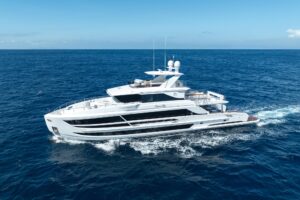
Horizon Yachts Unveils FD108 Tri-Deck
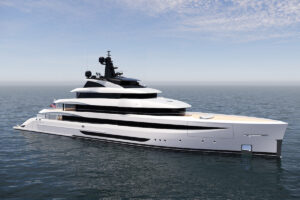
CRN to Build 220-Foot Superyacht
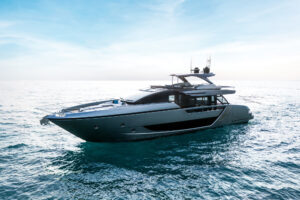
Riva 82′ Diva Reviewed
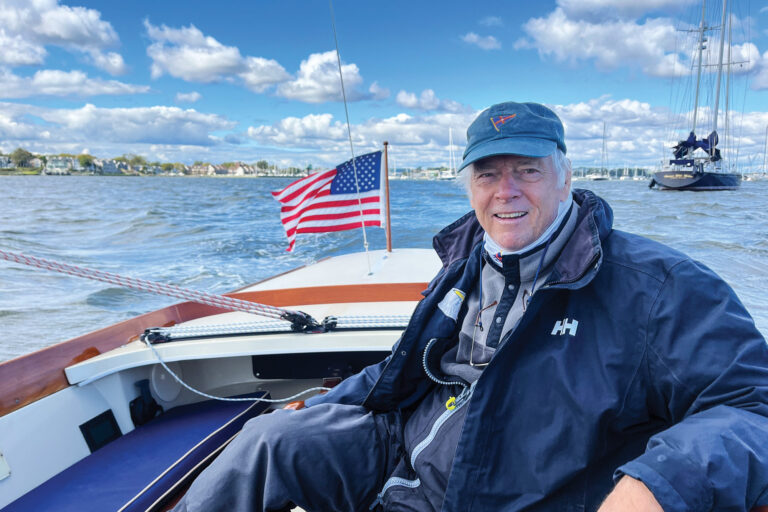
And The US Sailing Capital Is?
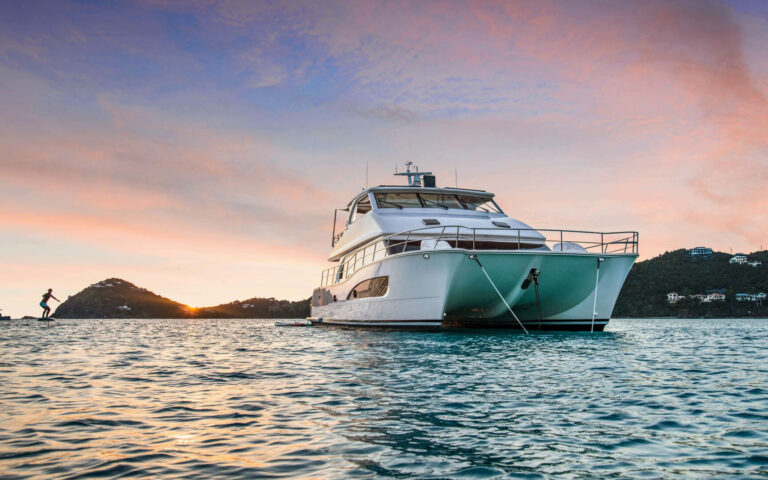
For Sale: Horizon Power Catamarans 60
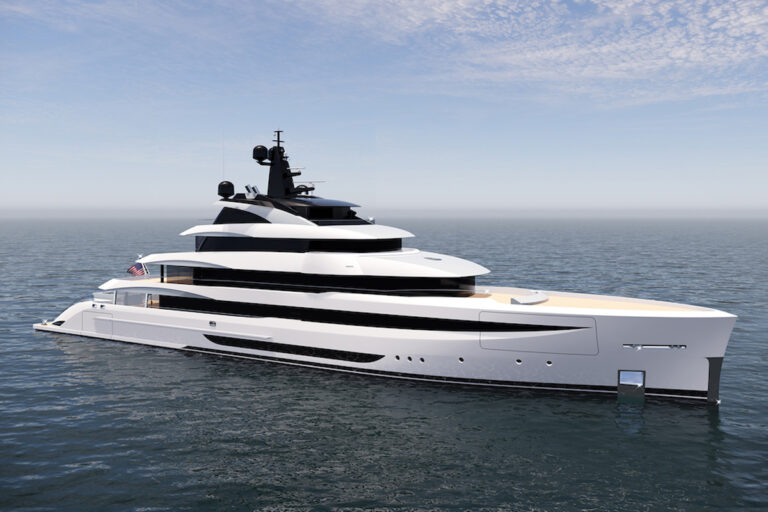
For Sale: 2017 120′ Ocean Alexander

- Digital Edition
- Customer Service
- Privacy Policy
- Email Newsletters
- Cruising World
- Sailing World
- Salt Water Sportsman
- Sport Fishing
- Wakeboarding
- Electric Yachts
- Electric boats
- Solar Electric Boats
- Sunreef Yachts
Sunreef Yachts unveils new luxe solar electric Explorer catamaran with over 1,000 kWh in batteries
Sustainable boatbuilder Sunreef Yachts is adding a sleeker, lighter solar electric catamaran to its portfolio. The new Explorer Eco 40m is the company’s smallest electric yacht to date, but debuts with some of the most advanced technology, including Sunreef’s proprietary “solar skin”
Sunreef shows off gorgeous 80-foot solar electric luxury yacht ahead of US debut this month
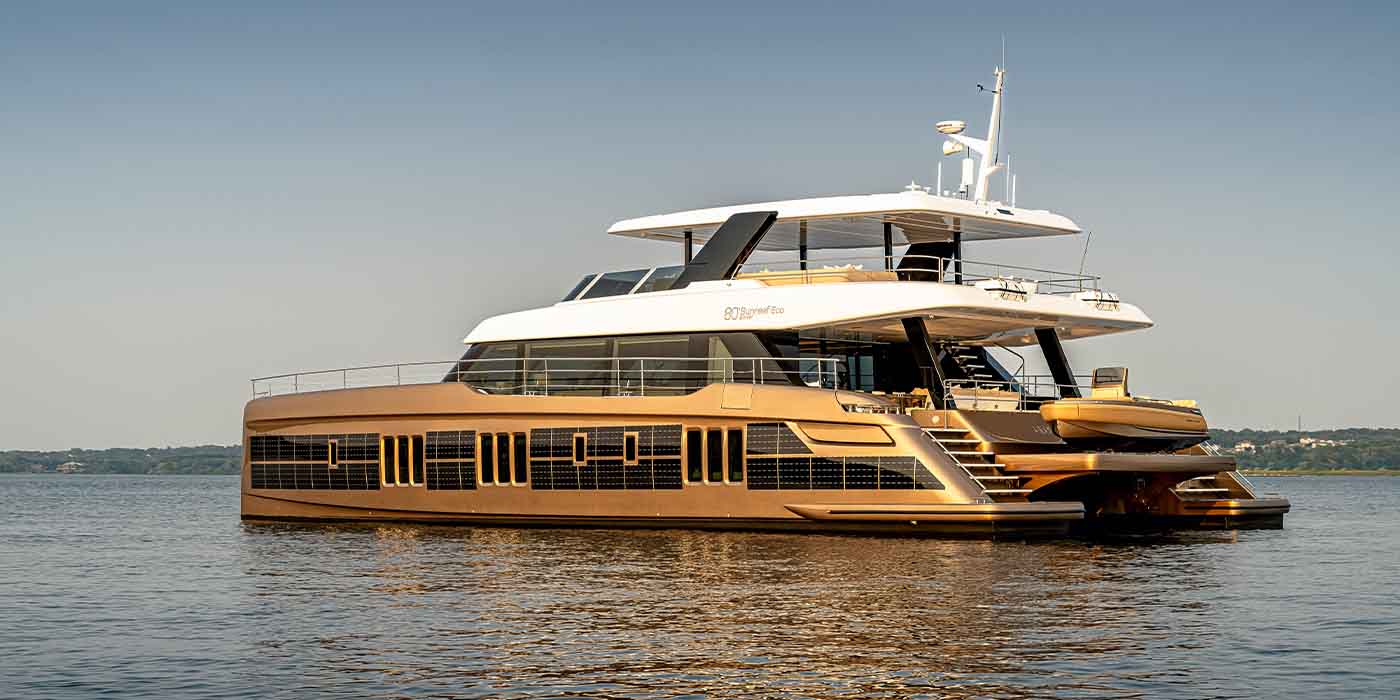
Eco-responsible shipbuilder Sunreef Yachts had given the public its first glimpse of its new 80-foot solar electric yacht before it makes it US debut in Fort Lauderdale, Florida later this month. The 80 Sunreef Power Eco is a fully-electric luxury catamaran that could very well be one of the most advanced solar electric yachts built to date.
This new solar electric yacht with its own spa pool and theater awaits you
Renowned luxury yacht maker, Sunreef, released plans for a new 108-ft (33-m) solar-powered electric superyacht complete with its own pool spa and indoor theater. Did I mention it’s also fully autonomous?
- Hydrogen Fuel Cell
- Alva Yachts
ALVA Yachts goes long with a 90-foot solar electric superyacht boosted by hydrogen and wing sails
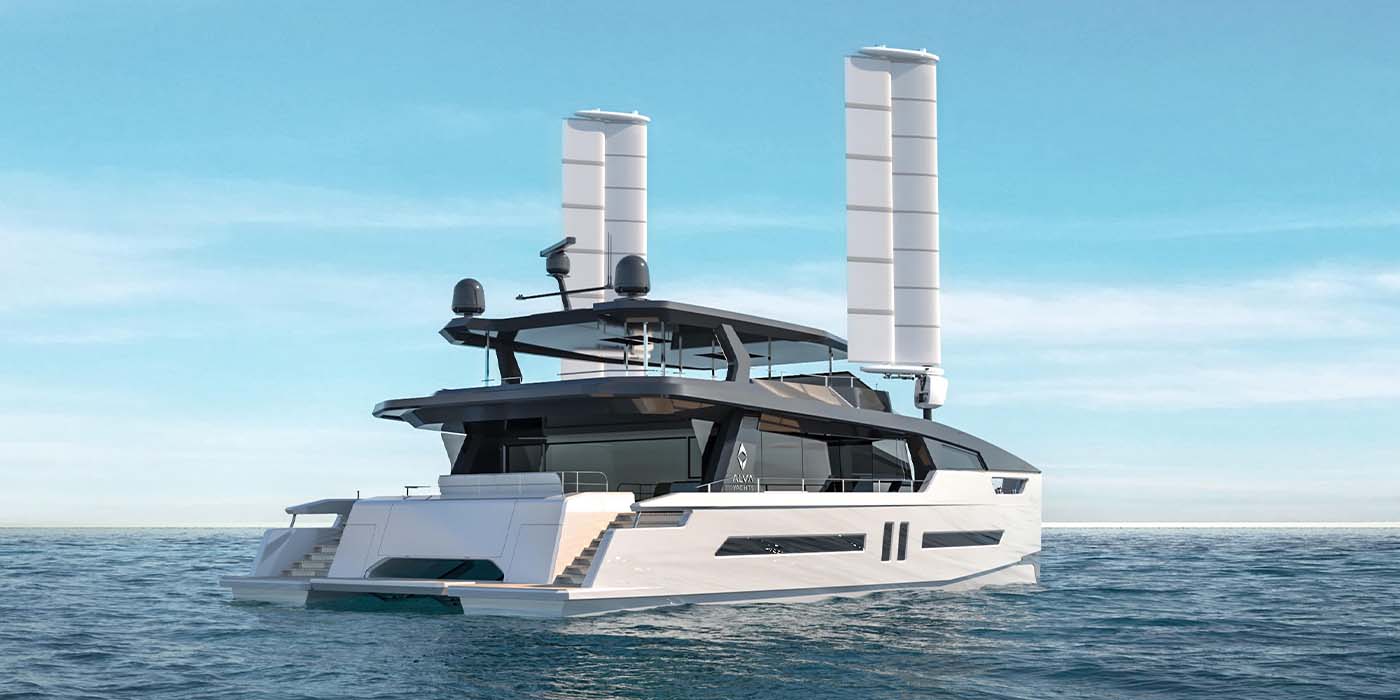
Luxury electric boatbuilder ALVA Yachts is doing what many in the maritime industry consistently strive toward – building vessels bigger and better. Its latest solar electric catamaran is a 90-foot superyacht called the OCEAN ECO 90 H2 – in addition to zero-emissions propulsion and sustainable power, it adds hydrogen fuel cells and a wing sail propulsion system to alleviate any need for fuel aboard. Oh, don’t forget the jacuzzi up top.
- Hydrogen Boats
This 64-foot hydrogen electric yacht uses solar and sea water to power itself with ‘unlimited range’
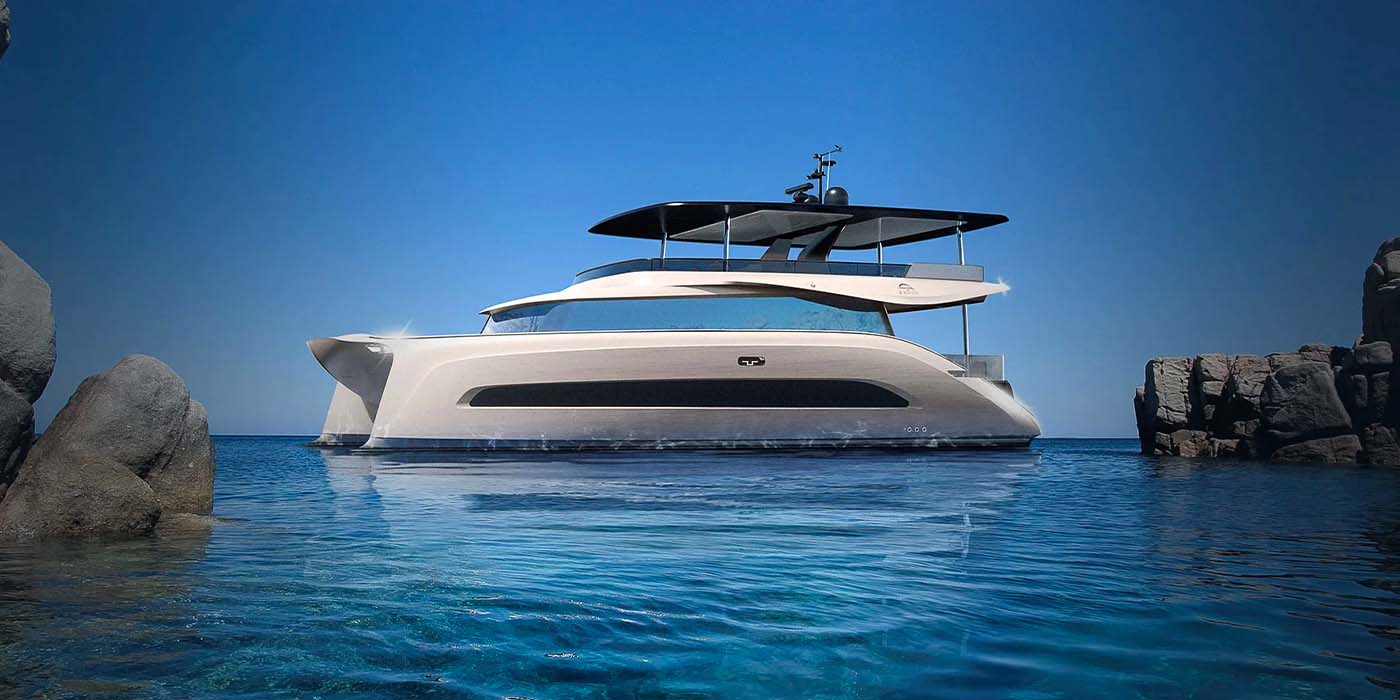
European yacht broker MYSEA has announced the beginning of sales of the AQUON One eco-catamaran – a solar electric yacht powered by the sun and hydrogen fuel cells with luxurious accommodations for eight to ten passengers without any emissions.
This 8,400-sq.-ft. Domus solar trimaran concept plans to deliver unlimited range at sea with zero emissions

Meet Domus – the solar electric sailing yacht concept created as a collaboration between Rob Doyle Design and Van Geest Design. This 40-meter sailing vessel promises to deliver the interior volume of a 60-meter yacht and can propel itself using wind, solar, hydro regeneration, and hydrogen fuels cells to deliver “unlimited range.” All without any carbon emissions. Did we mention it has a movie theater?
ALVA Yachts introduces new 78-foot solar electric catamaran with ‘transatlantic range’
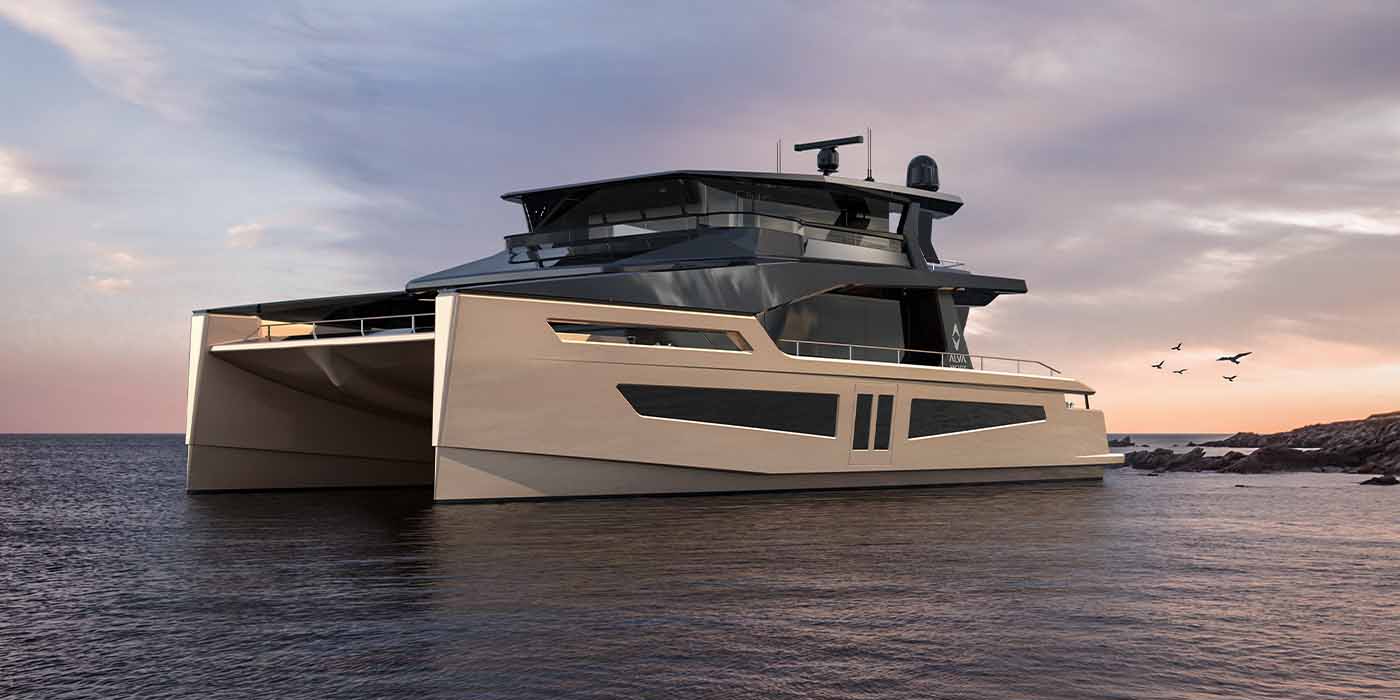
Luxury electric boatbuilder ALVA Yachts is back with its latest solar electric catamaran. The upcoming OCEAN ECO 78 will arrive as a mid-size marine vessel in ALVA’s current lineup and comes equipped with the solar and electric propulsion technology to reach a top speed of 14-15 knots (16-17 mph) at sea, plus plenty of battery capacity to go far – all backed by solar panels on its roof.
- electric boat
- Lurssen Yachts
Meet Project Cosmos: 1,000 mile range, emissions-free megayacht from Apple Watch designer
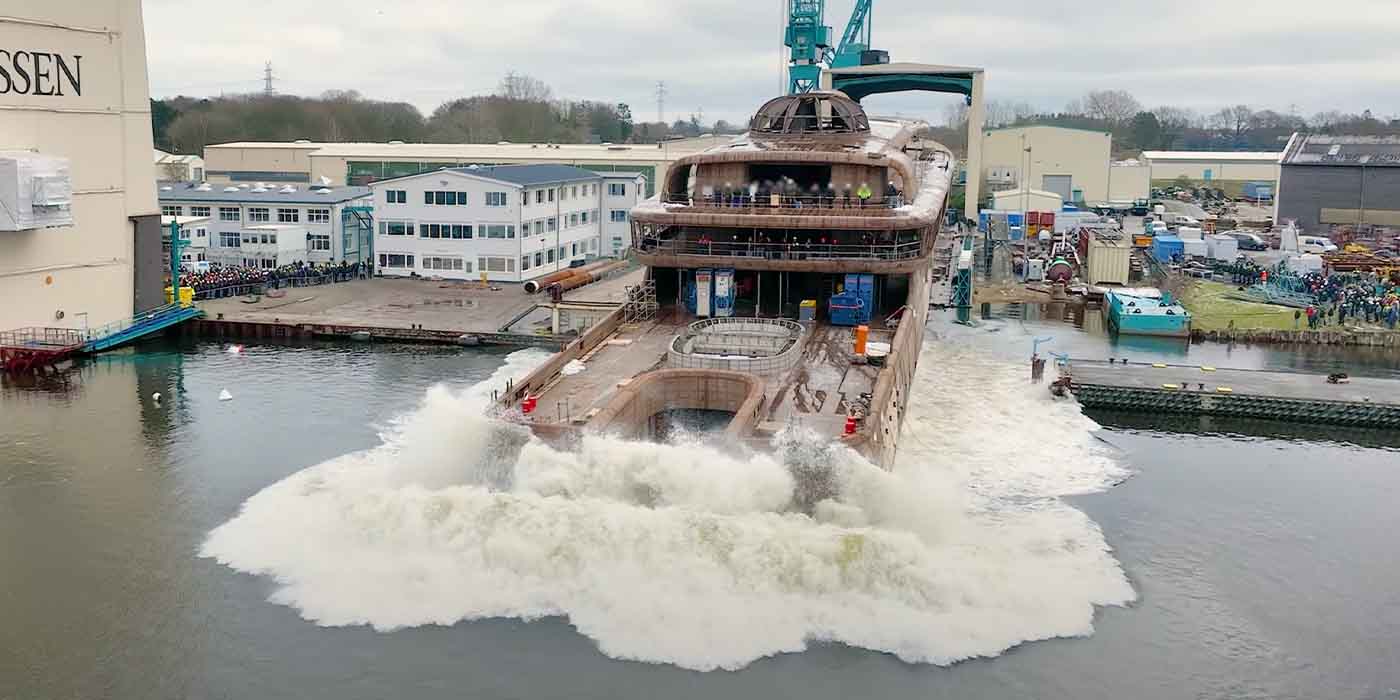
German luxury boatbuilder Lürssen Yachts has shared video footage of it successfully launching a zero-emissions megayacht longer than two olympic swimming pools, suspected to be commissioned by a Japanese billionaire. The exterior of hydrogen powered megayacht, codenamed Project Cosmos, is being designed by Apple designer Marc Newson.
ZEN Yachts secures $5.9M in Series A alongside new orders for its solar electric catamaran
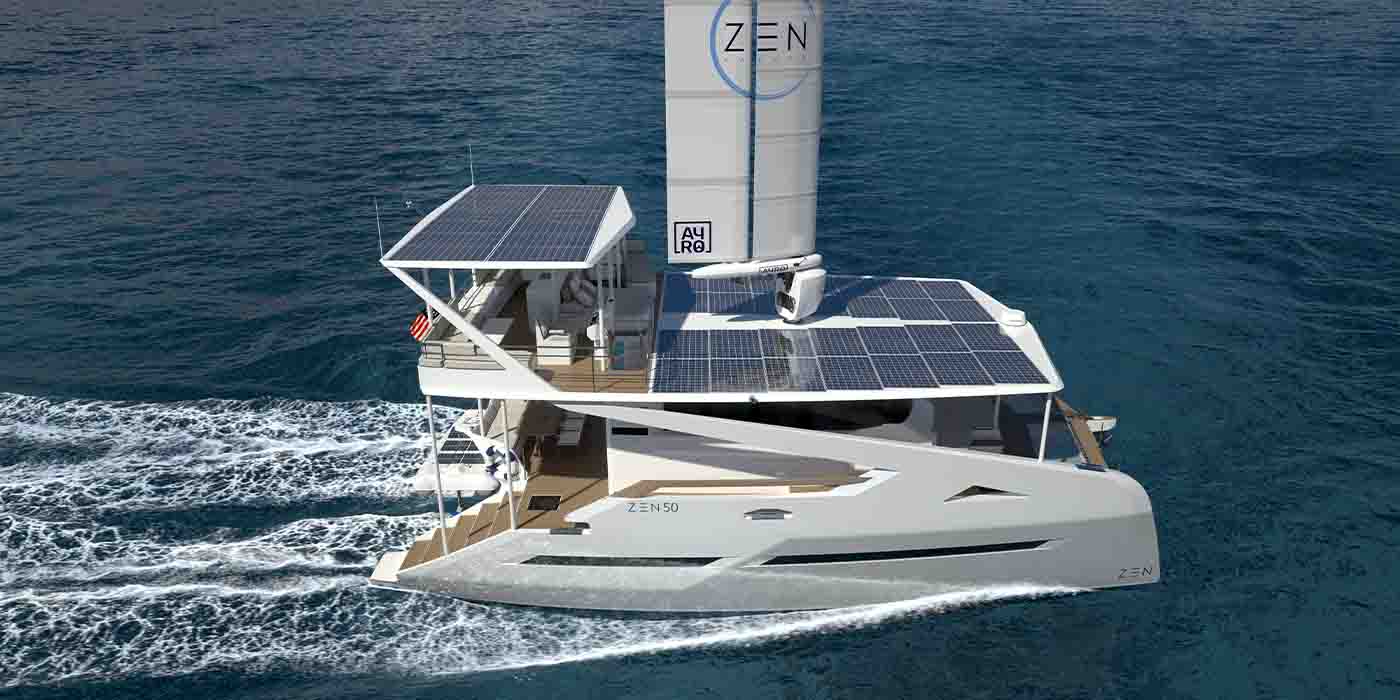
Nascent solar electric catamaran manufacturer ZEN Yachts has announced the closing of a Series A funding round totaling 5.5 million euros ($5.86M), sponsored entirely by Ocean Zero, LLC. The zero emissions boatbuilder looks to use the fresh round of funding to continue construction of the first hulls of its ZEN50 solar electric catamaran, of which additional preorders have now been secured.
- Silent Yachts
- Silent-60 Yacht
First voyage on the solar electric SILENT 60 yacht
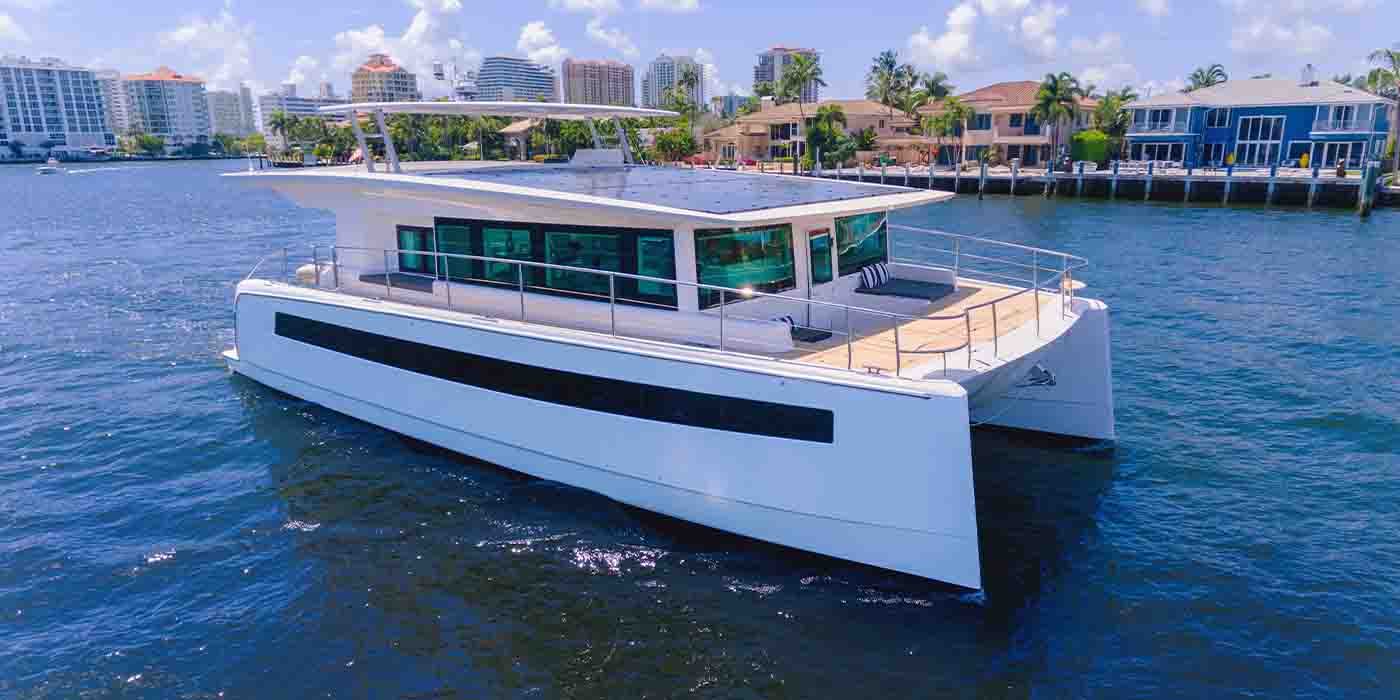
After previously following and reporting on Silent Yachts , the solar-electric boat maker invited me down to Fort Lauderdale, Florida, to experience a cruise on the vessel for myself. The SILENT 60 yacht is a solar electric catamaran that represents the future of zero-emissions maritime travel and a mere stepping stone to the more advanced vessels Silent Yachts is already developing next.
- Solar power
Check out ArkHAUS – A modular, floating, solar-electric social club for members only

If you thought Soho House was exclusive, wait until you see this. ArkHAUS is an upcoming members-only social club that is as innovative as it is stylish, offering multiple solar-powered, electrically propelled vessels than can be connected to create large floating spaces to work, socialize, and enjoy the views – all while supporting local marine research cleanly beneath the vessel.
- Hogdgon Yachts
The oldest shipyard in the US will build Vita’s new LION high performance electric boat
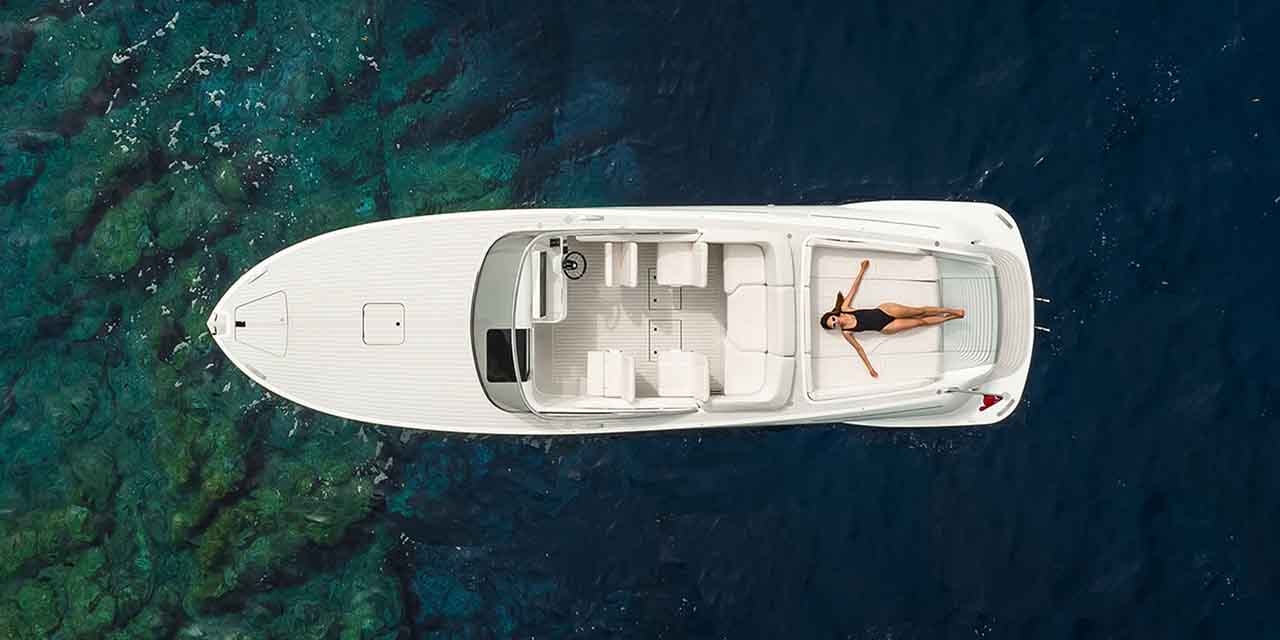
Vita, a manufacturer of performance electric boats and electrified marine powertrains, announced its flagship model, the LION, will be manufactured in Maine by Hodgdon Yachts – the oldest shipyard in the United States. When it begins sea trials this summer, the LION will boast impressive marine propulsion specs.
- Electric Boat Charging
- Soel Yachts
Soel Yachts unveils 62 ft solar electric catamaran with 564 kWh battery capacity and ‘trans-ocean range’
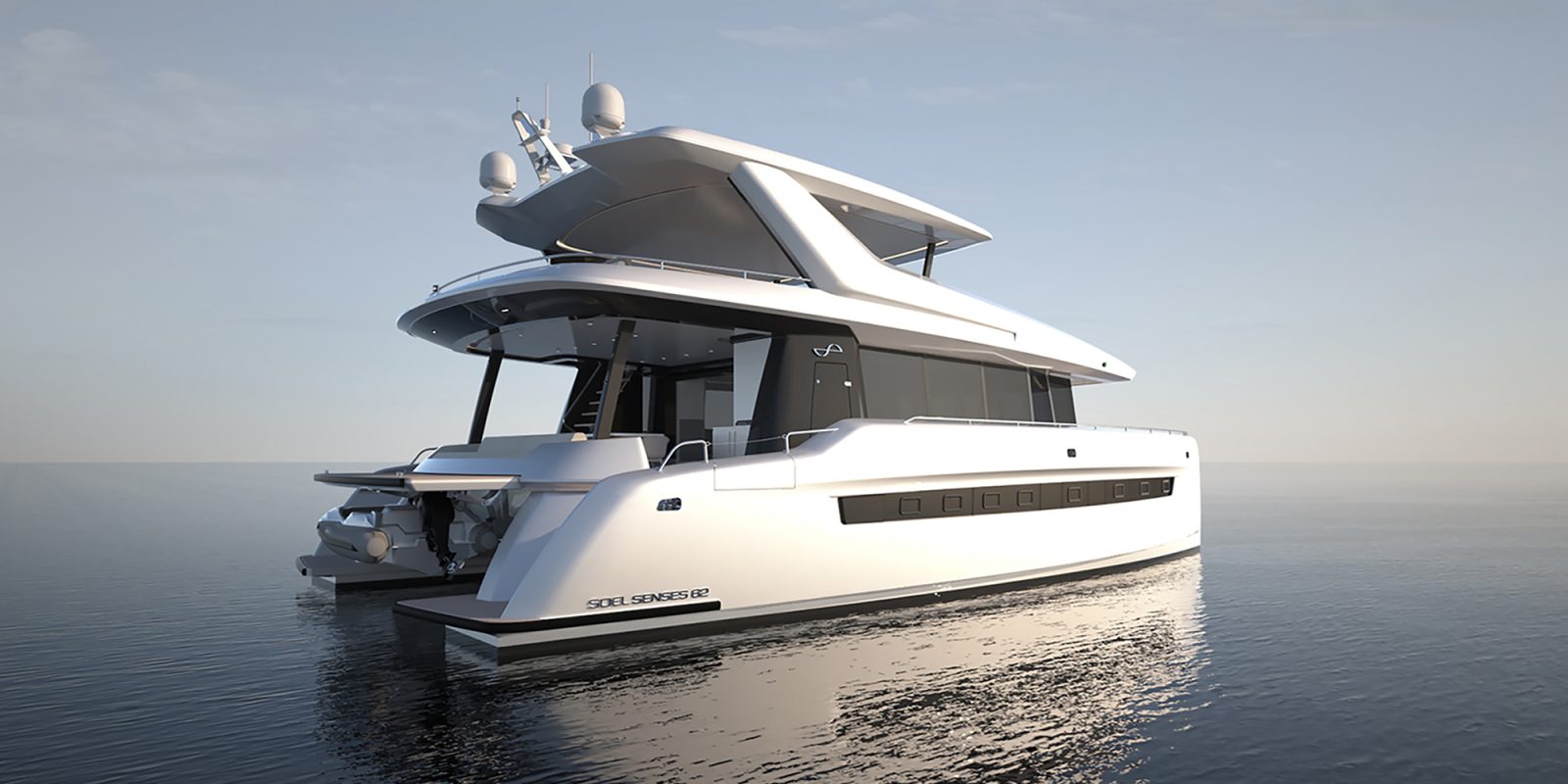
Another day and another solar electric yacht shared with the world, each seemingly going further and faster. The latest announcement comes from Soel Yachts out of the Netherlands, whose new Senses 62 solar electric catamaran boasts some large battery capacity for a yacht, providing what the company calls “trans-ocean range…” however far that means.
ZEN Yachts sells its first ZEN50 electric catamaran featuring solar roof, automated wingsail, and plans for Starlink internet

Infant electric boat manufacturer, ZEN Yachts, has announced its first US order for its flagship ZEN50 solar electric catamaran . The zero-emission sailing yacht is currently under construction in Europe and will arrive with some pretty luxurious features including two kitchens, a high-tech fully-automated wingsail, and Starlink internet from SpaceX.
Luxury e-boat brand ALVA Yachts introduces OCEAN ECO 60 Coupé solar catamaran with twin 250kW electric motors

ALVA Yachts has introduced the latest addition to its family of all-electric luxury sailboats and yachts with the OCEAN ECO 60 Coupé, a 60-foot electric catamaran with solar panels. The Coupé arrives as a new, sportier version of ALVA’s ECO 60 and ECO 60 Explorer electric yachts, offering a lower profile silhouette and innovative new features.

Manage push notifications

Yachting Monthly
- Digital edition

Electric yacht: What are the options for going electric?
- Will Bruton
- July 17, 2020
The options for having an electric yacht or a hybrid-electric yacht are growing in popularity; we outline the current options for those making the switch

The Arcona 380Z is a standard production yacht that has been adapted for electric propulsion. Note the increased solar panel surface area with soft panels bonded to the sails. Credit: Jukka Pakainen
A modern electric yacht can come in all shapes and sizes, from the latest high-tech speed boats with recently developed high-performance electric engines, to a traditional tender with an electric outboard on the back. Increasingly yachts are going electric too as electric engines become increasingly capable of propelling boats weighing several tonnes, and with the rigging for sails, at a reasonable speed for an acceptable length of time.
Since the invention of the marinised engine , there has never been the capacity to store enough fuel to cover significant distances in boats that are smaller than a tanker, with fuel capacity always being the limiting factor. As such the best way to cover long distances on a boat fit for a small number of passengers was, and remains, wind power.
For all the many green attributes that using the power of wind offers, there is no escaping that for most, fossil fuels still represent some part of sailing – whether that be a diesel engine to motor in light winds, onto and off a mooring , or to generate power for onboard electronic systems. Even a small tender used to go from ship-to-shore is often fitted with an outboard motor.
Recent advances in electric power, however, have started to make electric propulsion a reasonable alternative to fossil fuel power. Range will always be an issue but that has long been true of a traditional diesel engine. Improvements in lithuim-ion battery performance is, and likely will continue to, increase range every year.
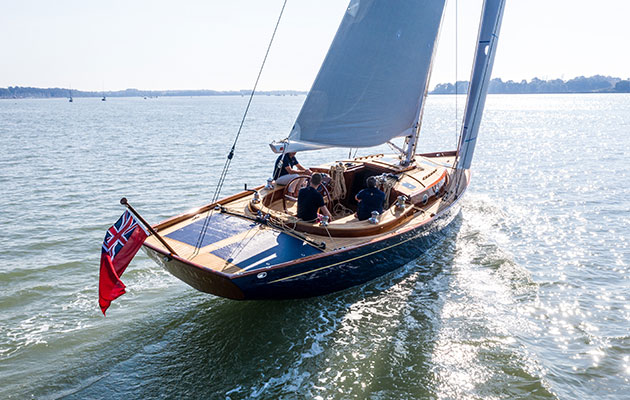
Spirit Yachts 44e – the ‘e’ stands for electric
Additionally electric power and batteries offer the bonus of being able to be recharged via solar panels , a wind turbine or hydroelectric power – via a hydrogenerator mounted on the stern of a boat sailing.
At first glance the electric yacht market could appear in its infancy, but like every revolution, the will of the people is driving forward technology that only a few years ago was seen as the stuff of fantasy.
The market has responded to demand, and battery and motor technology has come on leaps and bounds, driven in part by the rapid development of electric cars.
It may not be commonplace yet, but electric yachting is here, even available ‘off the shelf’, so is it time to get onboard?

The Spirit 111 is a bold hybrid yacht, promising 30 miles motoring under electric power alone. Credit: Ian Roman/Waterline Media
A cutting edge electric yacht
Like Formula One, it’s the cutting edge of electric yachting that trickles down into mainstream production in no time at all.
For Spirit Yachts, a builder defined by a unique blend of traditional and state-of-the-art, electric yachting has been driven by demanding clients that want their yachts to be at the cutting edge.
Spirit Yachts have now produced a number of projects aimed at the all electric luxury yacht market including the Spirit 44e electric yacht and a recent project, the Spirit 111, had all the hallmarks of a superyacht project and the team had to earn their keep delivering to brief.
Managing Director Nigel Stuart explained how it works.
‘The 111 combines several cutting-edge technologies to deliver a something that’s never really been done before. A lithium-ion powered electric drive system can be charged by hydrogenation and also two high-wattage diesel generators.
‘Each generator is 22kw, meaning they can pack a lot of power into the system in a short period of time, they don’t need to run for long to fully recharge.
‘The prop is both a means of drive and power generation, so no separate hydrogenerator is needed. She will be capable of motoring under electric alone for more than 30 miles.
‘When you take on a project that’s electric, it makes you think hard about efficiency so the air conditioning, water heaters and everything in the galley has also been carefully selected to use less power.
‘For her owner there is very little compromise and some major advantages.’
Whilst it’s a long way from the average cruising yacht, the trickle-down effect of projects like the Spirit 111 can’t be underestimated.

Calypso , a Contessa 32, was the yard’s first foray into electric-powered yachts. Credit: Jeremy Rogers
Traditional electric yacht
Jeremy Rogers’ yard in Lymington is the birthplace of the iconic Contessa designs and a veritable temple to long keeled , traditional craft.
Less well known is the yard’s interest in electric auxiliary engines, something they have been involved in for more than 10 years.
Their first project, the refit of a Contessa 32 called Calypso, was an experiment by the Rogers family to see what was possible.
‘ Calypso was a test bed in the technology’s infancy,’ explains Kit Rogers of this early electric boat.
‘Inevitably, we didn’t get it all right, but we learned a lot about the dos and don’ts of electric yachting. The end result was a hybrid. The more we did, the more interesting the project became.
‘It’s not just the obvious, silent peaceful propulsion; it’s also the things you take for granted about a cruising boat. For example, no gas, we didn’t need it because we had electric power.
The yard has also worked on an electric folkboat conversion for a foreign customer.
‘The client, first and foremost, loves to sail. He sees the electric as an auxiliary option, along with the rowing and is excited to own a boat that’s quietly different.
‘He’s looking for a more connected experience and an electric boat helps him achieve it. When you’ve been motoring in and out of marinas under chugging diesel engines for years, the electric motor is something of a revelation.

Arcona has installed solar sails on its latest 380Z electric yacht
Off-the-shelf electric yacht
Perhaps the biggest indication of the future of the electric boat is the willingness of production and semi-production builders to pin their flags to the mast and embrace it.
One of the first was Hanse, who developed a version of their 315 utilising a Torquedo electric pod system.
Providing around the same amount of power as a 10 horsepower diesel, a 4.4kWh lithium ion battery pack powers the system.
Arcona, Dufour, Elan and Delphia also have electric boat models and are each taking their own direction on entering the market.
Arcona’s 380Z (the ‘Z’ stands for ‘zero emission’) fully electric boat has solar panel covered sails, capitalising on the large surface area to top up batteries under sail.
In the multihull market, there is even more scope for solar, wind and hydrogenation due to the horizontal surface area available for solar charging.
What are the options for an electric yacht?
Pure electric.
Purely electric systems can be broadly divided into two categories, high and low voltage.
The latter is the simplest option in terms of how it works and requires less specialist knowledge to install.
Kit Rogers installed a 48v Ocean Volt system in his latest project and remarked on the experience.
‘The advantage of the low voltage system is its inherent lack of complexity. Whilst we’ve coupled it with lithium ion battery technology, it can also be wired up to conventional lead acid batteries. There are pros and cons to both. What surprises everyone is the size, it’s a tiny motor and is surrounded by lots of space where the engine would normally sit.’
High voltage systems are more advanced, and utilising lithium-ion technology, their capacity is improving year on year.
For larger yachts this is generally seen as a better option.
A partnership between BMW and Torqueedo has led to the development of the Deep Blue 315v high voltage battery.
Effectively the same unit as found in the BMWi3 electric cars now often seen on the high street, the system produces a lot of power and is being used on the Spirit 111 project as well as catamarans.
Electric hybrid
One big barrier to entry exists for most potential electric yacht buyers – range.
Even the most advanced set-ups are limited to a maximum of a few hours motoring at cruising speed.
‘The electric motors excel at two things in particular,’ explained Kit Rogers.
‘The first is as auxiliary power for getting in and out of marinas. The second is engaged at low power to very efficiently motor-sail in light airs. If you want to do more than that, at present, you need to add a way of packing in the charge into the battery quickly whilst at sea; which means a generator’ .
As with electric cars and as enthusiasm builds for the technology, a hybrid option, pairing a generator with an electric drive system, is already proving popular and is probably the most practical option for those planning to cruise any distance.
Using a large generator, charge can be quickly put into the system when needed.
Once under sail, the yacht’s propeller becomes a hydro generator, meaning that diesel power is not needed day-to-day.
Solar can also be used to add additional charging capacity.
‘When a fully integrated electric hybrid system is incorporated into a cruising yacht from the outset, its possibilities really become clear,’ explains John Arnold, UK manager at Torqeedo.
‘Sailing for days on end with no engine noise is entirely possible. There are other less obvious benefits too. Electric drives have no long rotating shaft, so can be used as pod drives as well, meaning the boat is far more manoeuvrable than even a yacht equipped with bow and stern thrusters.’

Spirit Yachts 44e
How much does it cost to convert a yacht to electric power?
The technology exists, but anyone seriously considering going electric will want to crunch the numbers.
In the case of taking out a traditional inboard diesel and replacing it with an electric system, it’s relatively easy to work this out.
However, unless you include an auxiliary generator, you will be limited to battery range alone.
For this reason, we’ve done a like for like comparison for a 35ft yacht engine refit, including the cost of a generator to make the system a practical hybrid.
Unsurprisingly, at the moment, there’s a big difference in cost, but at between three to six times the cost, it is gradually coming into the realms of possibility, and prices should continue to drop as technology develops and evolves.
Ocean Volt SD10 Motor system (including batteries, charger and 6kw generator): £30,825.16
Beta Marine Beta 20hp Marine Diesel: £4,100
If you enjoyed reading this….
A subscription to Yachting Monthly magazine costs around 40% less than the cover price .
Print and digital editions are available through Magazines Direct – where you can also find the latest deals .
YM is packed with information to help you get the most from your time on the water.
- Take your seamanship to the next level with tips, advice and skills from our experts
- Impartial in-depth reviews of the latest yachts and equipment
- Cruising guides to help you reach those dream destinations
Follow us on Facebook , Twitter and Instagram.

Electric Boat Motors
Compact ⋅ efficient ⋅ reliable, 877-411-3526, the trusted solution for electric boating.
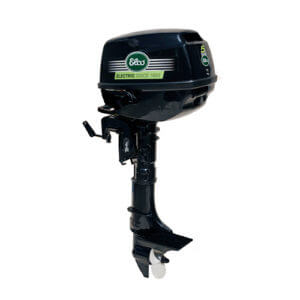
EP-5 Electric Outboard
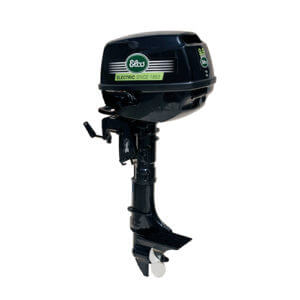
EP-9.9 Electric Outboard
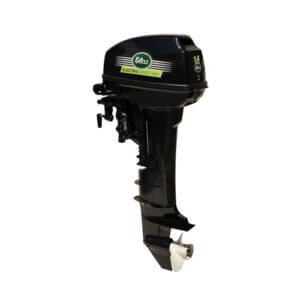
EP-14 Electric Outboard
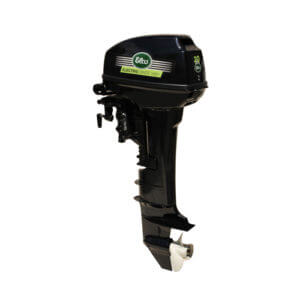
EP-20 Electric Outboard
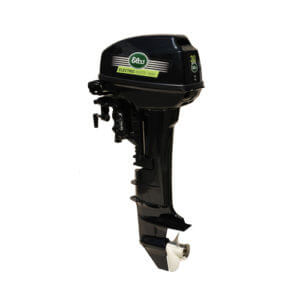
EP-30 Electric Outboard
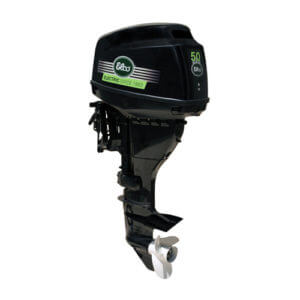
EP-50 Electric Outboard
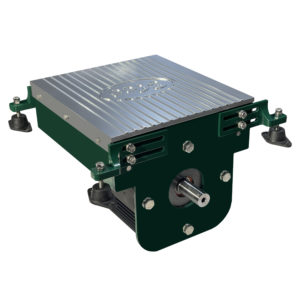
EP-6 Electric Inboard
Ep-12 electric inboard, ep-20 electric inboard.
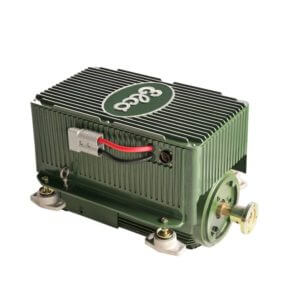
EP-40 Electric Inboard
Ep-70 electric inboard, ep-100 electric inboard.
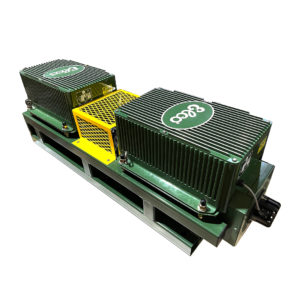
EP-200 ELECTRIC INBOARD
Award winning electric propulsion.

Elco Motor Yachts has been at the forefront of marine innovation, proudly boasting a rich history spanning over 130 years. The company supplied 55 groundbreaking electric launches at the 1893 Chicago World’s Fair. The vessels, powered by Elco’s electric boat motors, swiftly captured the hearts of boating enthusiasts worldwide.
Today, Elco’s award-winning electric outboards and inboards are not only reliable and powerful but also embody the company’s steadfast commitment to sustainability. When you buy an Elco electric motor for your boat, you’re purchasing more than just a product—you’re investing in a cleaner, quieter boating experience.
Whether you need an inboard or an outboard, Elco has the best electric boat motors for sale for you when you’re ready to switch to electric propulsion. Our electric marine motors outshine traditional gas-powered motors. They’re quieter, they’re kinder to the environment, and they’re quality choices. Experience the superior performance and environmental benefits of our electric boat motors today.
Electric Outboards
Traditional on the outside, cutting-edge on the inside
Electric Inboards
All torque, one moving part, and no transmission
Port Elco Club
Check out our latest news and updates from our Port Elco community.
Elco's Story
Our legacy stretches back more than 130 years ago to the 1893 Chicago World’s Fair.
ELECTRIC BASS: Outboard Technology Promises a Bright Future For Urban Bass Anglers
Planing on electric.
Electric Boat Drives
Commercial Fleet
Quick Shopping Links
- Electric Outboard Motors
- Electric Outboard Motor 5 HP
- Electric Outboard Motor 9.9 HP
- Electric Outboard Motor 14 HP
- Electric Outboard Motor 20 HP
- Electric Outboard Motor 30 HP
- Electric Outboard Motor 50 HP
- Electric Inboard Motors
- Electric Inboard Motor 6 HP
- Electric Inboard Motor 12 HP
- Electric Inboard Motor 20 HP
- Electric Inboard Motor 40 HP
- Electric Inboard Motor 70 HP
- Electric Inboard Motor 100 HP
- Electric Inboard Motor 200 HP
Battery Chargers
- NOCO GEN 2 Deep Cycle Battery Charger
- NOCO GEN 3 Deep Cycle Battery Charger
- NOCO GEN 4 Deep Cycle Battery Charger
- NOCO GX2440 Lithium Battery Charger
- NOCO GX4820 Lithium Battery Charger
- EV- AGM / Lithium Battery Charger
- Electric Boat Motor Batteries & Accessories
- Elco Classic Launches
- Elco in the News
- Customer Stories
- Press Releases
- Get Updates
- Benefits of Going Green
- Our Technology
- Frequently Asked Questions
- Honoring Heroes
- Tell us about your boat
- Dealer Application
- Dealer Log-In
- Return Policy
© 2024 Elco Motor Yachts. All Rights Reserved. Sitemap.
- Privacy Overview
- Strictly Necessary Cookies
This website uses cookies so that we can provide you with the best user experience possible. Cookie information is stored in your browser and performs functions such as recognising you when you return to our website and helping our team to understand which sections of the website you find most interesting and useful.
Strictly Necessary Cookie should be enabled at all times so that we can save your preferences for cookie settings.
If you disable this cookie, we will not be able to save your preferences. This means that every time you visit this website you will need to enable or disable cookies again.
- BOAT OF THE YEAR
- Newsletters
- Sailboat Reviews
- Boating Safety
- Sailing Totem
- Charter Resources
- Destinations
- Galley Recipes
- Living Aboard
- Sails and Rigging
- Maintenance

The Promises and Pitfalls of an All-Electric Yacht
- By Tim Murphy
- Updated: November 8, 2021
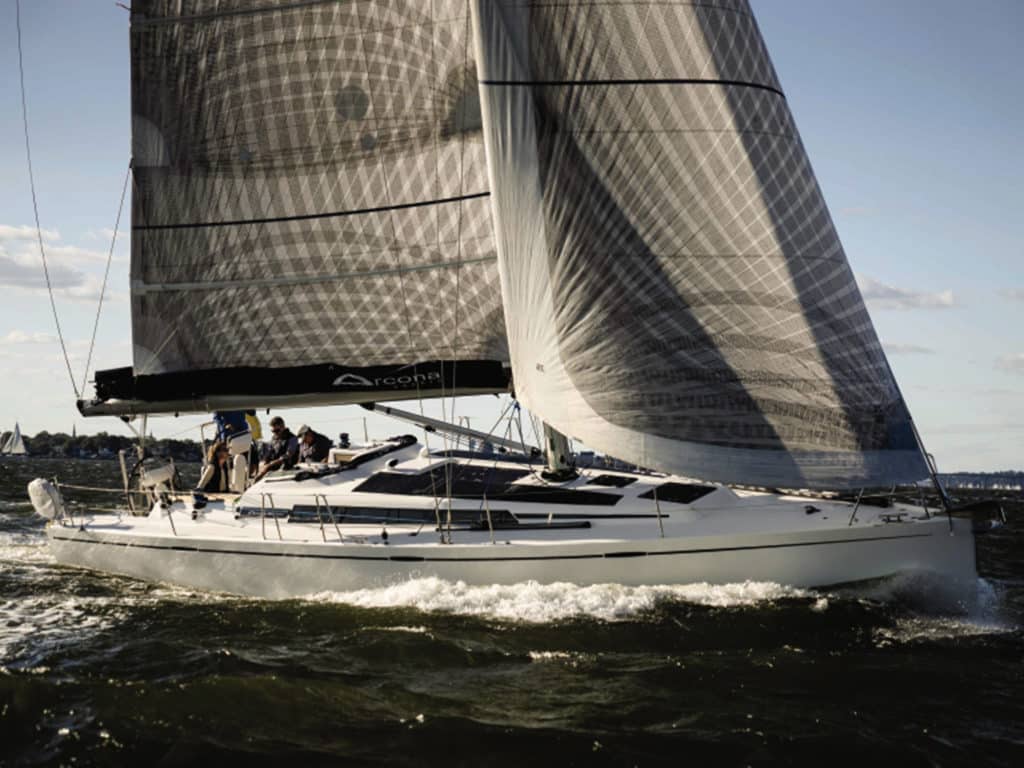
This past October, I saw one of the most interesting exhibits in more than 500 new cruising sailboats I’ve reviewed over two decades. It was the Arcona 435Z, built in Sweden and introduced by Graham Balch of Green Yachts in San Francisco. Balch describes his business as “a new brokerage dedicated to the electric revolution on the water,” and it was the “Z” in the boat’s name, which stands for “zero emissions,” that made this boat so interesting. This was the first electric propulsion system—not hybrid but all-electric —I’d ever seen on a cruising sailboat.
Electric propulsion isn’t new. Since 1879, electric motors have propelled boats; a fleet of some four-dozen electric launches transported visitors around the 1893 Colombian Exposition in Chicago. But cruising sailboats are not launches, and the open sea is not a protected canal. When we’re using cruising boats as they’re meant to be used, they seldom end their day plugged into a shore-power outlet. Cruising boats comprise many devices —stove, refrigerator, freezer, windlass, winches, autopilot, radar, lights—whose power typically comes from a tank of fossil fuel. And today’s cruising sailors are accustomed to using diesel auxiliary power to motor through lulls or punch into headwinds and seas.
Starting about 15 years ago, we saw a wave of diesel-electric and hybrid propulsion systems on production and custom cruising boats ( see “Perpetuated Motion,” CW , March 2005 ). Both of those systems ultimately start with an onboard internal-combustion engine. A diesel-electric propulsion system relies on a running genset to directly power the electric motor that turns the propeller. A hybrid system relies on batteries to power the electric motor, plus an internal-combustion genset to recharge the batteries. One of the promises of a hybrid system is the ability to regenerate electrical power. Regeneration means using boatspeed under sail to turn the propeller, whose spinning shaft sends electrons from the electric motor back through an electronic controller to recharge the batteries. In such a system, the boat’s propeller is both an electrical load (when running under power) and a charging source (when sailing in regeneration mode).
The Arcona 435Z was different from both of these systems: It incorporates no onboard fossil-fuel engine at all. Instead, it has a bank of lithium batteries, several solar panels, and a proprietary propulsion leg that looks like a saildrive. “This boat,” Balch said, “has the very first production unit in the world of Oceanvolt’s newest electric propulsion system, called the ServoProp.”
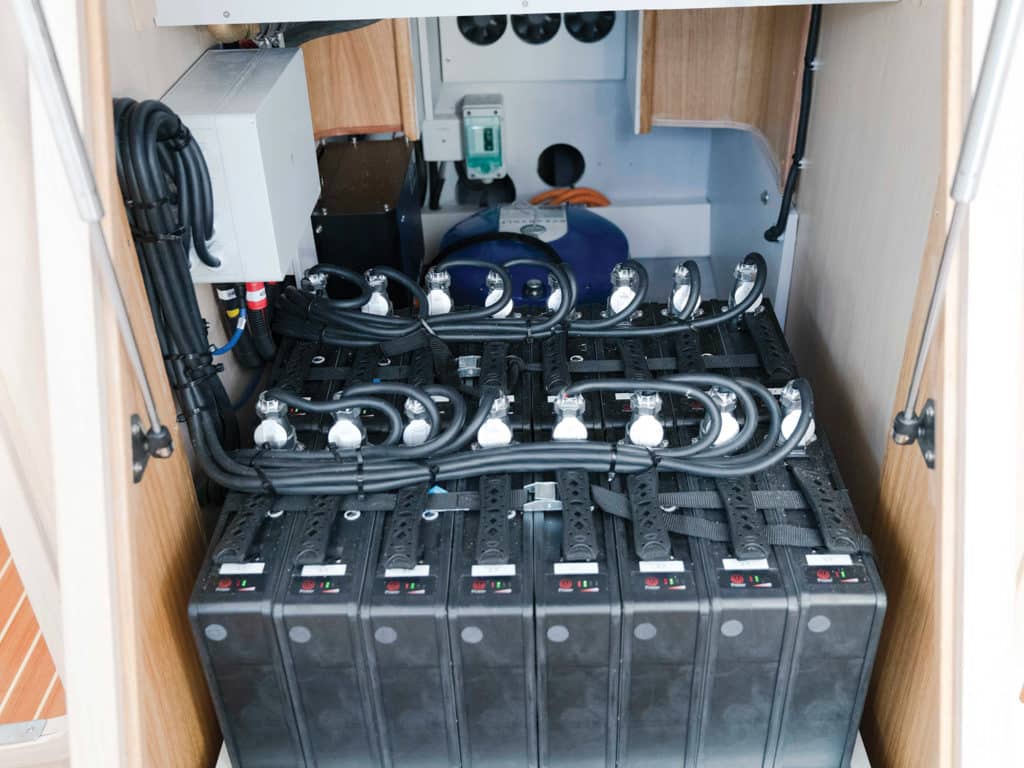
For our sea trial, Balch was joined by Derek Rupe, CEO of Oceanvolt USA. “If you can sail the boat and you have some solar, you can go anywhere in the world, and you can make all your power underway while you go,” Rupe said. When we spoke in October 2020, he touted three high-profile sailors who were using the Oceanvolt electric propulsion system: Alex Thomson, for his Hugo Boss Open 60 Vendée Globe program; Jimmy Cornell, for his Elcano 500 expedition; and Riley Whitelum and Elayna Carausu, who had been teasing their new boat for months on their popular Sailing La Vagabonde YouTube channel.
The efficiency of Oceanvolt’s ServoProp and the regeneration from it is the promised game-changer in each of these boats. The ServoProp is a leg with a feathering propeller that can be set for optimal pitch in three modes: forward, reverse and regeneration.
“You don’t need fuel,” Rupe said. “You don’t need to dock; you can go anywhere you want to go and always have the power for living and propulsion.”
That’s the promise. But are there also pitfalls?
Innovation and Risk
Marine electric propulsion is an emerging technology. Compared with the mature and settled technology of diesel engines and lead-acid batteries, electric-propulsion systems—with their electronic controllers and lithium batteries—are in a stage of development best described as adolescent. Every sailor has his or her own tolerance for technical innovation. For the promise of fewer seconds per mile, grand-prix-racing sailors willingly trade a high risk of expensive damage to the sails, rig or the boat’s structure itself; cruising sailors, by contrast, tend to favor yearslong reliability in their equipment as they seek miles per day.
Folks who identify as early adopters take special joy in the first-wave discoveries of a new technology; if they’re clear-eyed about supporting an ongoing experiment, they see themselves as partners with the developers, accepting failures as opportunities for learning. Sailors motivated primarily by changing the trajectory of climate change might be especially willing to modify their behavior to limit their own output of greenhouse gases. Investing in any emerging technology asks you to start with a clear assessment of your own risk tolerance. We’ll return to this theme with one or two real-life examples.
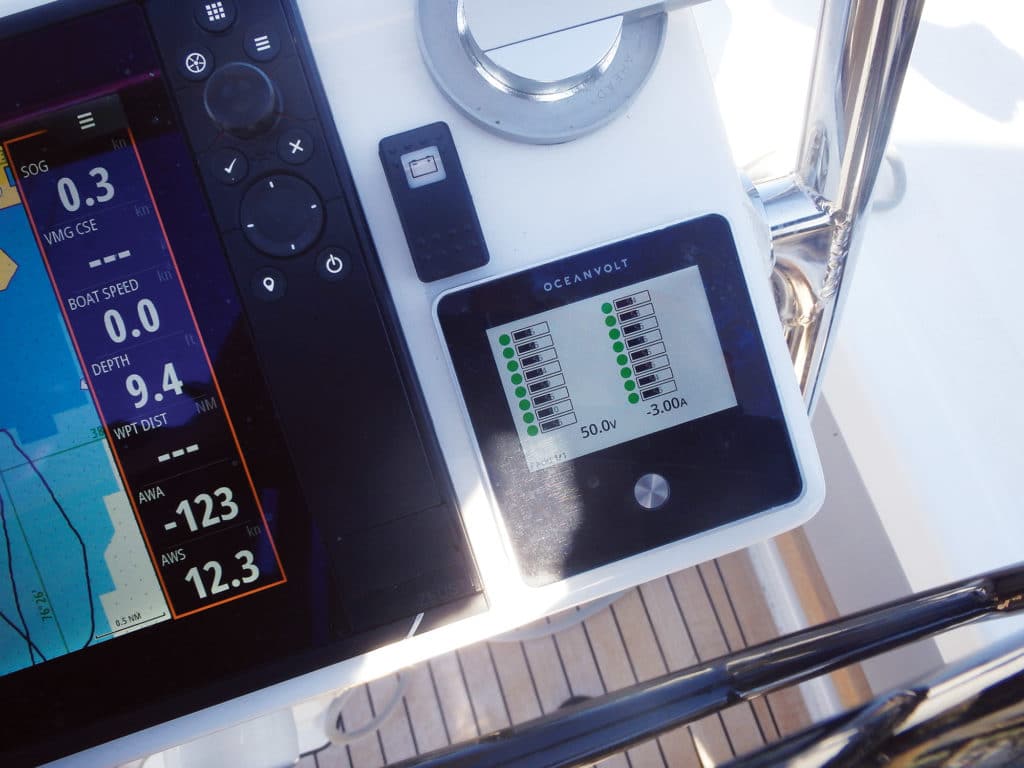
The American Boat and Yacht Council, founded in 1954, sets recommended standards for systems installed on recreational boats. For decades, ABYC has published standards related to installations of diesel and gasoline engines, as well as electrical systems based around lead-acid batteries. By contrast, it was only three years ago that ABYC came out with its first electric-propulsion standard (revised July 2021). And only last year it published its first technical-information report on lithium batteries (a technical-information report is an early step toward a future standard). The takeaway is that if you need help servicing your diesel engine or electrical system built around lead-acid batteries, you can pull into any reasonable-size port and find competent technicians to help you. With electric propulsion and lithium batteries, that pool of skilled talent is significantly scarcer.
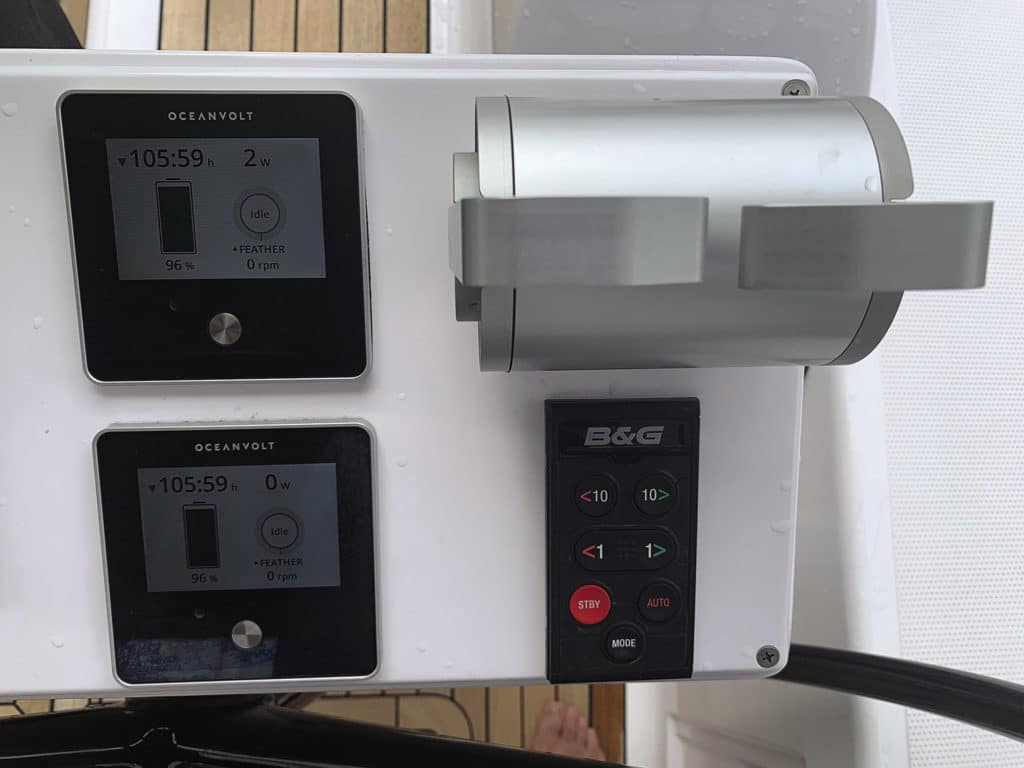
To say that a technology is mature simply means that we’ve learned to live with it, warts and all, but that it holds few remaining surprises. Certainly, diesel-propulsion and lead-acid-battery technologies each leave plenty of room for improvement. When a charge of fuel ignites in the combustion chamber of a diesel engine, some three-quarters of the energy is lost in heat and the mechanical inefficiencies of converting reciprocating motion to rotation. Lead-acid batteries become damaged if we routinely discharge more than half of their capacity. During charging, they’re slow to take the electrons we could deliver.
Lithium batteries are comparatively full of promise. Their power density is far greater than that of lead-acid batteries, meaning they’re much lighter for a given capacity. They’re capable of being deeply discharged, which means you can use far more of the bank’s capacity, not merely the first half. And they accept a charge much more quickly; compare that to several hours a day running an engine to keep the beers iced down.
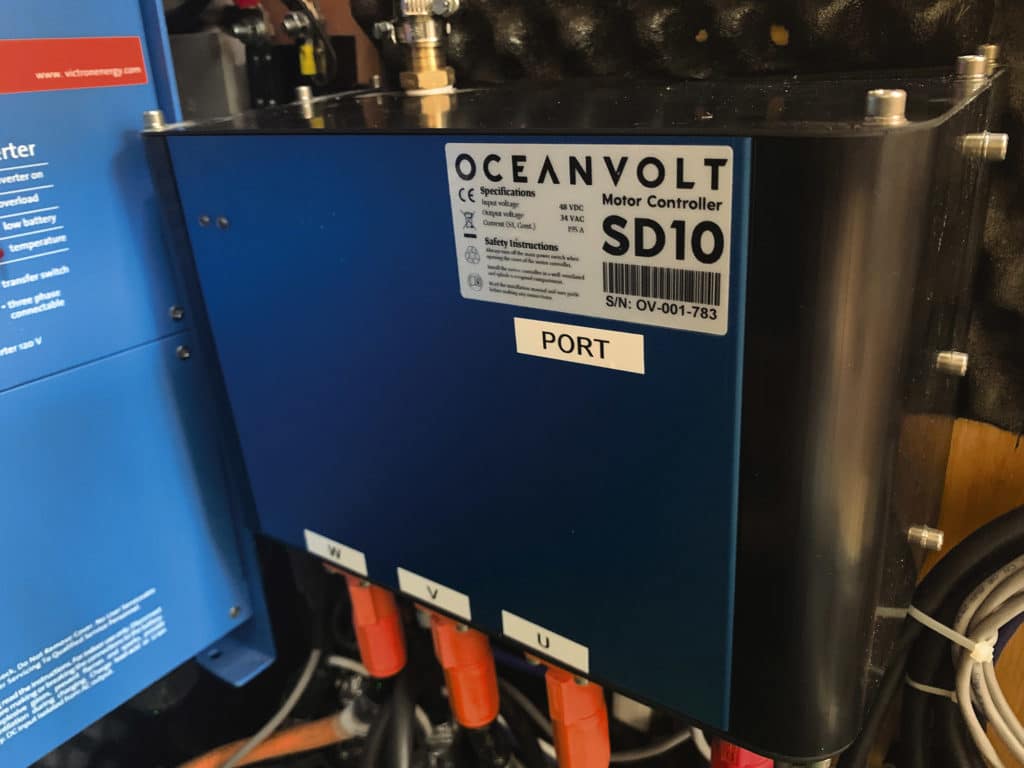
But the pitfalls? Let’s start with ABYC TE-13, Lithium Ion Batteries. Some of its language is bracing. “Lithium ion batteries are unlike lead-acid batteries in two important respects,” the report says. “1) The electrolyte within most lithium ion batteries is flammable. 2) Under certain fault conditions, lithium ion batteries can enter a condition known as thermal runaway, which results in rapid internal heating. Once initiated, it is a self-perpetuating and exothermic reaction that can be difficult to halt.”
Thermal runaway? Difficult to halt? Self-perpetuating?
“Typically, the best approach is to remove heat as fast as possible, which is most effectively done by flooding the battery with water,” TE-13 continues, “although this may have serious consequences for the boat’s electrical systems, machinery, buoyancy, etc.”
If you were following the news in January 2013, you might remember the story of Japan Airlines Flight 008. Shortly after landing at Boston’s Logan Airport, a mechanic opened the aft electronic equipment bay of the Boeing 787-8 to find smoke and flames billowing from the auxiliary-power unit. The fire extinguisher he used didn’t put out the flames. Eventually Boston firefighters put out the fire with Halotron, but when removing the still-hissing batteries from the plane, one of the firefighters was burned through his professional protective gear.
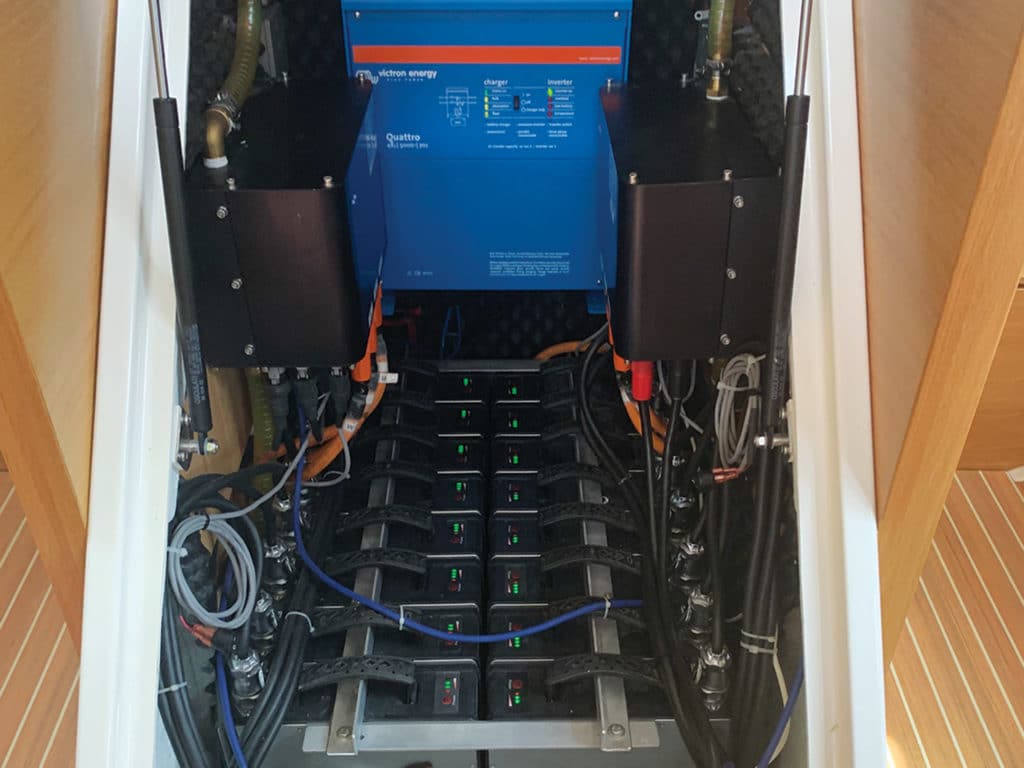
Samsung Galaxy cellphones, MacBook Pro laptops, powered skateboards—in the past decade, these and other devices have been recalled after their lithium batteries burned up. In that period, several high-end custom boats were declared a total loss following failures from lithium batteries. In March 2021, a 78-foot Norwegian hybrid-powered tour boat, built in 2019 with a 790 kW capacity battery bank, experienced thermal runaway that kept firefighters on watch for several days after the crew safely abandoned the ship.
Yes, experts are learning a lot about how to mitigate the risks around lithium batteries. But we’re still on the learning curve.
ABYC’s TE-13 “System Design” section starts, “All lithium-ion battery systems should have a battery management system (BMS) installed to prevent damage to the battery and provide for battery shutoff if potentially dangerous conditions exist.” It defines a bank’s “safe operating envelope” according to such parameters as high- and low-voltage limits, charging and discharging temperature limits, and charging and discharging current limits.
Graham Balch takes these safety recommendations a step further: “To our knowledge, the BMS has to monitor at the cell level. With most batteries, the BMS monitors at the module level.” The difference? “Let’s say you have 24 cells inside the battery module, and three of them stop working. Well, the other 21 have to work harder to compensate for those three. And that’s where thermal events occur.”
Balch followed the story of the Norwegian tour boat this past spring. He believes that the battery installation in that case didn’t meet waterproofing standards: “The hypothesis is that due to water intrusion, there was reverse polarity in one or more of the cells, which is worse than cells simply not working. It means that they’re actively working against the other cells. But if the BMS is monitoring only at the module level, you wouldn’t know it.”
On the Green Yachts website, Graham lists five battery manufacturers whose BMS regimes monitor at the cell level. “If I were sailing on an electric boat, whether it be commercial or recreational, I would feel comfortable with having batteries from these five companies and no other,” he said.
The broader takeaway for today’s sailors is that lithium batteries bring their own sets of problems and solutions, which are different from those of conventional propulsion and power-supply technologies. A reasonably skilled sailor could be expected to change fuel filters or bleed a diesel engine if it shuts down in rough conditions. With lithium-ion batteries aboard, an operator needs to understand the causes and remedies of thermal runaway, and be ready to respond if the BMS shuts down the boat’s power.
Real-World Electric Cruising Boats
When we met Oceanvolt’s Derek Rupe a year ago, he and his wife had taken their all-electric boat to the Bahamas and back the previous season. Before that, he’d been installing electric-propulsion packages for six years on new Alerion 41s and other refit projects. “My real passion is on the technical side of things—installations, really getting that right. That’s half the picture. The technology is there, but it needs to be installed correctly.”
When talking to Rupe, I immediately encountered my first learning curve. I posed questions about the Oceanvolt system in amps and amp-hours; he responded in watts and kilowatt-hours. This was yet another example of the different mindset sailors of electric boats need to hold. Why? Because most cruising boats have just one or two electrical systems: DC and AC. The AC system might operate at 110 or 220 volts; the DC side might operate at 12 or 24 volts. On your own boat, that voltage is a given. From there we tend to think in terms of amps needed to power a load, and amp-hours of capacity in our battery banks. Going back to basics, the power formula tells us that power (watts) equals electrical potential (volts) times current (amps). If your boat’s electrical system is 12 volts and you know that your windlass is rated at 400 watts, it follows that the windlass is rated to draw 33 amps.
But an all-electric boat might comprise several systems at different voltages. A single battery bank might supply cabin lights at 12 volts DC; winches and windlasses at 24 volts DC; the propulsion motor at 48 volts DC; and an induction stove, microwave and television at 110 volts AC. A DC-to-DC power converter steps the voltage up or down, and an inverter changes DC to AC. Instead of translating through all those systems, the Oceanvolt monitor (and Derek Rupe) simply reports in watts coming in or going out of the bank.
“We keep all our thoughts in watts,” Rupe said. “Watts count in the AC induction. They count in the DC-to-DC converter. They count the solar in. They count the hydrogeneration in. And the power-management systems tracks it that way for shore-power in.
“On a boat like this, maybe I have 500 watts coming in the solar panels,” he continued. “So then I can think: ‘Well, my fridge is using 90 watts. My boat has an electric stove. When I cook a big meal, I can see that for every hour we cook, we lose about 10 to 12 minutes of our cruising range.’”
During his Bahamas cruising season, Rupe observed that on days that they were sailing, the combination of solar panels and hydroregeneration supplied all the power he and his wife needed. “When we weren’t sailing,” he said, “we found that we were losing 8 percent each day, in the difference from what the sun gave us to what we were using for the fridge, lights, charging our laptops, and all that stuff.”
Rupe’s solution? “Twice in Eleuthera and once outside Major’s, we went out and sailed laps for a couple of hours because the batteries were below 30 percent of capacity. It was good sailing, and the wind was coming over the shore, so we didn’t have any sea state. We did a couple of hot laps on nice beam reaches, and generated about 700 watts an hour.”
Of the three sailors Rupe touted in October 2020—Alex Thomson, Jimmy Cornell and the Sailing La Vagabonde couple—only Cornell can report back on his all-electric experiences with Oceanvolt. Alex Thomson ended his circumnavigation abruptly last November, just 20 days after the Vendée Globe start, when Hugo Boss collided with an object in the South Atlantic. And at press time in early fall 2021, Riley and Elayna had just recently announced the build of their new Rapido trimaran; keep an eye on their YouTube channel for more about their experiences with the Oceanvolt propulsion system.
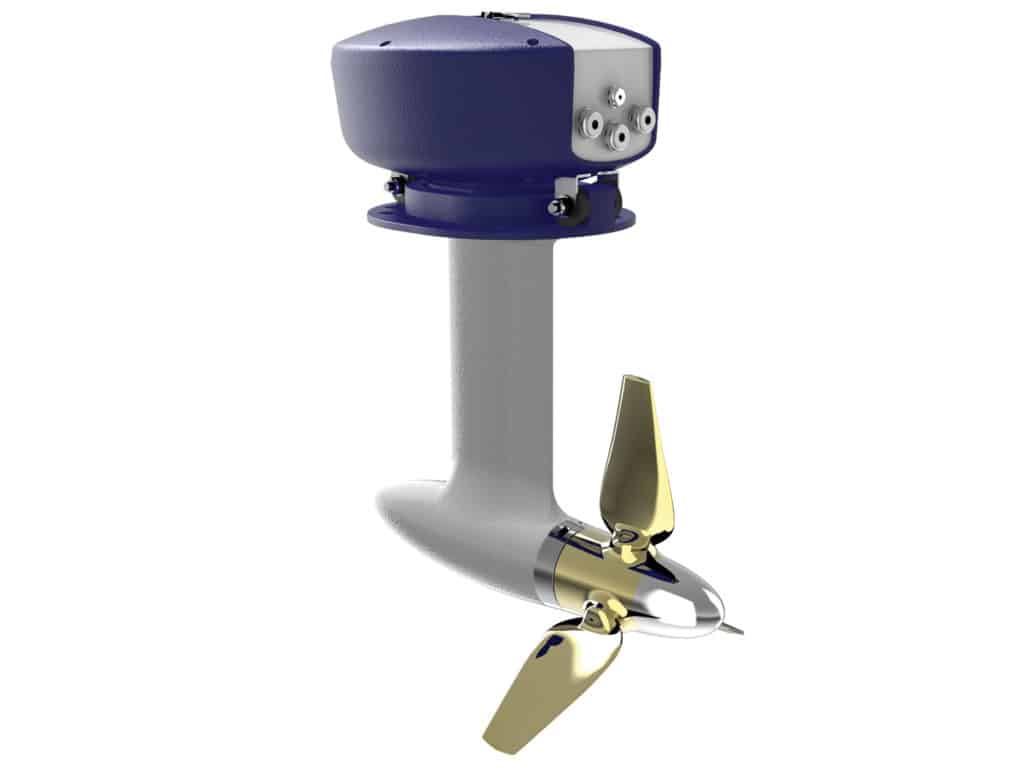
As for Cornell—circumnavigator, World Cruising Routes author, creator of the transoceanic rally, and veteran of some 200,000 ocean miles—he suspended his planned Elcano 500 round-the-world expedition solely because of the Oceanvolt system in his new Outremer catamaran. His Aventura Zero Logs on the Cornell Sailing website, particularly the Electric Shock article posted on December 2, 2020, are essential reading for any sailor interested in sailing an electric boat. “Sailing around the world on an electric boat with zero emissions along the route of the first circumnavigation was such a tempting opportunity to do something meaningful and in tune with our concern for protecting the environment that my family agreed I should do it,” Cornell wrote. “What this passage has shown was that in spite of all our efforts to save energy, we were unable to regenerate sufficient electricity to cover consumption and top up the batteries.”
Cornell’s experience in that article is raw, and his tone in that moment bitterly disappointed. We recommend it as essential reading—not as a final rejection of the electric-boat concept or of Oceanvolt’s system, or even as an endorsement of Cornell’s own decision that the system didn’t work. I suspect that I may have arrived at the same conclusion. Yet given the same boat in the same conditions, one imagines that a new breed of sailor—a Graham Balch or a Derek Rupe—may have responded differently to the constraints imposed by an all-electric boat, as nearly every cruising sailor today habitually responds to the inconvenient constraints of diesel engines and lead-acid batteries.
“If you bring electric winches, electric heads and an induction stove, and then sail into a high-pressure system, you’ll set yourself up for failure,” Balch said. “You have to balance your power inputs and your power outputs.
“Sailing an electric boat is a return to the tradition of sailing that the crutch of a diesel engine has gotten us away from,” he added. “Magellan’s fleet got all the way around the world, and they didn’t have a diesel engine.”
Tim Murphy is a Cruising World editor-at-large and longtime Boat of the Year judge.
- More: Green Wakes , Hands-On Sailor , navigation , print nov 2021 , sailboat review , Sailboat Reviews
- More Sailboats
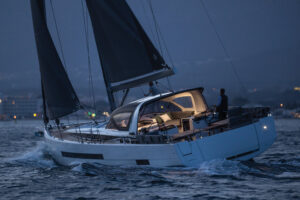
Sailboat Review: Jeanneau Yachts 55
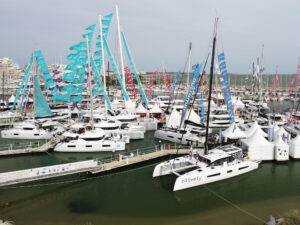
Modern Multihulls: The Future’s Electric

A Gem in New England

Thinking of a Shift to Power?

A Big, New World

Cruising World On Board: Windelo 50

Into the Mystic: A Pacific Northwest Adventure

How to Ride a Wave
- Digital Edition
- Customer Service
- Privacy Policy
- Email Newsletters
- Cruising World
- Sailing World
- Salt Water Sportsman
- Sport Fishing
- Wakeboarding

Electric yacht comparison - Which electric yacht fits you?
- updated: 14. October 2022
Alva Yachts Ocean Eco 60ex – Image: Alva Yachts
Electric yachts are becoming increasingly popular as a result of people’s increased environmental consciousness and limitations caused by climate change. However, with more and more models and manufacturers on the market, it can be difficult to decide which one is right for you. In this electric yacht comparison, you will get an overview of the different models available and learn about the factors that you should consider when making your decision. So read on to find out more!
In this comparison are only electric yachts of over 10 meters in length, if you are looking for a smaller boat, check out our electric boat comparison .
Table of Contents
Electric yacht comparison.
*Base Price excluding VAT, Customs Fees, etc. This is only a reference, the actual price in your country may vary greatly. Therefore, the euro and the dollar were also considered equivalent here.
Alva Yachts - ECO Cruise 50
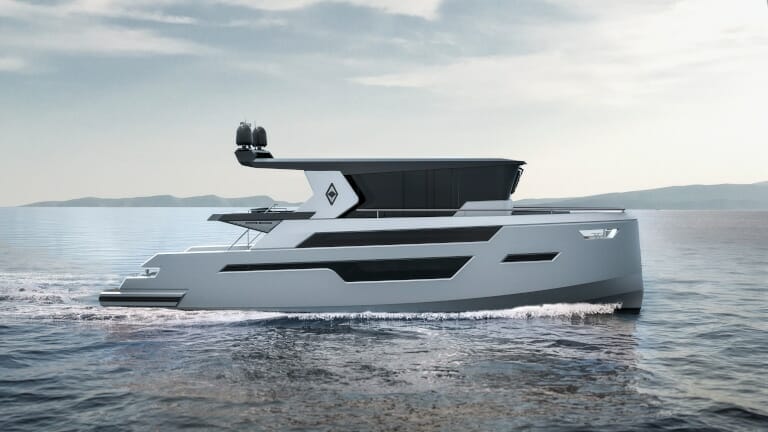
The ECO CRUISE 50 is a monohull yacht that has less space for solar panels than the catamarans of this size. But the ECO CRUISE 50 has the advantage of taking less room and is simpler to handle in port. The rooms are also closer together because you don’t have to go from one hull to the other. With a unique design that includes a huge beach club area with ample area to park the yachts tender and a jet ski while traveling, it’s suitable for both families and groups of friends. Alva Yachts’ designs are forward-thinking and contemporary, reflecting a creative vision. Natural materials and lighting are emphasized. The Owner version has room for 6 passengers and 2 crew berths, whereas the Charter version has space for 8 passengers and 2 crew berths. The performance version has a maximum speed of 20 knots.
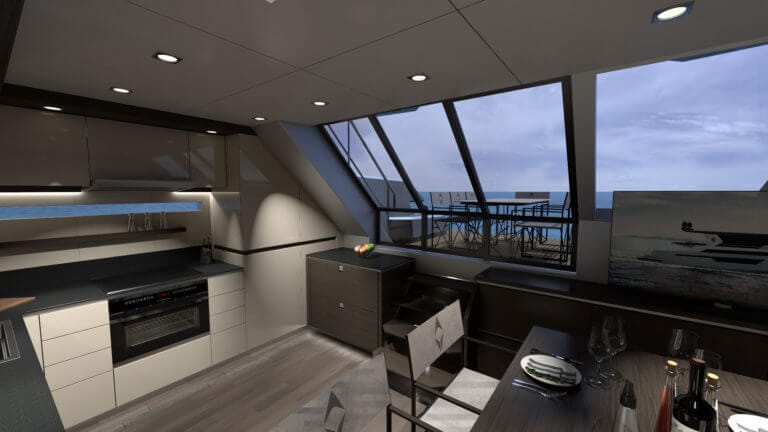
Alva Yachts - Ocean ECO 60
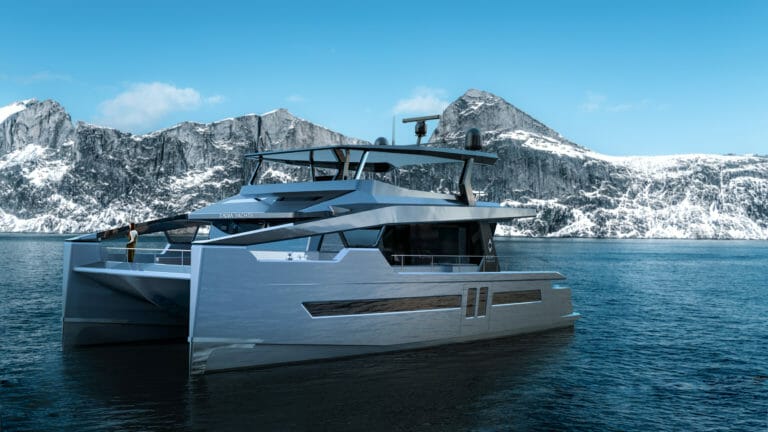
The OCEAN ECO 60 is a solar-powered electric long-range cruiser catamaran. The electric yacht’s cutting-edge technology-focused design allows you to cruise indefinitely at a comfortable speed of 5 knots without relying on shore power, as the solar panels provide enough electricity for the electric motor. However, you can add a hydrogen or diesel generator in case the clouds are ever not in your favor or if you prefer to travel at higher speeds. To complement the luxurious and pleasant design of this solar electric catamaran, you may also add a jacuzzi and a sauna to fully unwind on your yacht.
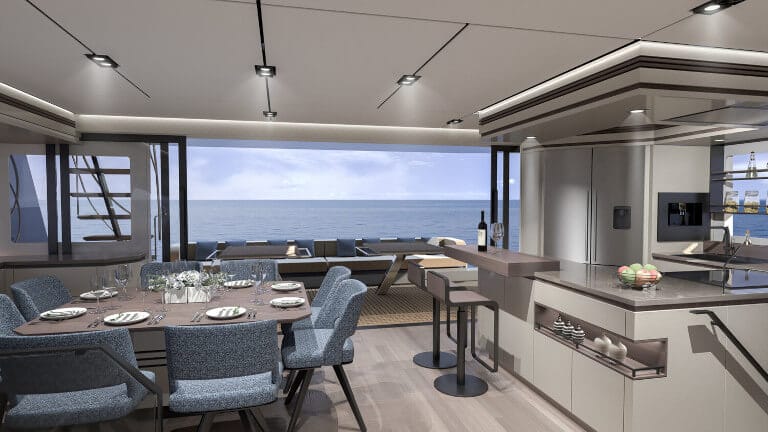
Alva Yachts - OCEAN ECO 60 EX

The only distinction between the OCEAN ECO 60 EX and the regular model is the fully enclosed flybridge.
Alva Yachts - OCEAN ECO 90
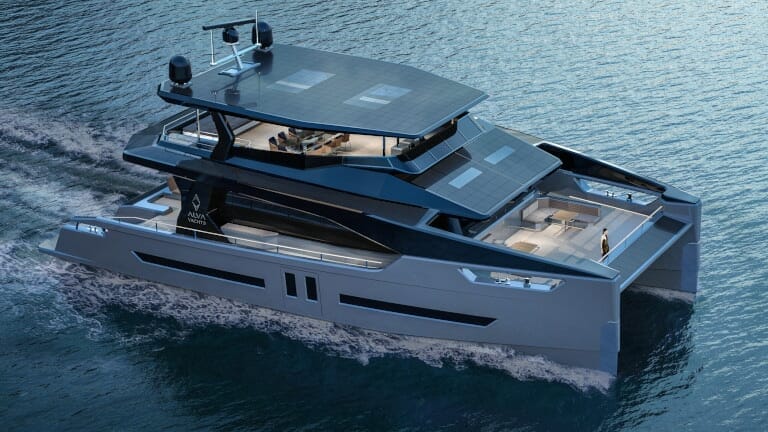
The OCEAN ECO 90 is a luxury solar electric motor superyacht that offers superbly comfortable and spacious accommodation, with an exterior and interior design that is uniquely appealing. Superyachts with electric propulsion can also feel like the next generation, as the OCEAN ECO 90 shows. With cutting-edge forms, futuristic and minimal architecture, this vessel is suited to forward-thinking clients. While the electric yacht is at anchor or quietly cruising the seas, you may leisurely sunbathe outdoors or enjoy your espresso. Alternatively, there’s plenty of room for family gatherings and parties. You may also embrace the visitors inside of the spacious, well-lit saloon.
There is plenty of room for tenders, jet skis, and other watercraft and water toys, as well as additional features, to suit your taste.

Alva Yachts - OCEAN ECO 90 EX
As for the Ocean Eco 60, the only distinction between the OCEAN ECO 90 EX and the regular model is the fully enclosed flybridge.
AQUON - AQUON One
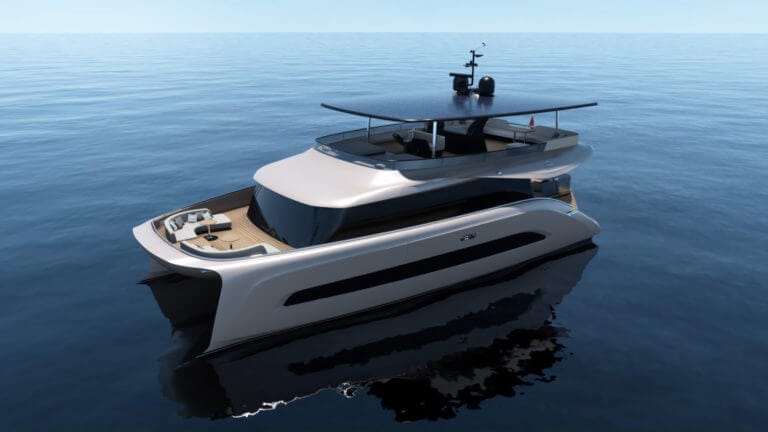
The Aquon One is a hydrogen yacht, where the energy is generated through water electrolysis. This means that hydrogen is produced with the help of the energy generated by the solar cells. The hydrogen generated is stored in hydrogen tanks and used to charge the battery bank, which powers the electric motors. The combination of hydrogen and oxygen will not only lead to impressive performance but also charge the batteries. The AQUON One can achieve a speed of 20 knots and it may travel an unlimited distance at 4 to 6 knots.
AQUON uses sustainable materials in production: Wall paneling is constructed from bamboo, some walls are constructed of a combination of flax and carbon fibers, furniture is crafted from veneer, recycled leather from shoe production is used on the main floor, sustainable Portuguese cork is used in wet areas for floor and wall coverings.
The smart yacht is outfitted with innovative communication technology and high-speed internet that enables IoT devices. Even the window shading is intelligent and adjusts to the position of the sun and ambient conditions, making it very energy efficient as less energy is needed to air-condition the vessel.
To estimate the AQUON One Price , consider the cost of similar size electric yachts in this comparison and add a good premium for electrolysis and hydrogen propulsion. Remember that with this technology you can save a lot of money.

Greenline Yachts - Greenline 39

Greenline 39 is a small electric yacht with a good space layout. The abundance of natural light inside due to the 360˚ panoramic view gives a spacious feeling on deck.
The cockpit and galley may be readily integrated into a single large social area so that you may do what you love best with the people who matter most to you. Whether you want to catch up with friends at a local island or head out for a day on the water, the Greenline 39 will get you there. With an 8 kWp solar panel output, you can go up to two days on anchor without requiring any shore energy.
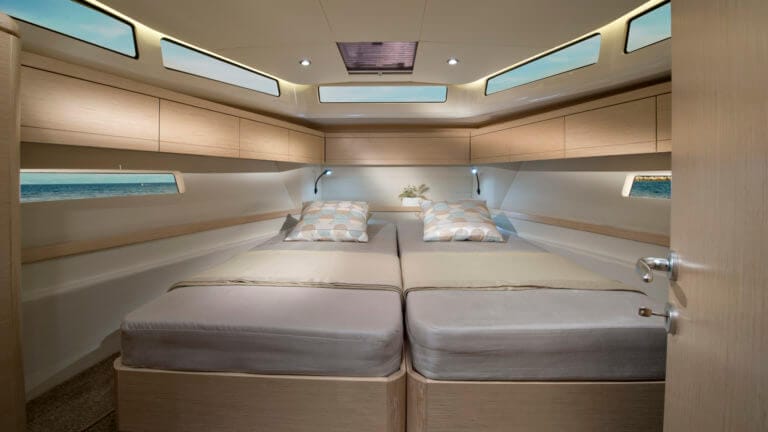
Greenline Yachts - Greenline 40

The main differences between the Greenline 39 and the Greenline 40 are the shape and the roof. The Greenline 39 has a sportier build than the Greenline 40, but the Greenline 40 has a larger roof. The larger roof provides more space for the solar cells that generate energy for the electric motors. The roof of the Greenline 40 may be opened to a larger extent than on the Greenline 39.
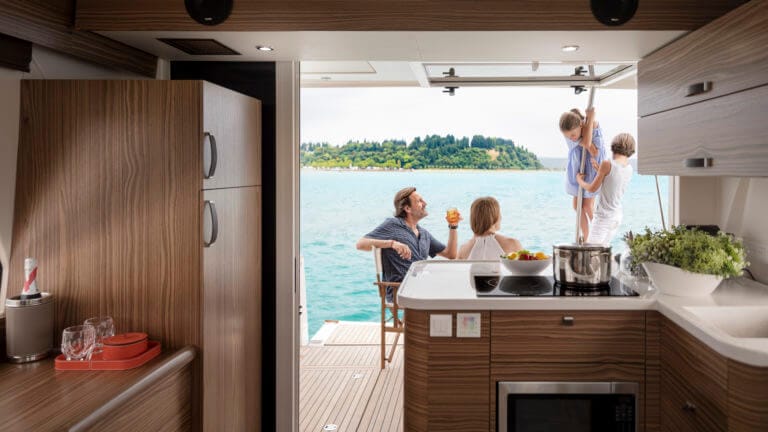
Greenline Yachts - Greenline 45
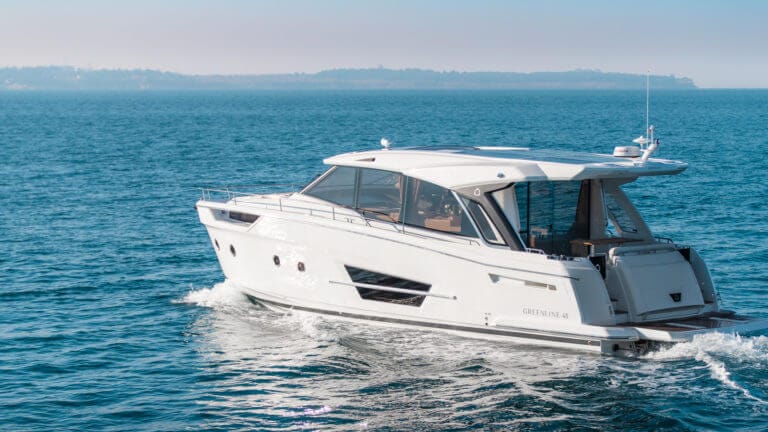
The Greenline 45 is available in two versions the Greenline 45 Coupe with a large roof and the Greenline 45 Fly with a flybridge. The Greenline 45 Coupe has a bigger roof area than the Greenline 45 Fly, allowing it to accommodate more solar panels that may power the electric propulsion with 13 kWp rather than 8 kWp. Both models have the same interior layout, giving you plenty of area for your family, guests, and a full-beam master cabin.
The Greenline 45 can travel 30 nautical miles fully electric on a single charge. It is capable of speeds of up to 13 knots and has all the facilities required for overnight cruising with up to 8 berths and 2 toilets/ bathrooms.
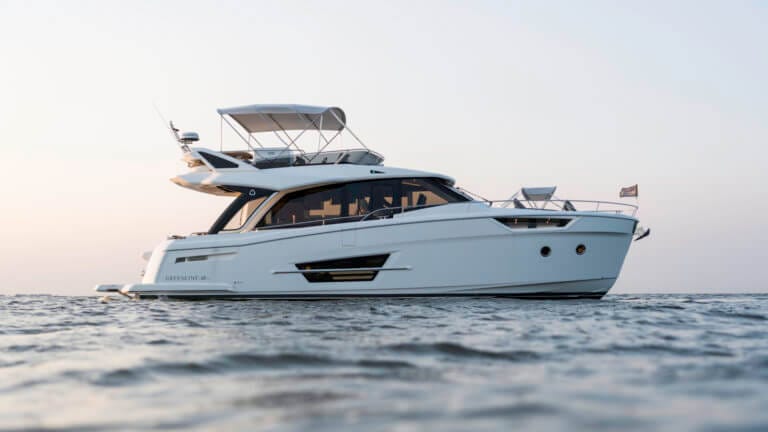
Greenline Yachts - Greenline 48
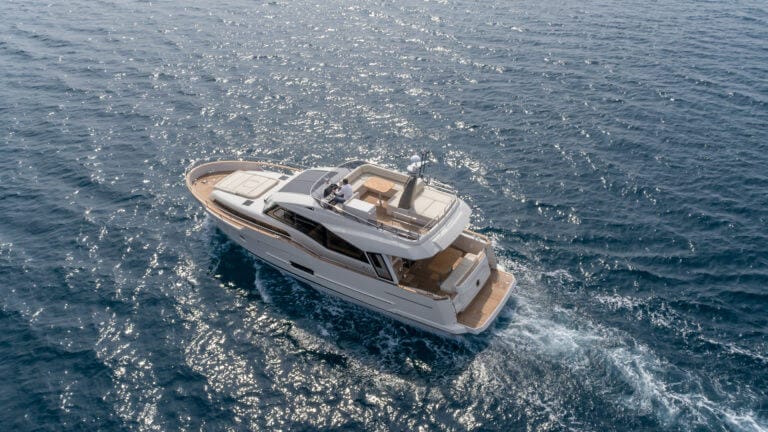
The Greenline 48 is also available in two styles: the Greenline 48 Coupe with a big roof and the Greenline 48 Fly with a flybridge. The Coupe version features 13 kWp of solar panels, compared to 8 kWp on the Flybridge model. The battery banks on both models may be charged either by shore power or from the sun. The Greenline 48 has a fully electric range of 30 nautical miles at a speed of 7 knots. The top speed of the electric version is 13 knots.
The spacious bow deck provides a great place to sunbathe with a large bathing platform at the stern. The interior is very open and provides an abundance of natural light from panoramic windows all around. The interior comes with a stunning full-beam master cabin, a walk-in closet, and a full-size freezer.

Greenline Yachts - Greenline 68
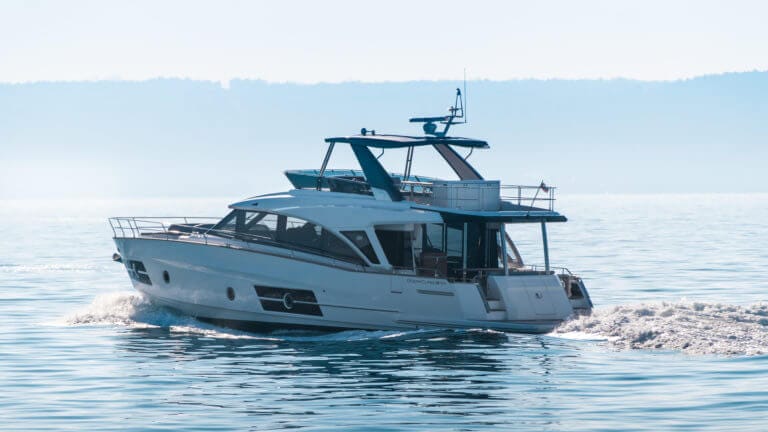
The Greenline 68 has an impressive flybridge design. This makes access to the sun deck for sunbathing or relaxation easy and provides plenty of space on the roof for solar panels that power its 12 kWp electric propulsion system. The electric version of the Greenline 68 is capable of speeds up to 10 knots and can travel 15 nautical miles on a single charge. The Greenline 68 has a range of 30 nautical miles in both its electric and fuel-powered variants. On the inside, it provides all the luxuries expected from a large yacht including two staterooms with queen size beds, two full-size bathrooms, and an open main deck plan.
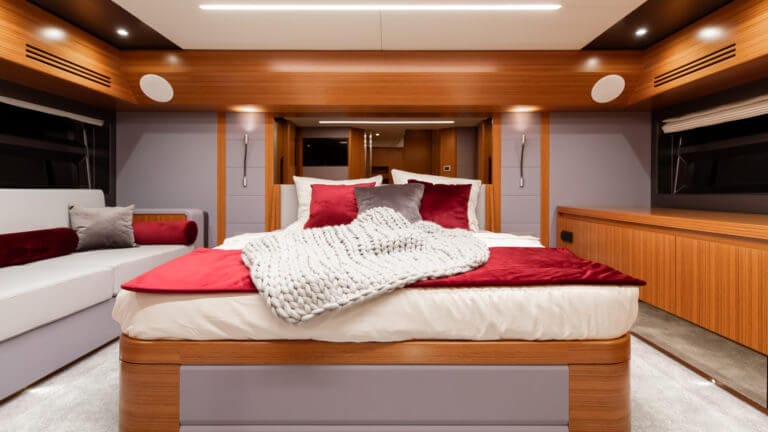
Silent Yachts - Silent 60
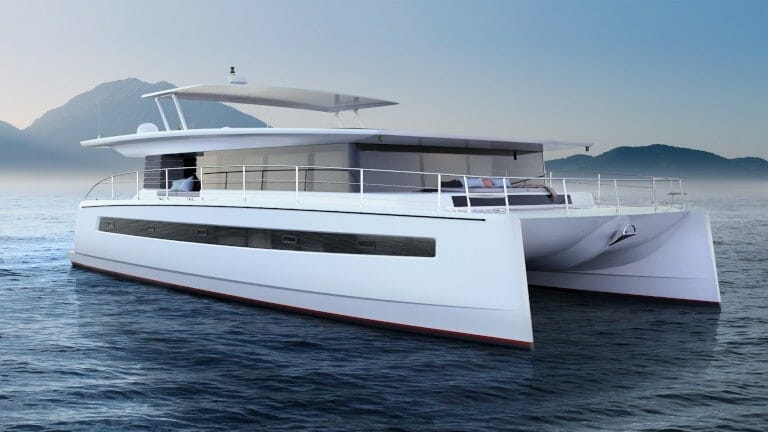
Silent Yachts is the best known electric yacht manufacturer. The founding couple has achieved this primarily by building an outstanding team, parts of which are former Tesla employees, and clever marketing. Of course, they also have an advantage due to their early involvement in the field.
The Silent 60 is the next step in the evolution of the legendary Silent 64 and won “Best of Boats” awards in the category “Best for Travel”. The Silent 60 combines all of the previous model’s finest features with improved performance, a sleek design, and lower environmental impact. It can be driven by two people comfortably and has up to 4 cabins onboard based on the version (Front Master or Front Exit). The Silent 60 has an unlimited range at low speeds. If you want it faster, you can combine the solar panels’ 17 kWp output with an automatic kite.
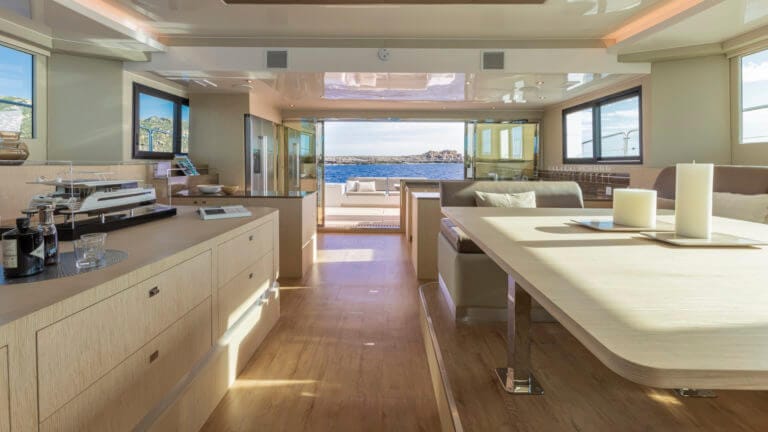
Silent Yachts - Silent 62 3-Deck
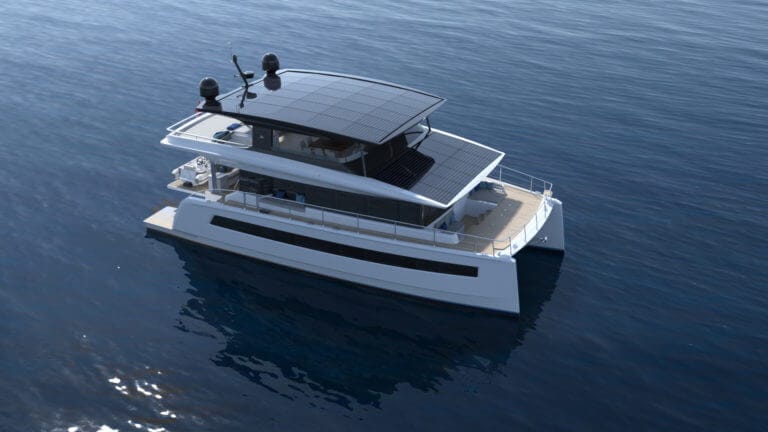
The Silent 3-Deck is the three-deck version of the Silent 60, which has two additional feet as a result of adding the deck. The Open and Closed versions of the Silent 3-Deck are two separate options. The closed-deck version has also two different variants: one with a closed sky lounge and one with an owner’s suite on the third deck. If you like the Silent 60, finding a Silent 60 or 62 that is not suitable for your needs is nearly impossible.
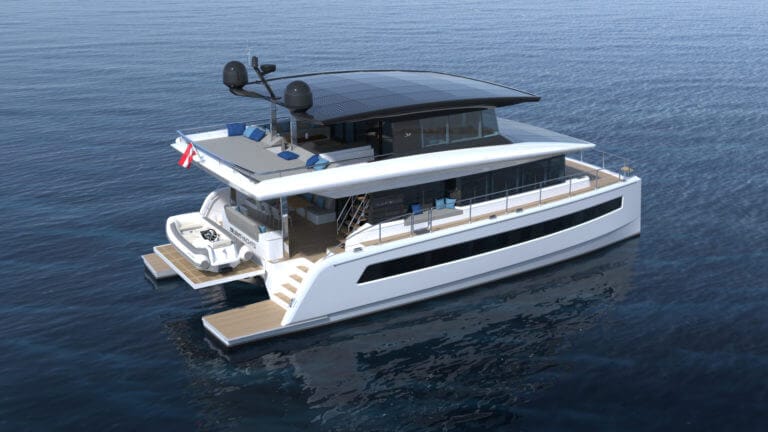
Silent Yachts - Silent 80
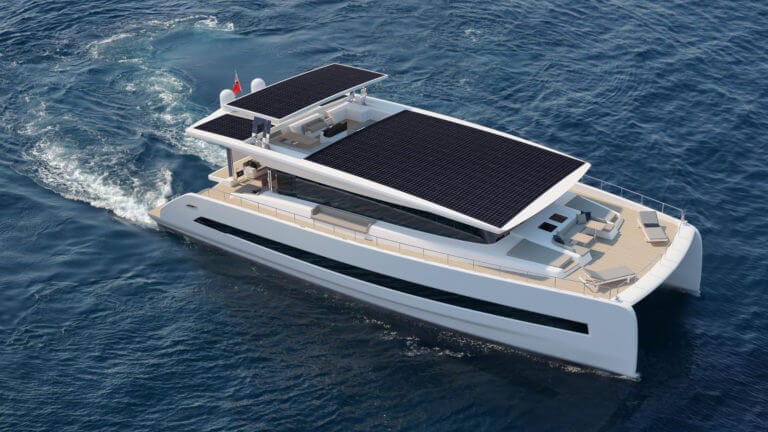
The Silent 80 offers all the benefits of the Silent 60 with even more room, so if you want to spend some quality time with even more family and friends, you might want to look deeper at the specifications of this electric yacht. It boasts an impressive top speed of 20 knots, promising a smooth ride in most conditions. The Silent 80 has all the perks of being fully electric including being silent, ecologically friendly, and with no gasoline smell or noise. The unlimited range is also impressive. The Silent 80’s open layout makes it feel roomy and our favorite spot is the flybridge with the retractable roof.
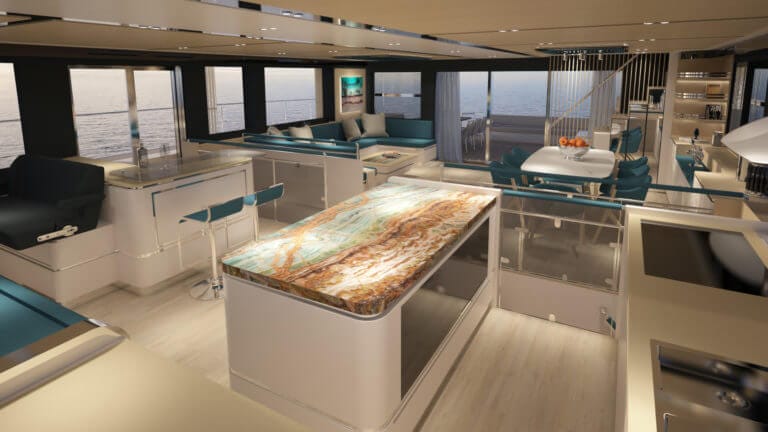
Silent Yachts - Silent 80 3-Deck
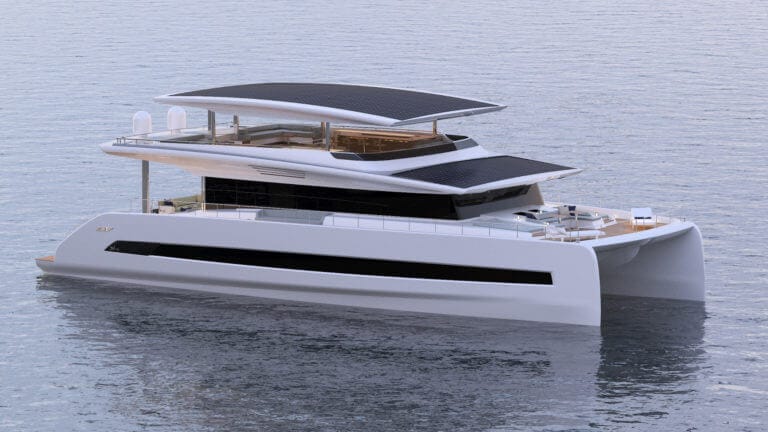
The Silent 80 3-Deck is the three-story version of the Silent 80, hence the name. It has a similar relationship as the Silent 62 3-Deck to the Silent 60, but without gaining two additional feet in length. The top deck of the solar electric yacht can be either an open sky lounge or if you choose the closed version, it can be a closed sky lounge or an owner’s lounge with a 360 view of the ocean. The 45m² sky lounge is definitely a great place to party with a huge bar and dining area.
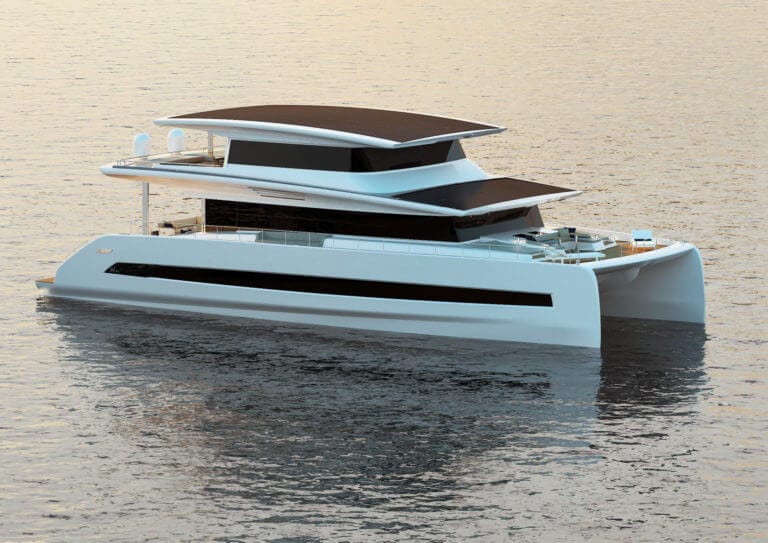
Silent Yachts - Silent 100
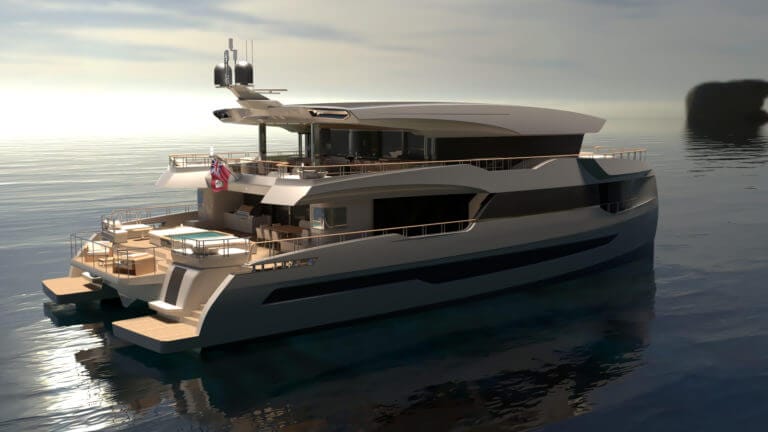
The Silent 100 is the newest flagship from Silent Yachts. It’s the biggest yacht with electric propulsion systems and a lot of cleverly placed design accents. Marco Casali, who also designed the majority of other electric yachts in the range, created this solar electric yacht. He used curves to create a timeless design with the most optimal performance possible for this size. All of the measurements are carefully placed to enhance stability even at high speeds of up to 16 knots, but also make it extremely comfortable. The Silent 100 has four decks, with the fourth one hidden beneath the retractable part of the solar roof, and on this floor is also a landing pad. The entire solar roof generates an impressive output of up to 40 kW per hour, which supplies both the onboard power and the two 340 kW electric motors.
For water toys and tenders there are also two tender garages. One between the two hulls, where can store a tender of up to 7,50m, and one smaller garage in the side-loading garage in the portside hull.
Soel Yachts - Soel Senses 48
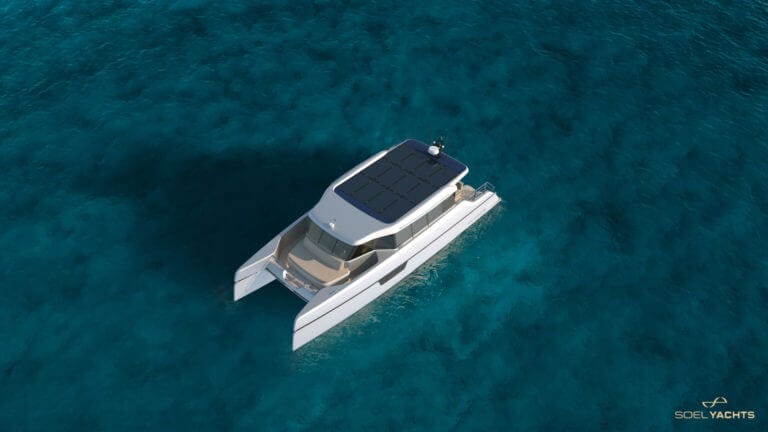
The Soel Senses 48 has enough room for up to 12 people in a comparable small, yet spacious, size of 14.50m. Each of the two cabins, one in each hull, is paired with a bathroom. A versatile sleeping area in the salon can further accommodate up to four people. The optimum cruising speed for this electric yacht is 10 knots, but you can reach a top speed of 18 knots. At 10 knots, the largest battery package can travel a distance of 56 nm. The electric propulsion system is from Naval DC (both motor and battery). With shore power, the battery pack may be charged at up to 18 kW when the 2.7 kWp output of the solar roof isn’t enough.
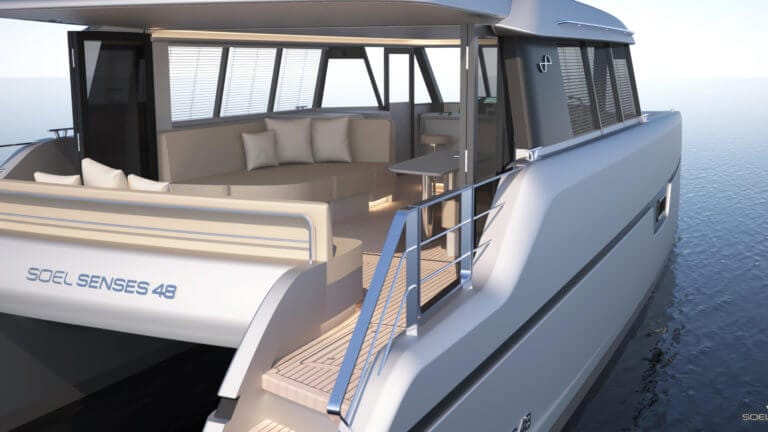
Soel Yachts - Soel Senses 62

Soel Yachts’ Soel Senses 62 is designed in a timeless style that will most likely never go out of style, like sustainability. This solar electric yacht has a dynamic elegance with refined interior design and a beautiful exterior silhouette. The salon extends almost the whole width of the vessel, allowing for lots of natural light inside. The rooms combine to form a well-integrated design that provides enough seclusion in the private cabins. A spacious master suite, two guest cabins, and a kids cabin offer plenty of space for a memorable holiday with family and friends. There’s also a separate crew cabin with its own entry. There are also optional diesel generators for longer trips, such as a trans-ocean journey, to ensure that you have enough electricity. When the conditions aren’t optimal to reach the full 17.6 kWp output of the solar panels.

Solarimpact Yacht - The SWATH Yacht
The SWATH Yacht from Solarimpact Yacht surprises with its unique shape. Not only the S.W.A.T.H hull shape, but the whole design of the yacht looks very futuristic and it is easy to see here that this is a vision. A vision that may not make it onto the water in this form, as it is, unfortunately, the case with many concept vehicles. Unfortunately, because we would like to see the vision become a reality as it brings creative design to the 80-foot electric yacht sector since most of them are just larger versions of smaller yachts.
Solarimpact Yacht - CAT 80
Compared to the SWATH yacht, the CAT 80 is a more set variant with the same length. Externally a very simple catamaran design is used, in the interior similar options are available as in the SWATH yacht. This creates elegance on a completely different basis.
Sunreef Yachts - 60 Sunreef Power Eco
Sunreef Yachts has a special approach to the placement of solar panels. This is because not only the roof is covered with solar panels, but also the outside of the hulls of the catamaran and all other non-walkable surfaces are covered. In addition, there is the possibility of equipping the yacht with wind turbines to use the energy for the electric motors. The energy is then temporarily stored in the ultra-light battery bank. They use recyclable and ethical materials (such as linen, basalt, reclaimed teak flooring or antifouling with silicon)for their ECO Line. Sunreef Yachts’ Eco line is based on the yachts with combustion engine. This not only allows Sunreef to save costs in development, but also benefits through targeted selection of Brand Ambassadors. For example, Rafael Nadal’s yacht the Great White is a 80 Sunreef Power, so not an ECO yacht like the one Nico Rosberg is getting.
See more in this video:
The 60 Sunreef Power Eco Yacht offers a solar output of 14 kWp due to the placement of the solar panels, has two 180 kW electric motors on board with a battery bank of up to 320 kW. The electric catamaran can accommodate up to 12 people and 4 crew members.
Sunreef Yachts - 70 Sunreef Power Eco
The 70 Sunreef Power Eco Yacht is the bigger version of the 60. Therefore is a lot more room in this model.
Sunreef Yachts - 80 Sunreef Power Eco
The 80 Sunreef Power Eco Yacht is the larger brother of the 70. With more length and a wider beam.
Electric Yacht FAQs
The cheapest yacht in this comparison is the Silent Yachts Silent 60 with a base price of 2.770.000,00 €. However, there are cheaper electric yachts in this comparison, but the price is not publicly communicated. Especially the smaller yachts from Greenline Yachts should be significantly cheaper. If you inquire with Greenline Yachts and the price does not match your budget, we recommend you to take a look at our electric boat comparison . Especially the boats with cabin might fit your needs and budget.
There are 8 solar powered electric yacht companies in this comparison.
Solar powered electric yachts: a great step into the future of yachting
Take a step and enjoy the advantage of solar electric yachts with zero emissions. Neither noise nor CO2 is emitted with solar powered electric yachts. A great step into the future.
If you’ve made it this far, congratulations! You have a lot of information about electric yachts and the features that are important to them. Hopefully we were able to help point out some key things for your next purchase so you can get exactly what you need. But don’t forget – if there’s anything else not mentioned in our blog post that you’re wondering about or want more information on, feel free reach out with any questions at all! We’ll be happy to answer them as best we can.
Dynamic title for modals
Are you sure.
Automated page speed optimizations for fast site performance
Based in la ciotat shipyards
the maritime cluster leader in the Mediterranean
We support you on
technical expertise, basic design, detailed design, realization
Official dealer of
project management
of complete systems during the building of a yacht
of complete systems during the overhaul of motor yacht
custom works
on motor yachts
technical expertise
from SuperYacht to MegaYacht
30 years of expertise
a “must level” of quality
Marine Electricity, Water Treatment, Power Generation, Refrigeration & A.C.

Marine Electricity
Design, overhaul of any type of electrical, electromechanical system and automatic devices, with Cantalupi for lighting.

water treatment
Sales, installation, full maintenance of watermakers with HEM for luxury yachts and SLCE for commercial vessels.
power generation
Sales, installation, maintenance with Nothern Lights for generators and Mastervolt for power systems.

refrigeration & ac
Sales, installation, maintenance, complete overhaul of heating, ventilation, AC and refrigeration systems.

Thanks to our know-how in
Electricity | Electro mechanics | Automation | Command Control
… we support you on
Basic Design | Detailed Study | Realization | Measures, controls
… applying rules of project management
Estimate | Planning | Budgeting | Cost control
case studies
Project management of complete systems during the refit of a motor yacht, making custom works on yachts (50k€ to 1000k€), project management of complete systems during the building of a yacht, technical expertise, in many units of 40m to 130m, some references.
ALFA NERO | 269.03ft / 82m AMEVI | 262.48ft /80m ANASTASIA | 247.70ft /75.5m C² | 255.90551ft /78.43m DB9 | 170.60ft /52m DRUMBEAT | 173.8845ft /53m EXUMA | 163.71ft /49.9m FAITH | 203.41207ft /62.3m FOUNTAINHEAD | 285.433071ft /87.78 m HURRICANE RUN | 175.52ft /53.5m
KOGO | 236.22ft /72m LIBERTY | 160.76115ft /49.95m MAGIC CARPET 3 | 98.425197ft /30.48m MIRABELLA V | 246.06ft /75m MUSASHI | 287.99ft /88m NETANYA 8 | 190.289ft /58m NIRVANA | 290.35ft /88.5m OCTOPUS | 414.04ft /126m PANTHALASSA | 180.4462ft /55.90m PELORUS | 377.297 /115m
QUEEN K | 203.412ft /62m RISING SUN | 452.7559ft /138m SARAFSA | 269.029ft /82m SKAT | 231.9554 /70.70m SLIPSTREAM | 196.85ft /60m SPIRIT OF THE C’s | 209.97ft /64m TATOOSH | 301ft /92m TIARA | 177.1654ft /54.3m WALLY B | 111’10″ft /34.10m Y3K | 98.4252ft /30.50m
testimonials
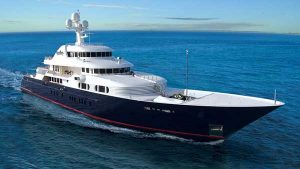
MARKKU, Chief Engineer
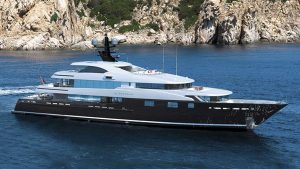
PHIL, Captain

TYLER, Chief Engineer
- First Name *
- Last Name *
- Boating State * Outside US / Canada Alabama Alaska Alberta Arizona Arkansas California - North California - South Colorado Connecticut Delaware District Of Columbia Florida - East Coast Florida - West Coast Georgia Hawaii Idaho Illinois Indiana Iowa Kansas Kentucky Louisiana Maine Manitoba Maryland Massachusetts - North of Boston Massachusetts - Boston and South Michigan Minnesota Mississippi Missouri Montana Nebraska Nevada New Brunswick New Hampshire New Jersey - North of Sandy Hook New Jersey - South of Sandy Hook New Mexico New York - Great Lakes New York - Coastal North Carolina North Dakota Nova Scotia Ohio Oklahoma Oregon Pennsylvania - East Pennsylvania - West Puerto Rico Rhode Island Saskatchewan South Carolina South Dakota Tennessee Texas Utah Vermont Virgin Islands Virginia Washington West Virginia Wisconsin Wyoming
- Comments This field is for validation purposes and should be left unchanged.
Dasher Electric
The future is here. Since 1928, Hinckley has been leading the way in the design of beautiful, highly innovative, and timeless yachts. In 2017, Dasher Concept launched as the world’s first fully electric luxury yacht.
The Dasher story started in 2016 in the wake of a Hinckley-sponsored technology summit to discuss the future of yachting. This gathering of futurists included entrepreneurial leaders, accomplished engineers, and known innovators from all over the world. The final decision to develop a concept boat with Zero-Emmissions, bleeding-edge construction techniques, 3D printing, and an unparalleled operator interface paved the way for advancements across the entire Hinckley product line. Today, All Hinckleys benefit from simplified digital interfaces, infused carbon epoxy construction among other advancements inspired by the Dasher Concept.
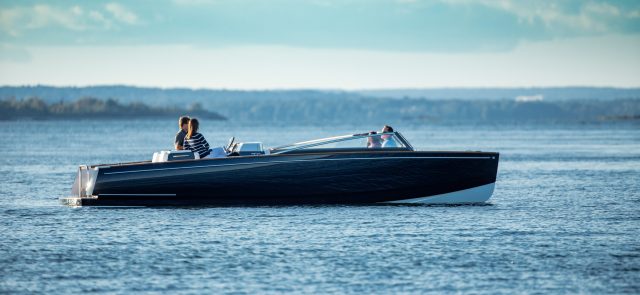
The shape of the future.
Designed from the ground up for fully electric propulsion, Dasher achieves a new standard of excellence with modern styling paired with super lightweight construction. From her carbon-epoxy composite hull, to her hand-painted, lightweight Artisanal Teak, every ounce of weight has been shaved and every curve sculpted.
The sound of silence.
Arriving not with a roar, but with our silent Whisper Drive propulsion system powered by dual BMW i3 lithium ion batteries, the shape of the future is also the sound of silence. The result is a serenity not easily found. Time to reconnect with friends and family, sharing a conversation and enjoying quiet, quality time together. With zero emissions and zero time lost traveling to the pump and back, it’s not what we’ve added to Dasher but what we’ve removed that you’ll love most.
Simple, Innovative, Sophisticated design.
Dasher is the lightest Hinckley Yacht ever created. With a carbon-epoxy composite hull and carbon stringers, Dasher is light and sleek, bringing together performance and propulsion like never before.
BMW i3 Waterproof Lithium Ion Batteries
BMW i3 lithium ion batteries have been designed with a prismatic cell design for efficient cooling and temperature distribution with compact size and superior shock resistance.
Twin 80hp Electric Motors
The shape of the future is also the sound of silence. Quiet propulsion and zero emissions make Dasher the best way to spend time on the water with family and friends. This is the heart of the world’s first fully electric luxury yacht.
Dual 50 Amp Dock Charging
Say goodbye to the tank — and all that comes with it. Dasher accepts dual 50amp charging cables so you can charge twice as fast as the most popular plug-in electric cars. Dasher gains a full charge in under 4 hours with dual 50 amp charging.
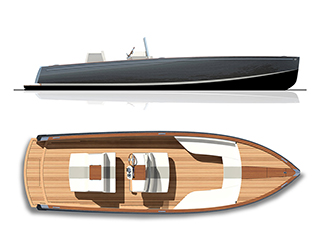
* All performance data, including speeds, fuel consumption and range, is estimated and not guaranteed. Actual performance may vary. Boat performance may be impacted by many factors including, but not limited to, loaded displacement, boat configuration and options, trim, sea conditions, climate, hull bottom, surface condition and mechanical systems condition
Images and media on this page may represent optional equipment or previous specifications. Specifications and equipment are subject to change.
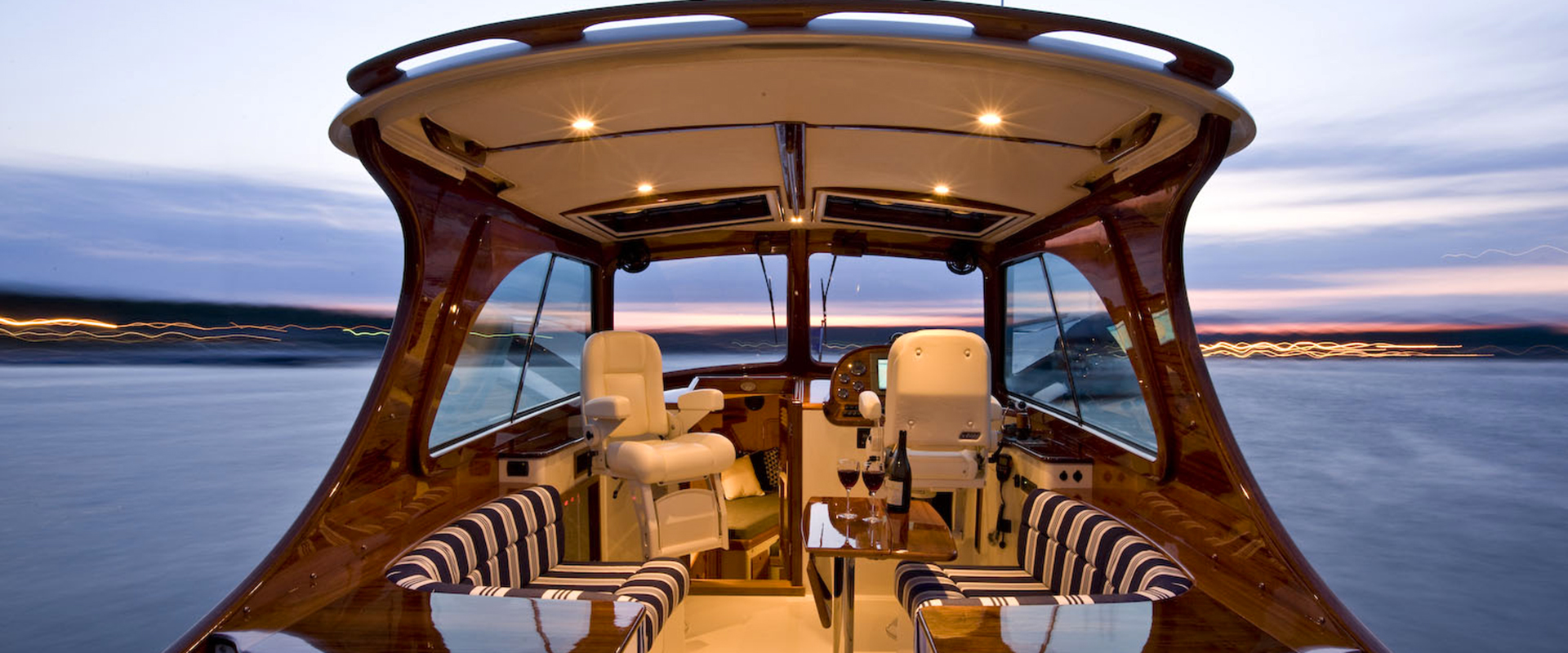
Explore Our Picnic Boat Models
VIEW MODELS
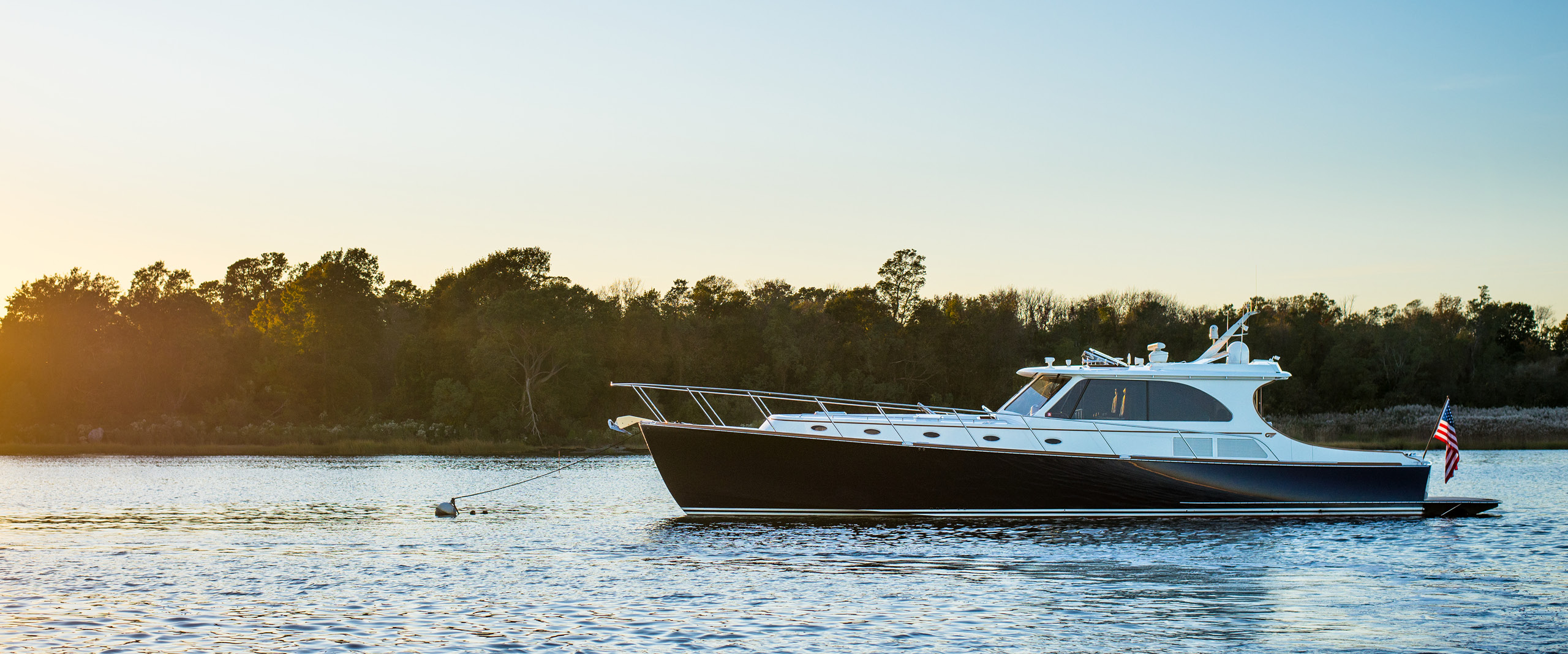
Explore Our Motor Yacht Models
The Pros, Cons, and Future of Electric Yachts and Sailboats
- By Sail Greener
- Last updated: April 27, 2022

Sail Greener is supported by our readers. When you buy through links on our site, we may earn an affiliate commission.
If you sail you likely spend considerable time—and money—cleaning, fixing, and worrying about your diesel or gas engine. When it comes to safety, your backup propulsion is as important as your sails. Can you rely on electric motors for safety? What are the pros and cons of buying an electric sailboat?
Diesel engines are reliable, but they pollute. Diesel (and gas) engines emit greenhouse gasses and exhaust that includes particulate matter and carcinogens that are a risk to human health.
Until recently, alternatives to marine diesel engines were limited. Boat owners could carry out their own repower projects or purchase expensive commercial electric motors. Storage capacity was a problem.
Fortunately, the winds are shifting and there are now numerous high quality and economically competitive alternatives to traditional marine engines. In this article we describe the pros and cons of purchasing a new motor or repowering an existing engine. We also describe the market for marine electric propulsion systems and identify leading boat builders, manufacturers, and installers.
Why do we need electric sailboats?
The climate is warming and we continue to pump greenhouse gasses into the atmosphere at a torrid pace. Transport emissions, including road, rail, air and marine transportation, account for nearly a quarter of global CO 2 emissions. 1 https://www.ipcc.ch/report/ar5/wg3/transport/ According to the United Nation’s International Maritime Organization , marine traffic accounts for nearly 3% of the world's CO 2 emissions.
While emissions from recreational boaters are less than those from shipping and fishing fleets, they are still considerable. According to an estimate from electricmotoryachts.com , if just 5% of the roughly 13 million registered boats in the United States today repowered with electric, boaters would eliminate an estimated 1 billion pounds of CO 2 emissions. Scaled across boaters around the world, the potential for boaters to meaningfully reduce greenhouse gas emissions is significant.
Exposure to diesel emissions also poses health risks. The smallest particulate matter can contribute to heart attacks, strokes, and lung disease. High exposure to small particulates can impair brain development in children. The International Agency for Research on Cancer , part of the World Health Organization (WHO), classifies diesel engine exhaust as carcinogenic to humans.
Is there a market for marine electric propulsion?
Global concern over climate is leading to a revolution in how we produce and use renewable energy. This is particularly true in the transportation sector. Sales of electric cars in 2019 increased 40%. In 2020, Tesla motors alone produced almost 500,000 new electric vehicles. This helped to propel Elon Musk to become the world’s wealthiest person. Electric vehicle penetration is still just about 3% but growing dramatically 2 https://www.mckinsey.com/industries/automotive-and-assembly/our-insights/mckinsey-electric-vehicle-index-europe-cushions-a-global-plunge-in-ev-sales# A key factor driving this growth, according to the European Patent Office (EPO) and the International Energy Agency, is innovation in rechargeable lithium-ion batteries and other storage technology. Batteries now account for nearly 90% of all patenting activity in the area of electricity storage. Between 2005 and 2018, patenting activity in batteries and related electricity storage technologies grew four times faster than the average of all technology fields. 3 https://www.iea.org/reports/innovation-in-batteries-and-electricity-storage
It is clear we are reaching a tipping point for electric automobiles and trucks 4 https://www.theguardian.com/environment/2021/jan/22/electric-vehicles-close-to-tipping-point-of-mass-adoption . Is the marine sector also experiencing an electric revolution?
The market for marine electric propulsion systems is lagging what is happening with cars and trucks. However, the potential for growth in this sector is extraordinary. In an article published in Yachting World, Christoph Ballin, CEO of electric motor manufacturer Torqueedo, estimated that only about 1.3% of marine propulsion systems are electric. 5 https://www.yachtingworld.com/features/future-yachting-smart-technology-126136 According to an article published in 2017 by IDTechEx there are over 100 manufacturers of electric boats and ships with an estimate of more than $20 billion in global sales by 2027 for non-military boats. According to the IDTechEx report, recreational boats are the largest—and fastest—growing electric marine market by sales.
The growth potential is enormous considering the size of the recreation economy. In the United States alone, in 2019 outdoor recreation generated US$ 788 billion dollars in output. 6 https://boatingindustry.com/news/2020/11/12/orr-provides-breakdown-of-latest-recreation-economy-data/ An estimated $37 billion of this came from retail sales of boats, engines, accessories and marine services. According to the U.S. Bureau of Economic Analysis (BEA) Outdoor Recreation Satellite Account (ORSA) data, Boating and fishing was the largest conventional activity for the nation as a whole, adding US$ 23.6 billion to the economy. This was the largest conventional activity in 30 states and the District of Columbia and the second largest activity in 11 states. 7 https://boatingindustry.com/news/2020/11/12/orr-provides-breakdown-of-latest-recreation-economy-data/
Pros and Cons of Electric Motors for Boats
What are the pros and cons of electric motors for sailing?
Pros of electric propulsion
- Less noise : Electric motors are quieter than diesel engines and nearly vibration free.
- Lower long-term cost : Motors last a long time and require no fuel. You need batteries and electricity, but the sun and wind can recharge your batteries. You won't need to constantly change engine fluids, filters, or worry about leaks or old tanks.
- Cleaner and healthier: You won't end up with an oily mess in the engine room and bilge
- No emissions, no exhaust : Passengers and crew won't be exposed to hazardous fumes and particulates. You won't be spewing out carbon pollution.
- Instant power: Electric motors can go from zero to full torque instantaneously. Motors do not need to wait for engines to warm up.
- Weight and storage : Electric propulsion systems are typically less heavy than equivalent diesel systems. OceanPlanetEnergy.com estimates that electric propulsion systems are typically 1/3 the weight of diesel systems. This depends, however, on the weight of your battery bank.
- Easier maintenance and lower costs: Electric motors are simpler and easier to maintain than diesel generators. OceanPlanetEnergy.com estimates that maintenance costs could be 1/20 of the maintenance costs of a diesel engine in the first decade, even less over time because of electric propulsion systems use far fewer moving parts.
- Increased reliability and safety : Fewer moving parts translates into fewer breakdown which means which means more safety.
- Regeneration: Batteries can be recharged while sailing using, solar, wind, and hydro generation systems. For example, at sailing speeds over 6 knots Oceanvolt systems are reportedly able to generate significant power for recharging the battery bank.
- Improved maneuverability: Electric motors have high torque at low RPM, which can make maneuvering in tight spaces like marinas more precise. Electric motors can switch from forward to backward instantaneously.
Cons of electric propulsion
- Range anxiety: Depending on your battery bank and ability to recharge, you may have less range with an electric motor compared to a diesel engine.
- Cost: Electric motors can be expensive relative to combustion engines, but costs are plummeting.
- Lack of familiarity : Sailors familiar with traditional engines may not feel prepared or comfortable to switch to a new form of power.
- Fires: There can be a small risk of fires from batterie with improper maintenance, but this is also true with internal combustion engines.
- Charging time: Recharging batteries can take time, but charging times are changing quickly. Tesla V3 Superchargers support peak rates of up to 250kW per car, which translates to about 75 miles of charge in 5 minutes for a Model 3 and charge at rates of up to 1,000 miles per hour 8 https://www.tesla.com/blog/introducing-v3-supercharging . In January 2021 the Israeli company StoreDot announced new “exreme-fast-charging” lithium-ion batteries that could charge a car battery capable of 100 miles of charge in 5 minutes. It will only be a matter of time before similar speed and capacity is available for boaters.
Industry Leaders
Who are industry leaders in the electric sailboat space?
Electric propulsion companies
Numerous companies produce electric and hybrid propulsion systems for the marine sector. Some of the best known and highest quality brands that provide electric propulsion systems for yachts and sailboats include:
- Elco Motor : Elco is one of the industry leaders in this field. The company has been around for more than 125 years and now produces a wide range of outboard and inboard electric and hybrid propulsion systems.
- OceanVolt : The Finnish company is one of the industry leaders in electric propulsion. The company produces a wide range of electric propulsion systems for monohulls and multihulls. The company has provided cutting-edge electric propulsion systems for Vendée Globe racers, including Alex Thompson’s Hugo Boss and Conrad Colman in 2017, and other racers like French Olympic sailor Damien Seguin.
- Torqeedo : When Torqeedo was founded in 2004, concepts like “clean tech” and “electromobility” were just a glimmer in Mother Earth’s eye. One of the pioneers in the modern marine electric propulsion sector, Torqeedo is now one of the market leaders. The company offers outboard and inboard electric motors and hybrid drive systems ranging from 0.5 km to 100 kw in addition to diverse accessories from lithium batteries and solar charging equipment to smartphone apps.
- Aquamot : This German company produces in-house electric propulsion systems for electric for boats and ships, including motors, batteries, and chargers.
- Kraeutler Elektromotoren produces a wide range of industrial, ship drive, and boat motors, including drive units for motor and sailing boats.
Electric sailboat manufacturers
Who builds sailboats with electric motors?
Electric propulsion is going mainstream. Dozens of boat builders are building electric-only boats (like SoelYachts.com and Silent-Yachts.com ). Some traditional yacht builders now offer electric propulsion options—and this will likely grow to include all major manufacturers in coming years. Examples of leading yacht manufacturers that include electric propulsion options include:
- Arcona Yachts : A leading builder of high quality yachts from Sweden, Arcona is starting to offer high quality zero-emission models, such as the Arcona 415 .
- Alva Yachts : The German luxury electric yacht brand has designed both mult-hull (non-sail) and monohul (sail) boats. The company’s 25-m Ocean Sail 82 was designed with a hybrid propulsion system and a high capacity battery bank.
- Baltic Yachts : The Finish producer of luxury yachts and a world leaders in advanced composite yacht building in 2020 selected Oceanvolt for the company’s 68-foot Café Racer manufactured in Finland. The Javier Jaudenes designed boat is just over 20 meters long and 5.5 meters wide.
- In 2001 Elan Yachts and Oceanvolt agreed to partner to build a full range of electric-powered yachts ranging from the luxurious GT6 to the the sporty E-Line performance cruisers.
- Hanse Yachts : The world’s third largest boat builder, Hanse produces the Hanse 315, which includes an electric rudder-drive option.
- Salona Yachts : A Croatian boatbuilder, Salona builds the Salona 46, a fast, comfortable, and luxurious electric yacht and winner of the Best Green Boat Award at the Newport International Boat Show .
- Sunreef Yachts Eco : A manufacturer of luxury bespoke multihulls, Sunreef Yachts Eco catamarans are equipped with composite-integrated solar panel systems and lightweight batteries for energy efficiency and environmentally-conscious luxury cruising.
- Wally : The Dutch yacht builder produces, among its many other models, the 11.35 meter Wallynano MKII, which relies on an OceanVolt electric propulsion system
- Zen Yachts : A new company established in 2021, Zen builds what it claims is the world's first series production catamaran equipped with a wingsail.
Electric conversion companies
Who can help me convert my sailboat to electric propulsion?
A growing number of companies are dedicated to helping boat builders and individuals convert their yachts. These companies may provide design and support options for advanced battery systems, solar and wind systems, hydrogenation, and overall system design. Some of these companies produce their own electric motors and systems. Leading companies in the field include:
- OceanPlanet Energy : This company includes some of the giants of the industry. Bruce Schwab was the first American to officially finish the Vendee Globe. Nigel Calder is one of the best known sailing technology writers, including his must-read classic, Boatowner’s Mechanical and Electrical Manual. The company provides energy storage, charging, and monitoring systems; system design and consulting.
- Electric Yacht : The Minnesota, USA-based company with the eponymous name supports sailors interested in electric propulsion systems. The company helps boaters design and size system and provides motor kits, batteries, chargers, and other components. The company provides examples of conversion projects on its website.
- e Marine Systems specializes in distributing solar panels, wind generators, electric propulsion drives, inverters, and energy storage systems. The company is located in Fort Lauderdale, Florida, USA.
- Naval DC produces both “pure” solar and hybrid electric systems ranging from 10 kW to 1 MW. The company provides lithium battery solutions, data and monitoring systems, electric propulsion, and matched propeller systems.
Yacht dealers
A small but growing number of yacht dealers offer new and used electric boats. Green Yacht Sales is an example of a small company that supports the sale of electric yachts and systems from diverse manufacturers.
Global clearinghouses, like YachtWorld and Boat Trader , now provide options to filter searches for electric propulsion sailboats.
Battery technology and companies
Until recently, the amount of energy batteries could store was limited. The cost of buying a new battery bank was prohibitive for most sailors. Today, however, costs are dropping and batteries provide more charge. Range anxiety remains one of the biggest reasons sailors don’t want to swap out polluting diesel engines for quieter and cleaner all-electric systems. However, this concern will soon be obsolete.
There are many high quality marine battery suppliers. Some of the major players in the LiPO market include:
- ChargeEx Lithium Ion Batteries
- Dakota Lithium
- Dragonfly Energy
- Victron Energy
Successful Examples
Okay, this all sounds good in theory, but is it really possible to throw out your old engine and install a new motor? Here are a few examples of individuals and companies making the switch to electric yachts.
As with many disruptive technologies, it is easier for wealthy individuals to pay more—often much more—for tomorrow’s technology today. That said, these Super Early Adopters are a harbinger of things to come. These individuals may be risk takers but they are also typically really smart and forward-thinking.
Swedish billionaire Niklas Zennstrom is one example of a pioneering “mogul” in the electric yacht world. The founder of Skype and former Time Magazine 100 Most Influential People awardee, in 2018 Zennstrom’s team launched Rán VII. Yachtingworld described the boat as “…so angular it calls to mind Darth Vader or a Stealth bomber.”
Zennstrom shared his views on the future of electric racing in a CNN article in 2018:
“Having gone through the design, build and initial test cycle there is no doubt to me that the future for racing yachts is electric propulsion. It's lighter, less drag, quieter, and most importantly it is environmentally friendly.”
Do-it-yourselfers have been converting electric sailboats for years. The mainstream boating magazines and the media are increasingly showcasing the stories of these sailors retrofitting their boats. A few examples of well-publicized electric yacht conversion stories include:
- In 2019 Yachting World wrote an article, “How hybrid sailing yachts finally became a feasible option.”
- Dufour 382: According to an article in Yachting World , the owners Alcyone , a Dufour built in 2016, was retrofitted with an Oceanvolt SD15 saildrive moto r.
The future of electric sailboats
We are facing a climate emergency and the world is mobilizing to reduce emissions of greenhouse gasses. A growing number of boat builders, engine and battery producers, service companies, and individuals are addressing this need by building and retrofitting emission-free sailboats. We are still in the early stages of this transformation, but change is coming quickly.
Some of the major challenges—and opportunities—for catalyzing this transition in coming years include:
- Battery storage, charging, and cost: The pace of technology change in the battery sector is dizzying. The amount of charge, the time to charge, and the price per kilowatt of battery storage systems are all improving. Superchargers are already widespread on land. How long will it take for marine supercharging stations to fill the world’s marinas?
- Overcoming tradition : Sailors who have used the same technology for decades may hesitate to switch to new technology. Sailors used to heavy yachts and small batteries may look with skepticism on this new technology. Range anxiety is very real in the middle of the ocean.
- Cost : As with any new technology, early adopters may have to pay more. The cost of electric propulsion, solar and wind power, and battery storage are dropping quickly. Cost will soon be less of a concern and may become a clear benefit.
- Retrofits: Many boats still sailing form 1960s and 1970s so 50 years of old boats locked in. But this is also an opportunity for individuals and companies who are willing and able to take this space
- Manufacturing: making boats expensive and companies may not want to take risks. But new companies are emerging, and the major yacht companies now coming out with electric options (examples).
We are at the dawn of a new age of sailing. With each passing month electric propulsion technology is improving. Motors are getting better, batteries and solar panels are getting cheaper, and electric sailboats are starting to become mainstream.
Finding more information
If you want to learn more about healthy products, check out The Sail Greener Guide to Healthy Sailing . If you want to learn more about who is working to conserve the ocean, see our list of The Best Ocean Conservation Organizations for Sailors .
- Sail Greener
- Originally Published: February 26, 2022
Table of Contents
- climate , diesel engine , electric motor , environment , sailboat , yacht
Like this post? Share with friends and colleagues!
Related articles.

Climate Change and the Future of Sailing
Earth’s climate and oceans are changing. What does human-induced climate change mean for the future of sailing?

Green Boat Shows 2022
What major international boat shows promote green events or themes? Check out our calendar of 2022 International Boat Shows to find out!

Quiz #1: Ultimate Sailing Logo Quiz
Sail Greener Quiz #1: Ultimate Sailing Logo Quiz

Electric Yachts for 2022
A growing number of boat builders are joining the electric yacht revolution. What are some of the best eco-friendly sailboats and catamarans for 2022?

Best Yacht Charter and Boat Share Companies for Sustainable Sailing
Looking for the best yacht charter, boat share, or boat rental company that has eco options? What is the size and growth potential of the green yacht charter market? Check out the latest on eco yacht charters.

The Sail Greener Guide to Toxic Products and Health
Hazardous chemicals and compounds are used to build and maintain sailboats. Learn how you can use non-toxic alternatives to reduce your exposure to toxic substances and risks to your health and the health of the environment.

The Best Ocean Conservation Organizations for 2022
Are you concerned about the the world’s oceans and want to help? Check out the Sail Greener guide to the world’s best ocean conservations organizations!
Recent News: Boats and Gear

Orcas attack The Ocean Race
(June 22, 2023; Day 8) – As the final leg of The Ocean Race passed along the western shore of Europe before turning in to

This Sleek 80-Foot Electric Catamaran Uses Solar Power to Cruise With Infinite Range
The zero-emissions multihull sports an innovative solar skin that continuously generates power at sea….click HERE to read the rest of the article from the ORIGINAL

Exhibitors and Events at Electric Boat Show Milan 2023
The second Electric Boat Show is taking place at the Idroscalo in Milan this weekend and has a wide range of electric boat exhibitors and

Historic sailing ship starts first cargo service across Europe
De Tukker, the first ship operated by Dutch sustainable shipping company Ecoclipper, has set sail on the firm’s maiden voyage — 111 years after it

Francis Joyon “The great way to limit your carbon footprint is to have a very small budget”
On the occasion of Francis Joyon’s stopover in the city of Marseille, we went to meet him to discuss The Arch project and his vision

An art contest to invent the sailing ship of the future
The association Windship launches a contest for children to imagine the sailing ship of the future. A great opportunity for sailors, artists and inventors to
World tour for model boat inspiring citizen science against environmental pollution
A model sailing boat which represents a key part of a project working to banish single use plastics has embarked on a global tour that
Torqeedo more than doubles warranty to 5 years on Travel electric outboards
Torqeedo announced today that it is introducing a new, industry-leading warranty that more than doubles the existing warranty from two (2) to five (5) years

Solar panel: how to choose the right one for your boat?
More and more harbors are forbidding the use of electricity when you are not on board, for reasons of economy, ecology and safety. So how

Life in ocean’s twilight zone ‘could disappear’ amid warming seas
Less food is falling to dimly lit waters, home to specially adapted marine life – but emissions cuts would stem decline Life in the ocean’s

Oceanvolt Servoprop, now available for large boats
Distributed by e-Nav Systems, the Oceanvolt electric motorization solutions are completed with a complete propulsion system available for sailboats up to 70 feet or 25

Spirit Yachts goes all-electric for Southampton Boat Show
Yacht designer and builder Spirit Yachts will be displaying two electric drive sailing yachts at this year’s Southampton International Boat Show from 16-25 September 2022.
More News...
An updating news feed on the latest about sustainable sailing. Check out the following topics: - Boats and Gear News - Products and Apparel News - Oceans and Environment News - Charter and Travel News CHECK THE LATEST NEWS...
Looking for book recommendations for maintaining your boat, ocean science and conservation, adventure, and other good reads? BROWSE BOOKS...
Current Weather!
Need to high quality weather data for wind, sun, tide, and more? Check out the latest with our detailed global weather map VIEW CURRENT WEATHER!...
So many videos, so little time. We do the work to put useful green sailing videos in one location. CHECK OUT THE VIDEOS...
More Resources
A curated list of helpful web pages and links to keep you learning about Sailing Greener.
Sign up for FREE email updates
Boats & gear news, products & apparel news, from seahorse earrings to jellyfish brooches: this ocean-inspired high jewelry is swimming in style, bendy solar panels are just as good as regular ones, societal cost of ‘forever chemicals’ about $17.5tn across global economy – report, seajet, a range of antifouling products for a cleaner and more eco-responsible hull, first sustainable and recyclable optimist launched, charter & travel news, hawaii fires: a visual guide to the explosive blaze that razed lahaina, ‘huge’ coral bleaching unfolding across central america prompts fears of global tragedy, biden administration’s gulf of mexico offshore wind sale on the horizon, clean me a river: southeast asia chokes on mekong plastic pollution, florida rocked by home insurance crisis: ‘i may have to sell up and move’, archipelago, a finnish haven of peace and nature in the baltic sea, oceans & environment news, noaa confirms june was earth’s hottest on record, much of greenland’s ice could melt even if world doesn’t get warmer, deep-sea mining spurs fish to vacate mining sites, study finds, protecting marine life also helps people nearby, study says, norway moves to open its waters to deep-sea mining, un adopts historic high seas treaty.
⋅ Privacy Policy
⋅ Terms and Conditions
⋅ Disclaimer

Signup for free updates!
Get notified about new articles
By clicking the button you agree to the Privacy Policy and Terms and Conditions
Subscribe to the Sail Greener Newsletter
Get notified about new articles
Privacy Overview
Functional cookies help to perform certain functionalities like sharing the content of the website on social media platforms, collect feedbacks, and other third-party features.
Performance cookies are used to understand and analyze the key performance indexes of the website which helps in delivering a better user experience for the visitors.
Analytical cookies are used to understand how visitors interact with the website. These cookies help provide information on metrics the number of visitors, bounce rate, traffic source, etc.
Advertisement cookies are used to provide visitors with relevant ads and marketing campaigns. These cookies track visitors across websites and collect information to provide customized ads.
Other uncategorized cookies are those that are being analyzed and have not been classified into a category as yet.

- Subscribe Now
- Digital Editions

Electric boats: A-Z of the 37 best all-electric models
- Electric boats
- Top stories
Electric boats are here and they are quietly turning heads all over the world, we pick out 37 of the most exciting all-electric projects being built right now...
Electric boats are here to stay. What started as a trickle of electric craft over the past few years has turned into a torrent with everyone from Riva to Axopar jumping on the bandwagon.
Hybrid diesel electric boats are by no means a new concept in the marine world, but the latest generation of electric boats, not to mention electric outboard motors , is proving that this technology is no longer something to look forward to in the future, electric boats are a viable option right now.
Here at MBY.com, we’ve been following the electric boats revolution with intent for over a decade and now there are enough models on the market to make this style of boat a true competitor to conventional diesel and petrol-powered boats.
With a network of fast electric boat chargers already in place along the French Riviera, and plans for many more in marinas all over Europe and the UK, it looks like the electric revolution is now fully under way.
Read on for our round-up of the best electric boats currently in build…
35 of the best electric boats in build right now
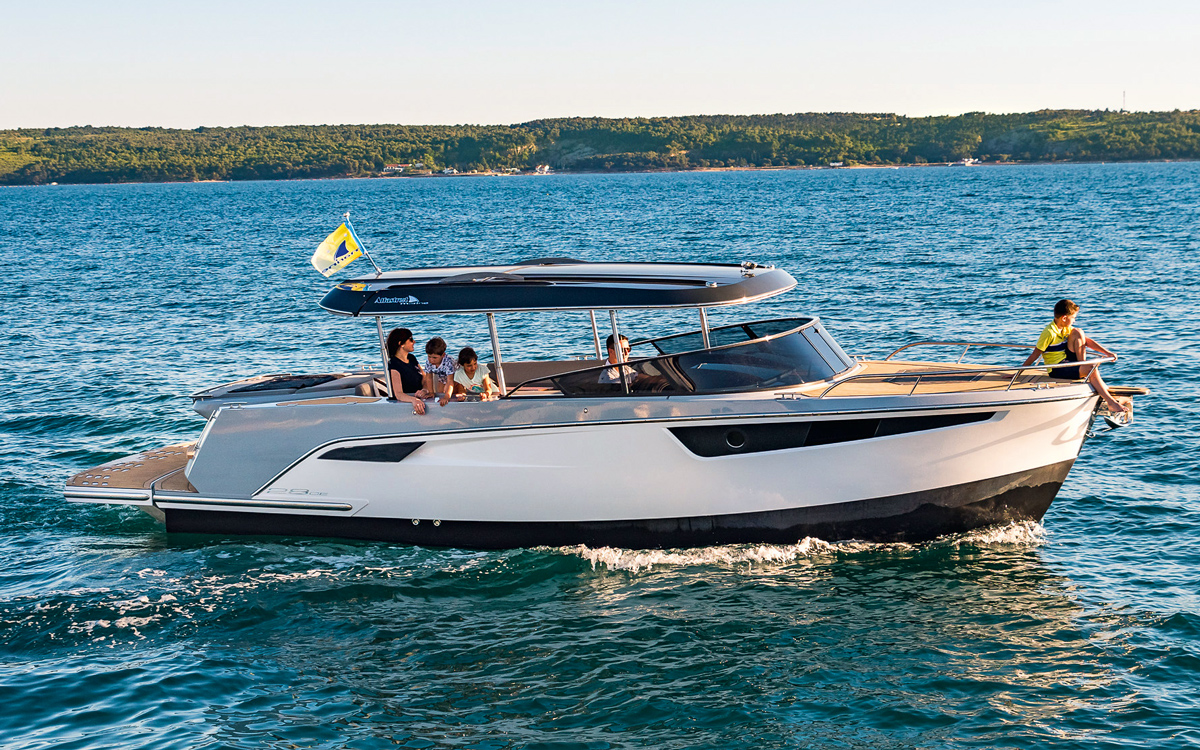
Near silent cruising at 5-7 knots is the electric Alfastreet’s forte
Alfastreet 28 Cabin
These Slovenian-built boats are now a common sight on the Thames where their elegant lines, large sociable cockpits and clever lifting hard tops make them ideally suited to lazy days afloat.
Although most of them are available with powerful petrol outboard or sterndrive engines for fast coastal passages, Alfastreet also offers factory-fit electric boat versions of all its models for inland use.
Designed for slow speed displacement cruising , these are built for slipping along silently at 5-6 knots with zero emissions rather than rushing about at speed.
The top-of-the-range Alfastreet 28 Cabin, for example, is powered by twin 10kW motors for a top speed of around 7.5 knots and an estimated cruising range of 50nm at 5 knots from its twin 25kWh batteries.
Alfastreet 28 Cabin specifications
LOA: 28ft 3in (8.61m) Motor: 2 x 10kW Battery: 2 x 25kWh Top speed: 7.5 knots Range: 50nm Price: Approx £150,000 (inc. VAT)
Article continues below…
Electric boats: When will the boating world be ready to ditch the diesel?
Volvo penta d4 hybrid first look: is this the future of boat propulsion.
Ski boats are all about instant-on torque to punch you out of the hole and leap on the plane. New California start-up Arc Boat Company is ensuring its upcoming Arc One ski boat will do just that, courtesy of its honking 350kW electric motor.
In case you’re wondering, that’s the equivalent of 475hp. Or around twice the juice on tap in the highest-capacity Tesla Model S. It also means a top speed of 40mph, and enough amps to keep you skiing or wake-boarding for up to five hours.
The aluminium-hulled 24-footer, with seats for 10, is the first offering from Los Angeles-based Arc, which is being headed-up by Tesla’s former head of manufacturing. He’s expecting the first electric boats to be delivered, with custom trailer included, this summer.
ARC One specifications
LOA: 24ft (7.3m) Motor: 350kW Battery: 200 kWh Top speed: 35 knots Range: 160nm at 35 knots Starting price: $300,000 / £226,000

The Boesch 750 offers all the style, heritage and performance you could wish for, and an electric motor
Boesch 750 Portofino Deluxe
This exclusive Swiss yard has been in business since 1910 building elegant retro sportsboats for lake and sea use.
Unlike Riva , it still builds exclusively in wood using a lightweight mahogany laminate construction that it claims is as strong and easy to maintain as a modern GRP hull.
All its craft use a traditional mid-mounted engine with a straight shaft propeller and rudder steering for maximum reliability and a flat trim angle, making them well suited for use as ski boats.
The current range comprises six models from 20ft to 32ft, however only the models up to 25ft are available as electric boats.
The top-of-the-range electric model, the Boesch 750 Portofino Deluxe, has twin 50kW Piktronik motors giving a top speed of 21 knots and a range of 14nm.
Boesch 750 Portofino Deluxe specification
LOA: 24ft 7in (7.5m) Motor: 2 x 50kW Battery: 2 x 35.6kWh Top speed: 21 knots Range: 14nm @ 20 knots Price: €336,000 (ex. VAT)

The Candela C-8 recently set a world record for electric boat endurance by covering 420nm in 24hrs
Candela C-8
With a claimed range of 50nm at 22 knots, overnight accommodation for two and a more robust deep vee foiling hull , this new Candela C-8 could be the electric boats game-changer we were waiting for.
Whereas the Candela C-7 looked oddly dated for such a high-tech boat, the C-8 has a purity of line to it that is fresh, modern and distinctive. With its vertical bow, slender beam and subtly contoured topsides free of scoops, slats or unnecessary styling lines, it has a pared back simplicity to it that oozes confidence.
It doesn’t need to shout for attention because every pair of eyes will be glued to it the minute it rises onto its foils and flies silently past the assembled onlookers, leaving nothing but a lingering aura of astonishment hanging in the air.
New for 2023, the C-8 will now be available with an uprated 69kWh Polestar 2 Standard battery pack, which considerably improves the range (as the Candela C-8’s recent world record attempt proved), and with the option of a center console deck layout.
Candela C-8 specifications
LOA: 27ft 11in (8.50m) Motor: 45-55kW Candela C-Pod Battery: 44-69kWh Top speed: 24 knots Range: 51nm Price: €290,000 (ex. VAT)
Watch our full test drive review of the Candela C-8

Electric motors powered by batteries, solar panels and ICE generators allow it to cruise night and day
Cosmopolitan 66
Newcomer Cosmopolitan Yachts is hoping to shake up the market for large electric boats with a striking new 66ft (20.1m) solar-powered catamaran called the Cosmopolitan 66.
An all-aluminium multihull design, the Cosmpolitan 66 features a vast amount of interior space thanks to a maximum beam of 35ft (10.67m).
The outside deck spaces are just as generous, with entertainment terraces fore and aft as well as wide side decks and a huge, almost square flybridge .
Cosmopolitan 66 specifications
LOA: 66ft (20.1m) Motor: 2x 180kW Battery: 450kWh Top speed: 20 knots Range: TBC Price: TBC
Read more about the Cosmopolitan 66

Two-tiered windows provide big views and generous light down below
The new Vripack-designed Delphia 10 is a very versatile yacht. You can spec it with either a diesel engine of up to 110hp or an electric shaft drive from 40 to 80hp.
You can also tailor the layout to your needs with one of three standard arrangements. The Delphia 10 Sedan is a traditional pilothouse model with walkaround side decks and a large cockpit settee.
The Lounge model (pictured) uses a fully open design, with plenty of seating and a forward cockpit, securely contained within elevated side decks. And the Lounge Top model uses a large flat hardtop that makes a great platform for boat solar panels .
Delphia 10 specifications
LOA: 32ft 1in (9.78m) Beam: 11ft 5in (3.49m) Engines: Single inboard electric 40-80hp / up to 110hp diesel Top speed: 44 knots Price: £229,950 (inc. VAT)
Watch our full yacht tour of the Delphia 10
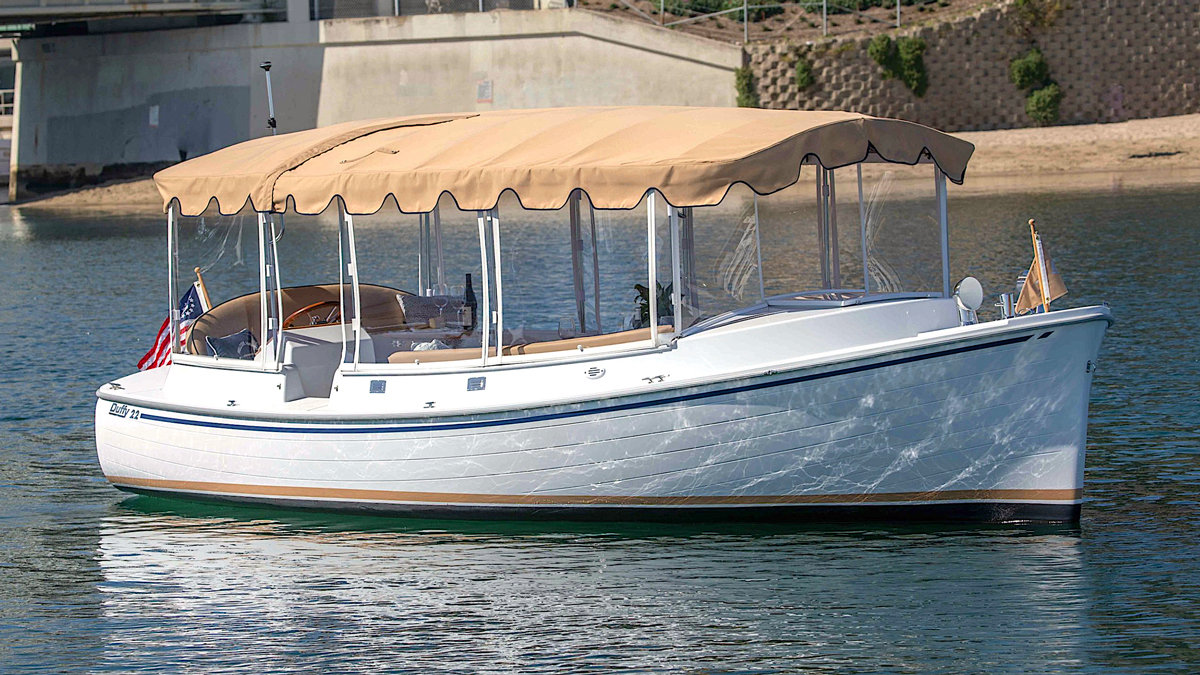
Duffy Sun Cruiser 22
You can’t talk about electric boats and not talk about Duffy. Since 1970, more than 14,000 of these surrey-topped, genteel bay and lake cruisers have been sold. In Duffy’s home port of Newport Beach, California, there’s an estimated 3,500 of them running around. It’s simply the world’s best-selling electric boat.
Beautifully-built, with cushy seats for 12, a built-in fridge, and a multitude of cupholders, the top-selling Duffy 22 makes the perfect cocktail-hour cruiser.
Don’t expect to get anywhere in a hurry. Top speed is a heady 5.5 knots courtesy of a 48-volt electric motor amped by a bank of 16 six-volt batteries.
One especially cool feature is Duffy’s patented Power Rudder set-up. This integrates the electric motor with the rudder and the four-bladed prop, allowing the whole assembly to rotate almost 90 degrees for easier docking.
Duffy Sun Cruiser 22 specifications
LOA: 22ft (6.7m) Motor: 1 x 50kW Battery: 16 x 6-volt Top speed: 5.5 knots Range: 40nm at 5.5 knots Starting price: $61,500 / £47,000
Four Winns H2e
Another member of the Beneteau Group vying to build the best electric boats, Four Winns will launch a 22ft model called the H2e in late 2022, which it claims is the first all-electric series production bowrider in the world.
Powered by a 180hp electric outboard motor from Vision Marine that promises a 35-knot top speed, the Four Winns H2e will get its American debut at the 2023 Miami Boat Show before going into full production in the summer.
Twin 700v batteries will be fitted, but there’s no word yet on the price or cruising range, but given Four Winns’ pedigree, you can expect the former to be very competitive indeed.
Four Winns H2e specifications
LOA: 22ft (6.7m) Motor: 180hp Vision Marine electric outboard Battery: 2x 700v Top speed: 35 knots Range: TBC Starting price: TBC

Frauscher 740 Mirage
The tag line for this Austrian yard is ‘Engineers of Emotion since 1927’, and given the effect its boats tend to have on casual observers, let alone the person sitting behind the helm, we’re inclined to agree.
Simply put, it builds some of the best looking boats on the market, combining rakish proportions with cutting-edge style and exquisite detailing.
Although it builds petrol-powered boats up to 39ft offering searing performance, it also offers most of its smaller craft with the option of silent, emissions-free electric power.
The Frauscher 740 Mirage is a perfect example of this, offering two different electric Torqeedo motors of either 60kW or 110kW. The more powerful of these delivers a top speed of 26 knots and a range of 17-60nm depending on how fast you go.
As if that wasn’t exciting enough, Frauscher have also teamed up with Porsche for an all-electric version of their 8.5m Fantom model, which is due to launch in 2024 as part of a limit edition 25-boat series.
Frauscher 740 Mirage specification
LOA: 24ft 6in (7.47m) Motor: 1 x 60-110kW Battery: 40-80kWh Top speed: 26 knots Range: 17-60nm @ 26-5 knots Starting price: €216,616 (ex. VAT)
Greenline 40
Slovenian-based Greenline Yachts can lay claim to kickstarting the current trend for electric boats. Way back in 2008 it launched the first affordable diesel electric hybrid boat, a formula it has been refining and improving ever since.
Greenline now offers an extensive range of cruisers from 33ft to 68ft, all of which are available with all-electric as well as hybrid or conventional diesel power.
The mid-range Greenline 40 is a fine example; the all-electric version is powered by twin 50kW motors giving it a top speed of 11 knots and a range of up to 30nm at 7 knots with a small 4kW range extender increasing that to 75nm at 5 knots.
However, if you need more flexibility the Hybrid model is fitted with twin 220hp Volvo D3 diesel engines boosting the speed to 22 knots but still allowing electric-only cruising at 5 knots for up to 20nm.
Greenline 40 specification
LOA: 39ft 4in (11.99m) Motor: 2 x 50kW Battery: 2 x 40kWh Top speed: 11 knots Range: 30nm @ 7 knots Price: €445,000 (ex. VAT)
Hermes Speedster E
Inspired by the curvy lines of Porsche’s classic 1950s 356 Speedster, this achingly-gorgeous Hermes Speedster from UK-based Seven Seas Yachts, has been spinning heads since 2017.
The rakish, Greek-built 22-footer typically comes with a 115hp Rotax Biggles-style motor doing the powering. But more recently it’s been offered with an eco-friendly, 100kW electric motor juiced by a 30 kilowatt-hour battery pack.
Flat out it’ll do just over 30 knots. But throttle back to a more leisurely five knots and it’ll glide in stealthy silence for up to nine hours on a charge. Perfect for a trip up the Thames.
And for lovers of retro, it boasts a curvy chrome-framed windscreen, chrome-ringed gauges in a hand-stitched leather dash, bucket front seats in glove-soft marine leather, and chrome air intakes on the rear deck. A nautical piece of art? You bet.
Hermes Speedster E specifications
LOA: 22ft (6.7m) Motor: 100kW Battery: 1 x 35kWh Top speed: 30 knots Range: 50nm at 5 knots Price: $269,000 / £203,000
Hinckley Dasher
Mention the name Hinckley and you immediately conjure-up an image of gorgeous teak-and-stainless, water-jet-thrusted Picnic Boats. But the legendary New England builder has been looking to the future and investing big in electric power.
Its first offering is the sleek 28-foot, all-electric Dasher that comes complete with a BMW-developed lithium-ion battery pack and twin 80hp Torqeedo Deep Blue motors. The high-tech combo can punch the Dasher to a top speed of 23.5 knots. Ease back to seven knots and it’ll run for over five hours on a charge.
Available as an open-deck, fishing-focused runabout, or classic-style windshielded day boat, the Dasher is a hand-built Hinckley bow to stern.
That said, while the boat still looks like it oozes with mirror-varnished teak and stainless fittings, the teak is actually hand-painted composite, the stainless is 3D-printed titanium. That flag-blue hull? Made of carbon-epoxy composites with carbon stringers.
Hinckley Dasher specifications
LOA: 28ft 6in (6.7m) Motor: 2 x 50kW Battery: 40kWh Top speed: 23.5 knots Range: 40 miles at 20 knots Starting price: $545,000 / £412,000

The electric Iguana is capable of three knots on the land and 30 knots at sea
Iguana Foiler
Iguana Yachts has launched the world’s first battery-powered amphibious boat, called the Iguana Foiler. As if that weren’t enough, it also features folding foils and retractable caterpillar tracks.
The all-new 33ft Iguana Foiler is powered by a specially adapted version of Evoy’s new prototype 300hp electric outboard motor fed by a 120kWh lithium-ion battery bank.
To reduce drag and increase range, it rides on a pair of curved surface-piercing foils that fold down from each side and a third T-shaped foil at the rear fitted to a specially extended lower leg of the outboard.
Iguana Foiler specifications
Length: 32.8′ / 10m Beam (min): 10′ / 3.1m Engine: Single 300hp EVOY electric outboard Top speed: 30 knots Range: 50 miles Capacity: 8 people Price: TBC
Read more about the Iguana Foiler

The compact Magonis E-550 is a refreshinghly affordable electric option
Magonis Wave e-550
Spanish newcomer Magonis may not be the prettiest electric boat on the market but it is certainly one of the most affordable, with prices starting from as little €33,485 inc VAT.
Admittedly that only buys you the least powerful displacement-only 4kW version but even the most powerful 30kW model starts at a relatively modest €68,960 and boasts a top speed of 22 knots.
The key to its performance is a lightweight resin-infused hull that weighs just 335kg, which is powered by off-the-shelf electric outboards from Torqeedo and Mag Power.
Despite its diminutive proportions the squared-off bow means it is Category C rated for up to six people. Battery sizes vary from 10kWh to 23kWh according to engine power, giving a range of up to 60nm at 5 knots.
Magonis Wave e-550 specifications
LOA: 18ft 0in (5.50m) Motor: 1 x 4 – 30kW Battery: 1 x 10 – 23kWh Top speed: 22 knots Range: 30nm @ 3 knots Starting price: €33,485

Mantaray M24
What makes this 24ft Mannerfelt-designed runabout particularly interesting is its simplicity. Unlike its main foiling rival, the Candela C-7, the Mantaray M24 requires no complicated electronics to ‘fly’.
Instead it uses the builder’s patented mechanical hydrofoil system, which it has trademarked as Dynamic Wing Technology or DWT.
The technology is said to be the result of ten years’ development work and uses a retractable T-foil in the bow and H-foil amidships that self-stabilise mechanically.
Mantaray M24 specifications
LOA: 24ft 0in (5.50m) Motor: 48kW Battery: 26kWh Top speed: 30 knots Range: 60nm Starting price: TBC
Read more about the Mantaray M24

The Marian M800 doesn’t make any compromises on style or speed
Marian M800 Spyder
This Austrian yard only manufactures all-electric boats so they can be designed from the ground up to suit the packaging requirements of the battery and motor rather than having to accommodate big petrol or diesel engines too.
The result is a supremely elegant range of retro-inspired sportsboats from 19ft to 26ft, as well as a more prosaic lake cruiser. The latest M800 Spider, launched at the 2021 Cannes Yachting Festival , is its prettiest boat yet, rivalling the Riva Iseo for sheer style.
With each boat being built to order, you can specify anything from a 10kW electric motor and affordable 200Ah AGM batteries for lake use up to a 150kW motor and 125kWh lithium ion batteries for a top speed 34 knots (waterskiing is also possible) and a range of 30nm at 16 knots.
Marian M800 Spyder specifications
LOA: 25ft 9in (7.90m) Motor: 1 x 10-150kW Battery: 10-125kWh Top speed: 34 knots Range: 30nm @16 knots Starting price: €238,560

Styling is a bold mix of retro design cues and futuristic detailing
Mayla FortyFour
German start-up Mayla Yachts is close to launching the first of its outrageous all-electric performance boats, called the Mayla FortyFour. Based on a Petestep deep-vee hull platform, this ultralight carbon fibre electric boat promises top speeds of over 70 knots.
Twin 800kW dual-core electric motors deliver up to 2,150hp of power to tunnel-mounted surface drives and thanks to the 4,800Nm of torque on tap, the second you apply the throttles, acceleration should be fearsome.
Power comes from either an all-electric 500kWh lithium-ion battery or a smaller 400kWh battery backed up by a 400hp (300kW) diesel generator and fuel tank. This hybrid boat version should give a maximum range of 270nm at 30 knots.
Mayla FortyFour specifications
LOA: 44ft (13.4 m) Beam: 10ft (3.0 m) Displacement: 6,200kgs Water capacity: 200L Power: Twin 400-800kW Battery: 400-500 kWh Li-ion Top speed: 70 knots Cruising range: 70nm (electric) / 270nm (hybrid) Price: TBC
Read more about the Mayla FortyFour
Anyone who has watched America’s Cup boats in action will know foiling does wonders for performance, which is the thinking at Silicon Valley-based and Sergey Brin-backed Navier, which is currently developing one very cool, and very clever, hydro-foiling electric dayboat, the Navier N30.
With its retractable foils and twin 90kW electric motors connected to a 80kWh battery bank, the carbon-hulled Navier can soar four feet above the waves at over 30 knots. Throttle back to 20 and the projected range is over 75 nautical miles, which Navier claims makes this the rangiest 30ft electric boat in the world.
You cake your pick from a Cabin version or open Hardtop, both of which come with a nifty self-docking feature (demonstrated in the video above). Navier says that the 2023 production run has sold out and it is already taking deposits on 2024 boats.
Navier N30 specifications
LOA: 30ft (9.1m) Beam: 8ft 6in (2.6m) Motor: 2 x 90kW Battery: 80kWh Top speed: 35 knots Range: 75 miles at 20 knots Starting price: From $300,000 / £226,000

Nero 777 Evolution
Designed in Italy and built in Germany, the new Nero 777 looks like a very appealing combination of style and engineering know-how. Due to launch in 2024, it will come with a choice of five Evoy propulsion systems ranging from 60kW all the way up to 300kW.
The latter will offer an impressive top speed in excess of 50 knots, making this one of the fastest electric boats in development. And with a Petestep hull, it should offer a very comfortable ride even at such rapid speeds. Bring the speed back to a leisurely 5 knots and the claimed range shoots up to an impressive 108nm.
Design-wise, the Neto 777 Evolution taps into the current trend for fold-down balconies, which can create a water-level beach club effect – no mean feat on such a compact boat.
Nero 777 Evolution specifications
LOA: 25ft 6in (7.77m) Beam: 8ft 8in (2.63m) Motor: 60-300kW Battery: 40-126kWh Top speed: 50 knots Range: 108nm at 5 knots Starting price: From €287,500

Nimbus 305 Coupe E-Power
Legendary Swedish yard Nimbus is renowned for its thoughtfully designed and sturdily built boats and the 305 Coupe is no exception.
Although originally designed for conventional combustion engines, it has been successfully adapted for electric use with the aid of a Torqeedo Deep Blue electric motor and a pair of 12.8kWh lithium ion batteries.
The recommended cruising speed is a modest 5.7 knots giving a range of 22nm at this speed but this can be almost doubled with the aid of a second optional battery.
Nimbus 305 Coupe E-Power specifications
LOA: 33ft 3in (10.07m) Motor: 1 x 25kW Battery: 1x 40kWh Top speed: 6.5 knots Range: 22nm @ 5.7 knots Starting price: €265,000 (ex. VAT)

One of the most striking elements of the Optima E10 is its hull shape. This stabilised monohull design features a slender central hull flanked by even thinner external ones, creating tunnels underneath.
This design enhances efficiency by reducing drag, allowing the boat to achieve fast displacement speeds of approximately 14 to 15 knots. The external riggers also contribute to the boat’s stability, ensuring a comfortable and smooth ride.
Measuring 10m in length (around 33 ft), the Optima E10 is powered solely by electricity. It does not feature a hybrid drive or combustion engine, thus maximising its efficiency. The boat is equipped with two 63kWh Kriesel batteries and a 40kW electric motor from Rad propulsion, equivalent to approximately 54hp.
Optima E10 specifications
LOA: 36ft 1in / 11m Motor: 40kW Rad Propulsion Batteries: 120kWh Kriesel Top speed: 15 knots Range: 200 nautical miles @ 6 knots Starting price: £400,000
Watch our yacht tour of the Optima E10

Pixii’s aluminium hull and powerful battery should deliver impressive range and performance
Pixii SP800
Although this budding British brand has yet to launch one of its pretty new Pixii SP800 electric sportsboats, the first one is already in build on the Isle of Wight.
Featuring a light but strong aluminium hull with either one or two electric motors linked to a jet drive and what is said to be a class-leading 150kWh battery pack, it has all the ingredients of a formidable contender.
We’ll have to wait to see if it lives up to its maker’s claims of a 40-knot top speed, but if it does, it would make it one of the fastest electric production boats on the market.
It even has the option of a remote anchoring system that lets you jump off onto a beach then drive it out into deeper water before dropping the hook!
Pixii SP800 specifications
LOA: 24ft 6in (7.5m) Motor: 2 x 25kW Battery: 1x 150kWh Top speed: 40 knots Range: 100nm @ 14 knots Starting price: £114,000 (inc. VAT)

Persico Zagato 100.2
Performance boat specialist Persico is set to launch its first all-electric superboat this year, called the Persico Zagato 100.2. Designed in collaboration with iconic automotive design house Zagato, the 26ft stunner is built around a revolutionary new steerable electric waterjet pod from Italian start-up Sealence.
The 100.2 part of the name celebrates Zagato’s second century in business, the new electric boat features a reverse bow, wraparound windshield, aft sunpad, rear bench-sofa and two front pilot seats, plus cuddy space beneath the foredeck.
However, it’s the ultra-efficient electric drivetrain that is likely to cause the biggest stir. The single 205kW Sealence DeepSpeed 420 steerable azipod is said to give the new boat a top speed of 43 knots and a cruising speed of around 24 knots, at which the range should be almost 50nm.
Persico Zagato 100.2 specifications
LOA: 25ft 11in (7.9m) Motor: 205 kW electric integrated jet pod Battery: 2x 83kWh Top speed: 43.5 knots Range: 47nm @ 24 knots Starting price: TBC
Read more about the Persico Zagato 100.2

Q-Yachts Q30
This Finnish yard was established in 2016 with the idea of developing an elegant electric boat that gave the same swift, silent cruising experience as a high-end sailing boat but without having to worry about sails and crew.
The result is the Q30, a stylish open day boat with striking minimalist looks and a super efficient hull shape that allows it to slip through the water at speeds up to 14 knots, making almost no noise or wake.
It’s powered by a pair of 10kW Torqeedo motors and a relatively meagre 30kWh battery but such is its efficiency that it will cruise for 10 hours at 6 knots or 5 hours at 9 knots.
Q-Yachts Q30 specifications
LOA: 30ft 6in (9.3m) Beam: 7ft 3in (2.2m) Motor: 2 x 10kW Torqeedo Battery: 30-40kWh Top speed: 14 knots Range: 60nm @ 6 knots, 21nm @ 14 knots Starting price: €183,000 (ex. VAT)

Distinctive rebated topsides are a growing trend in small sportsboat design
Rand Source 22
Rand Boats claims its new Rand Source 22 is one of the most affordable electric sportsboats on the market, as well as one of the fastest.
Two electric boat options enable it to cover both these extremes in addition to a range of inboard and outboard petrol and diesel engines of up to 250hp.
When propelled by Torqeedo’s Deep Blue 50 outboard, it will carry a price tag of less than €100,000 but when fitted with Rand’s much more powerful 170kW electric inboard it will be capable of short-burst speeds of up to 50 knots and sustained cruising at 28 knots.
Rand Source 22 specifications
LOA: 22ft (6.7m) Motor: 170kW Battery: TBC Range: TBC Top speed: 50 knots Starting price: €63,900
Read more about the Rand Source 22

Ripple Boats 10m Day Cruiser
Hailing from Norway and launched at the 2023 Cannes Yachting Festival, Ripple Boats is a new brand founded by Frydenbø Marine and Pascal Technologies.
They have raised over €4million of funding for their start-up venture and their debut model will be a 10m day cruiser developed by Thorup Design.
Key features from the initial renderings include an extendable hard-top bimini with inset glazing, plus the now ubiquitous folding balconies.
Should this debut model prove successful, Ripple Boats have plans to build a wide range of electric boats from 6-11m.
Ripple Boats 10m Day Cruiser specifications
LOA: 32ft 10in (10m) Beam: 10ft 6in (3.2m) Motor: 2 x 93kW Battery: 190 kWh Range: 45nm Cruising speed: 25 knots Starting price: TBC

Only Riva could produce an electric boat that looks as pretty as this
Riva El-Iseo
As its name suggests the El-Iseo is an all-electric version of Riva’s entry-level sportsboat, the gloriously retro 27 Iseo.
The heart of the El-Iseo is a 250kW Parker GVM310 electric motor that spins a Mercury Bravo Three XR sterndrive leg. The prototype is capable of 40 knots, much the same as it delivers with its usual 300hp petrol or diesel engine options.
However, those who have driven the electric version say it’s the acceleration that really stands out. The quoted range figures are one hour at 25 knots or 10 hours at five knots, meaning a range of 25nm at planing speeds or 50nm in displacement mode.
Ferretti Group CEO Alberto Galassi says that they will not start selling the El-Iseo or commit to a price until they have thoroughly tested the prototype and are certain it will deliver the performance, safety and reliability expected of a Riva.
The production model will be packaged with the latest electronics including a smart management system that reduces speed when the battery runs low and collision-avoidance software. “If it is going to be a Riva, it has to be perfect,” said Galassi.
Riva El-Iseo specifications
LOA: 27ft (8.2m) Motor: 250kW Battery: 150kWh Top speed: 40 knots Range: 50nm Starting price: TBC

RS Pulse 63
RS Sailing is the first British yard to offer a production ready electric planing RIB in the form of the RS Pulse 63 . With a super efficient hull design by Jo Richards, the man behind the hugely successful RS range of sailing dinghies, and styling by superyacht studio Design Unlimited, it looks like a really enticing package.
Power comes from a brand new 40kW RAD propulsion system, that claims to be safer and more efficient than an exposed propeller, linked to a bespoke 46kW Hyperdrive battery pack.
This delivers a top speed of 23 knots and a range of 25-100nm miles depending on speed but can be further increased with the aid of an optional extra 23kWh battery pack.
RS Pulse 63 specifications
LOA: 20ft 8in (6.30m) Motor: 1 x 40kW Battery: 46kW Top speed: 23 knots Range: 25-100nm @ 20-5 knots Starting price: £82,800 (inc. VAT)
Watch our sea trial video of the RS Pulse 63
SAY Carbon Yachts 29 E
As the name suggests, this German yard is renowned for its ultra light, high performance carbon fibre craft and it’s these same properties that make the SAY Carbon Yachts 29 E such a compelling electric craft.
This slender, low draught speed machine weighs less than two tonnes all up, including a powerful 360kW Kreisel electric motor and 120kWh battery. Hardly surprising then that it also holds the record for the world’s fastest production electric boat (under 9m) after scorching to a top speed of 50 knots on an Austrian lake in 2018.
Use the power more sparingly and the yard claims a range of 25nm at 22 knots, while a built in 22kW charger delivers a full recharge in just six hours.
SAY Carbon Yachts 29 E specifications
LOA: 29ft (8.85m) Motor: 1 x 360kW Battery: 120kWh Top speed: 52 knots Range: 25nm @ 22 knots Starting price: €396,460 (ex. VAT)

Silent 28 Speed
Silent Yachts ’ electric-powered Silent 28 Speed grabbed headlines at the 2022 Cannes Yachting Festival thanks to a claimed top speed of more than 60 knots and an impressive range of 70nm at 30 knots. The secret to its performance is a foil-assisted hull with unique surface-piercing propellers.
Pushed along by twin 100kW eD-QDrive electric motors hooked up to a 100kWh lithium-ion battery bank topped up by built-in solar panels, it demonstrates that serious performance is no longer the preserve of petrol powered boats. No price has been announced.
Silent 28 Speed specifications
LOA: 28ft (8.6m) Motor: 2 x 100kW Battery: 100kW Top speed: >60 knots Range: 70nm Starting price: TBC

SpiritBARTech35EF
A marriage of gloriously retro styling and cutting-edge foiling technology, this electric foiler was commissioned as a chase-boat toy by the same European owner that took delivery in early 2020 of Spirit Yachts ’ largest and most technologically advanced project to date, the 111ft super-sloop Geist .
She was drawn by Spirit Yachts’ CEO and chief designer Sean McMillan, who admits to taking his principal inspiration from a slightly smaller twice Gold Cup winning hydroplane of mid-1920s America called Baby Bootlegger , which sported a similar near-plumb bow, long varnished foredeck and a two-seat cockpit.
The vessel encompasses a modified electric motor, developed for motorsport, and three integrated foils. The claimed top speed is 30 knots, but the usual fast cruise speed will be in the low 20s, at which the quoted range is 100nm.
This was put to the test on July 17, with the SpiritBARTech35EF setting a new electric boat record for fastest circumnavigation of the Isle of Wight, covering 51m in 1hr 56mins at an average speed just shy of 23 knots.
Spirit 35 Foiler specifications
LOA: 35ft (10.6m) Motor: TBC Battery: TBC Top speed: 28 knots Range: 100nm at 20 knots Price: Available on application
Read more about the SpiritBARTech35EF

Super Air Nautique GS22E
Based on the petrol-powered GS22 wake surf boat, the Super Air Nautique GS22E is packed with the best features available. These include a hydraulic folding wake tower, custom finishes, a configurable cockpit, and a customizable running surface that can change the characteristics from ski boat to wake surf or wakeboard use via a simple touchscreen at the helm. The boat can even be optioned with an electric stern thruster to make docking a doddle.
As well as being virtually silent underway, this electric boat version can offer up to three hours’ use on a single charge. The huge flat torque curve of the electric power plant perfectly suits tow sports use and onboard telemetry constantly monitors and reports the engine’s performance.
The significant $140,000 premium over the petrol powered version means this model will not be for everyone, however the emissions-free GS22E is the first of its kind and potentially the wake surf boat of the future.
Super Air Nautique GS22E specifications
LOA: 22ft / 6.7m Motor: 1 x 220kW Battery: 124kWh Top speed: 37.5 knots Range: 2-3hrs usage Starting price: $312,952

Vita isn’t just a boat-building company, it also hopes to sell off-the-shelf electric drivetrains to other yards. Given the impressive performance and range of its own flagship LION model, this could prove a very smart move.
This elegant 10.5m day boat packs roughly the same amount of battery power as four Tesla 3 models and, thanks to a pair of 150kW electric motors linked to a single Mercury Bravo sterndrive, it goes like one too.
In fact Vita has to limit the amount of torque the motors put out to stop it shredding the gears. Despite this it maxes out at around 35 knots and can cruise for 90 minutes at 22 knots or almost 10 hours at 6-7 knots.
Vita LION specifications
LOA: 32ft 9in (10.5m) Motor: 2 x 150kW Battery: 235kWh Top speed: 35 knots Range: 33-70nm @ 22-7 knots Starting price: £750,000 (ex. VAT)
Watch our full sea trial review of the Vita LION

Voltari 260
Typically, the brand new Voltari 260 electric boat is all about going fast. With its high-torque 740hp electric motor juiced by a 142kWh bank of lithium-ion Evereadys, it can slice and dice the waves at an impressive 52 knots.
But when there’s a world record to be broken, it’s worth a compromise or two. So, to claim the gong for covering the longest overseas distance in an electric “vehicle” on a single charge, the Voltari streaked along at a heady… 4.3 knots.
That meant covering the 91-miles between Key Largo, Florida, across the often-boisterous Gulf Stream, to Bimini in the Bahamas in what must have seemed an endless 20 hours. But it got the job done, and on a single charge.
Voltari 260 specifications
LOA: 28ft 11in (8.6m) Motor: 551kW Batteries: 142kWh Top speed: 52 knots Range: 91 miles @ 4 knots Starting price: $450,000
Read more about the Voltari 260

The big claim for the new X Shore 1 is that it’s the first all-electric 30-knot sportsboat to be priced at under €100,000 ex taxes, making it the cheapest electric planing runabout in Europe.
With an LOA of 21ft 4in (6.5m), it is around 5ft shorter than the original X-Shore Eelex 8000 and €150,000 cheaper. It is powered by a 125kW electric motor with a single 63kWh Kreisel battery (the Eelex has a 225kW motor and two 63kWh batteries) but thanks to the 1’s smaller, lighter hull it boasts the same top speed of 30 knots and a similar range of 20nm at 20 knots or 50nm at 6 knots (the Eelex can do 100nm at low speed).
The X-Shore 1 is available either as an open boat with a half height windscreen or a semi-enclosed Top version with the aid of an extended windscreen, a small hard top and canopies protecting the helm. Unlike the walkaround Eelex, it also has an enclosed foredeck with a cuddy underneath for overnighting.
X Shore has also started branching out into the realm of commercial boats. Based on the Eelex 8000 platform, the first X Shore Pro is being used for school transportation in the Swedish archipelago.
X-Shore 1 specifications
LOA: 21ft 4in (6.5m) Motor: 125kW Battery: 63kWh Top speed: 30 knots Range: 50nm @ 6 knots Starting price: <€100,000 (ex. VAT)
Watch our full video tour of the X-Shore 1

ZIN’s waif-like sportsboat has a claimed range of 100nm at 13 knots
Seattle-based start-up Zin Electric Boats claims an astonishing range of up to 100nm for its pretty little Z2R sportsboats. Its secret is a super-lightweight all-carbon fibre hull that allows it to plane efficiently at just 13 knots.
As with many of these boats it is powered by Torqeedo’s 55kW electric motor linked to the same company’s 45kWh battery adapted from the BMW i3 electric car.
The first prototype reached a faintly terrifying 48 knots flat out but the production version is being limited to 30 knots to extend the range. Acceleration should still be lightning quick though thanks to the motor’s impressive torque.
Zin Z2R specifications
LOA: 20ft 0in (6.1m) Motor: 55kW Torqeedo Battery: 40kWh Top speed: 30 knots Range : 100nm @13 knots Price: $250,000 (ex. VAT)

Zodiac 450 e-jet
French RIB specialist Zodiac is developing an entire range of small, affordable electric RIBs in conjunction with Torqeedo, but in the meantime it has already started building a state-of-the-art electric jet-RIB, predominantly for use as a superyacht tender.
Powered by a 50kW Torqeedo Deep Blue motor with a 40kWh battery from the BMW i3 car driving a low drag water jet, it can reach a max speed of 30 knots.
It also boasts a useful 90 minutes of cruising time at 24 knots, equating to a range of 36nm. High quality Neoprene tubes, retractable seating and hand-sewn quilted seats help justify its price and intended target market.
The new 3.1m and 3.4m eOpen range won’t be quite as quick but will have a range of around 10nm at 12 knots, and with prices from €25,200, they’re more affordable.
Zodiac 450 e-jet specifications
LOA: 14ft 9in (4.5m) Motor: 50kW Torqeedo Battery 40kWh Top speed: 30 knots Range: 36nm @ 24 knots Price: €140,800 (ex. VAT)
If you enjoyed this…
Be first to all the latest boats, gadgets, cruising ideas, buying advice and readers’ adventures with a subscription to Motor Boat & Yachting . Available in both print and digital formats, our monthly magazine will be sent directly to your home or device at a substantial discount to the usual cover price. See our latest offers and save at least 30% off the cover price.
How to set up depth sounders: Everything you need to know about sonar
Best 40ft family flybridge boats on the market now, first look: the new karnic s37x’s shapeshifting potential, latest videos, saxdor 400 gtc tour: düsseldorf launch for new flagship, arksen 85 explorer tour: the ultimate long-range cruiser, sacs rebel 50 tour: the world’s most luxurious rib, fairline targa tour: sensational new british sportscruiser.

- Green Propulsion
- Renewable Energy
- Energy efficiency
- Sustainable materials
- News & Events
- Sunreef News Magazine
- Press About Sunreef

- 60 Sunreef Power
- 70 Sunreef Power
- 80 Sunreef Power
- 100 SUNREEF POWER
- Sunreef Supreme Power
- Sunreef Ultima Range
- Sunreef 44 Ultima
- Sunreef 55 Ultima
- Sunreef 66 Ultima
- Sunreef 77 Ultima
- Sunreef 88 Ultima
- Sunreef fleet

- SUNREEF ZERO CAT
- SUNREEF 100
- Sunreef Fleet

- SUNREEF 43M
- 49M SUNREEF POWER
- 210 Sunreef Power Trimaran
- Sunreef Explorer
- 40M SUNREEF EXPLORER
- 40M SUNREEF EXPLORER ECO
- 50M SUNREEF EXPLORER
- Superyacht Fleet
Electric Yachts
As yacht owners and builders become increasingly aware of environmental issues, electric yachts have come to be one of the nautical industry’s most dynamic trends. With most luxury crafts still relying on fossil fuel use, the impact of yachting on the environment remains a major issue. Fossil fuels damage the environment severely through greenhouse gas emissions. Their extraction process degrades natural ecosystems, while oil spills pollute the oceans with toxins and carcinogens. In the pursuit of sustainable propulsion solutions , shipyards across the globe are more and more eager to introduce green alternatives to conventional combustion engines. The benefits of electric catamarans are numerous, both for the environment and yacht owners.
Electric catamarans can substantially reduce fossil fuel use by relying on sun and wind for energy generation. Yachts equipped with electric engines allow for quiet journeys and provide for a more relaxing environment on board thanks to a silent, vibration and fume-free operation. On top of environmentally friendly propulsion, electric engines offer significant cost savings as they do not consume fuel and require less maintenance than diesel engines.
EXPLORE OUR CATAMARANS
Sailing yachts, power yachts, superyachts, discover the green side of yachting.
SUBSCRIBE TO OUR NEWSLETTER
- Sailing Yachts
- Power Yachts
- Superyachts
- Making a Change
- Green Concept
- Eco Q&A
Copyright © 2024 Sunreef Yachts . All rights reserved.
- Whistleblowing
- Privacy Policy

Sunreef Venture S.A.
Sunreef Yachts Shipyard
ul. Tarcice 6
80-718 Gdańsk, Poland
+48 58 769 77 77

Everything electric boats and boating

New Arcona 415 first sailing yacht with electric propulsion standard
Sweden’s arcona yachts has announced that their new arcona 415 has oceanvolt electric propulsion as a standard feature, a first for series-produced sailing yachts..
Having electric as standard on a boat like the 415 marks a big change. Now it means that potential owners would have to specifically ask about diesel as an option, which then requires comparing its pros and cons to electric. Arcona obviously thinks most will go with the clean, quiet, zero emission system.
“Electric is here to stay” says Urban Lagnéus, Arcona Yachts CEO. “The ability to spend your leisure time at sea without emissions, and yet gain advantages in comfort and performance, opens up a new world of opportunities for our normal usage. Our cruisers sail beautifully in any conditions, but in light winds and close to marinas, if you need to use the engine, electric propulsion is the way forward.”
Electric propulsion that recharges itself
To provide the motors and electric system the company turned to Oceanvolt , which was founded in 2004 by avid sailor Janne Kjellman and is a pioneer in zero emission propulsion for sailboats.
Their modular AXC series lets the user ‘stack’ motors to build power configurations of 10kW, 20kW, 30kW or 40kW and their patented ServoProp variable pitch sail drive was a 2017 category winner in the prestigious DAME awards that recognize the best-designed products in each year’s METSTRADE nautical trade show.
It is the ServoProp with hydroregeneration that will be the standard on the Arcona 415, using a 15kW system and 19kWh battery pack. In hydro regeneration (sometimes called just regeneration or ‘regen’) the electric motor can be instantly converted to an electricity-generating turbine that is turned by the ServoProp propeller while the boat is under wind power. That electricity is then stored in the system’s battery pack for later use.
One of the keys for regen is achieving enough speed to get the propeller turning, and the Arcona yachts are well suited to the task. The boatyard is known for ‘cruiser-racers’ which are designed to perform well in racing when the pilot has an expert team aboard, but also be comfortable, safe and easy to sail for relaxed family cruising.
Lagnéus says “The sleek and light hull design works extraordinarily well with electric propulsion, however our customers have seen the hydro regeneration commence when the yacht is sailing at a speed as low as 3.3 knots.”
Crossing the Atlantic with zero emissions
Arcona is also a pioneer in electric propulsion. It already has the largest fleet of electric sailboats on the water, the first being the Arcona 380Z (for Zero emission) launched in 2015. In 2019 Graham Balch of Green Yacht Sales wrote about What it’s Like to Cross the Atlantic Ocean in an Electric Sailboat. You can read the whole story »» on the Green Yachts site , but here’s a teaser:

And (spoiler alert):
“ Would I do it again? Crossing the ocean in an electric sailboat was so enjoyable compared to a sailboat with a diesel engine, I would never want to cross the ocean with a diesel engine ever again (pretty similar to how most Tesla owner feels about the idea of going back to driving a gas car).”
The beginning of the beginning
Sailing boat owners have been some of the first to adopt electric propulsion over the past decade, with a big reason most likely being that many sailors like sailing for the very reason that they prefer silence and fresh air to the sounds and odours of diesel and gasoline motors.
Many owners have converted boats themselves, with motors from companies like Oceanvolt , Fischer-Panda , Bellmarine , Thoosa and others (check the Plugboats Guide to Electric Saildrives and Pods and the Marketplace of Electric Motors ).
A growing number of builders have been offering electric propulsion as an option, and the number of manufacturers doing so is increasing almost daily. In February Elan yachts was the first to offer electric as an option across its entire fleet , and an Electric Sailboat category was started in this year’s Gustave Trouvé Awards. You can see the nominees »» here
Electric propulsion as the standard feature is the next important step in the transition away from fossil fuels.
As Arcona’s Lagnéus says: “The benefits of electric propulsion are numerous; not having an exhaust and the elimination therefore of emissions, the ongoing cost saving vs. fuelling up with diesel, the minimized operating noise and vibrations, the increased space for living, the complete power management, the ease of use and maintenance, and having an overall lighter weight thus increased performance.”
“We can all do our bit to combat climate change, and to be the first yacht builders with zero emission propulsion as a standard is an important step towards further enjoyment of sailing the Arcona way.”
Exciting things are happening every day in electric boats and boating. Subscribe to the Plugboats newsletter so you don’t miss a thing!
Email address:
Follow Plugboats on »» facebook , »» twitter »» Instagram »» Linkedin
- ← Candela electric boat motor: big efficiency with 2 motors, 2 props
- Breakthrough Candela 8 set to prove electric to general boat buying public →
Leave a comment Cancel reply

Get all the latest electric boats and boating news delivered to your mailbox!
Sign up here for the plugboats newsletter..
IT’S FREE!
No, thanks.
Terms and Conditions - Privacy Policy
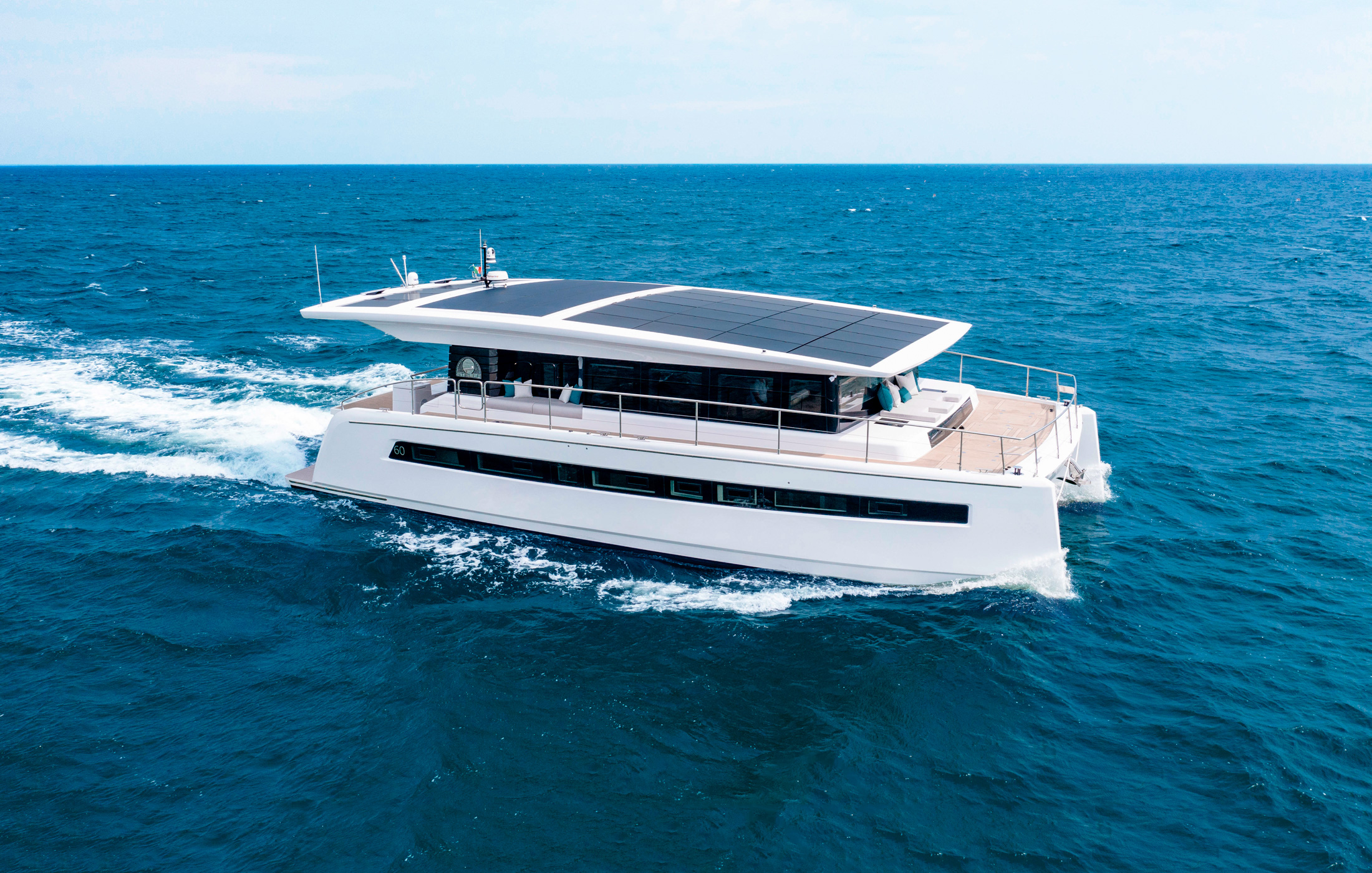
The award-winning entry to solar-electric yachts
As the successor to the Silent 64 (the first ever solar powered production yacht to cross the Atlantic Ocean during January of 2018), the 60 Series is equipped with the most refined, efficient and clever technology available today. Being a multi-award winner, including the prestigious “Best of Boats Award” in the category of ‘Best for Travel’, she embodies solar electric yachting in its purest form. Available in a variety of deck and cabin options, the Silent 60 is ideally suited for families cruising with or without additional crew.

Specifications
Deck options, silent 62 flybridge.
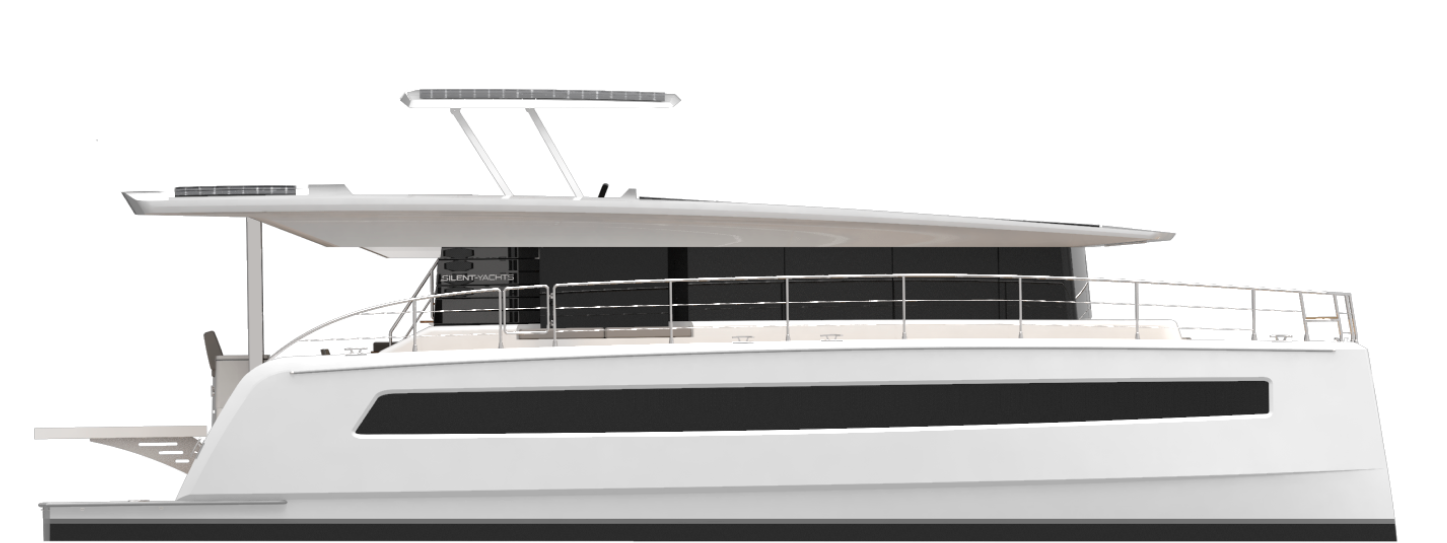
The flybridge version with a retractable roof offers enough space for a dining area with a small lounge and a dedicated helm station. For owners who do not need the additional space of the 62 3-deck configurations, the flybridge version offers enough space and outstanding 360° visibility.
Silent 62 3-Deck Open
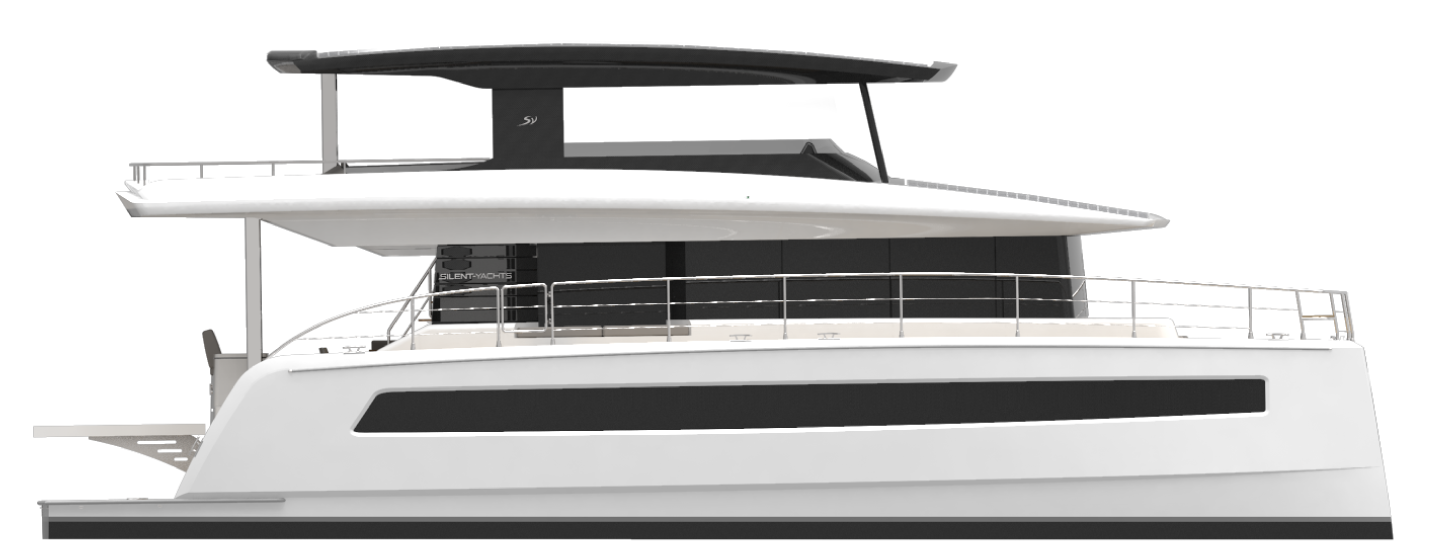
An additional open deck instead of the flybridge combines the benefits of larger catamarans with the compact dimensions of the 60 Series. The open sky lounge is a fantastic outdoor community space, equipped with a full dining area including a panoramic view and a superyacht atmosphere.
Silent 62 3-Deck Closed
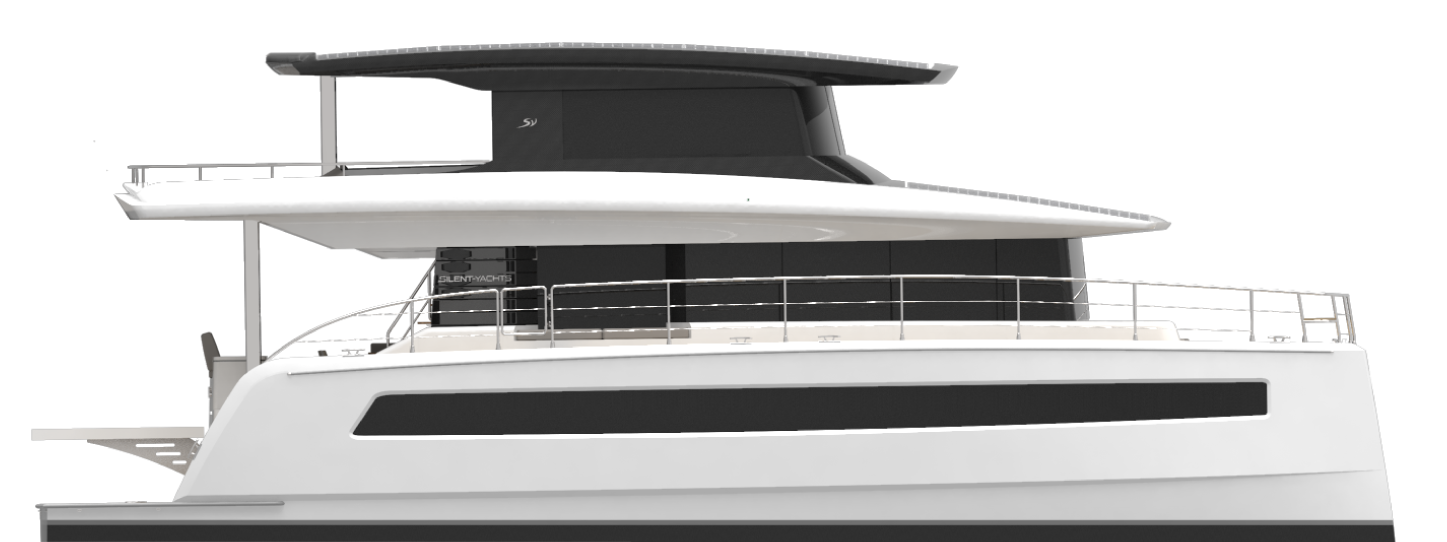
The closed version of the 62 3-Deck further develops her character as a compact superyacht. Providing additional indoor space, the closed third deck is available in two options: a choice between a sky lounge or an exclusive owner’s deck makes sure it can be tailored towards individual needs.
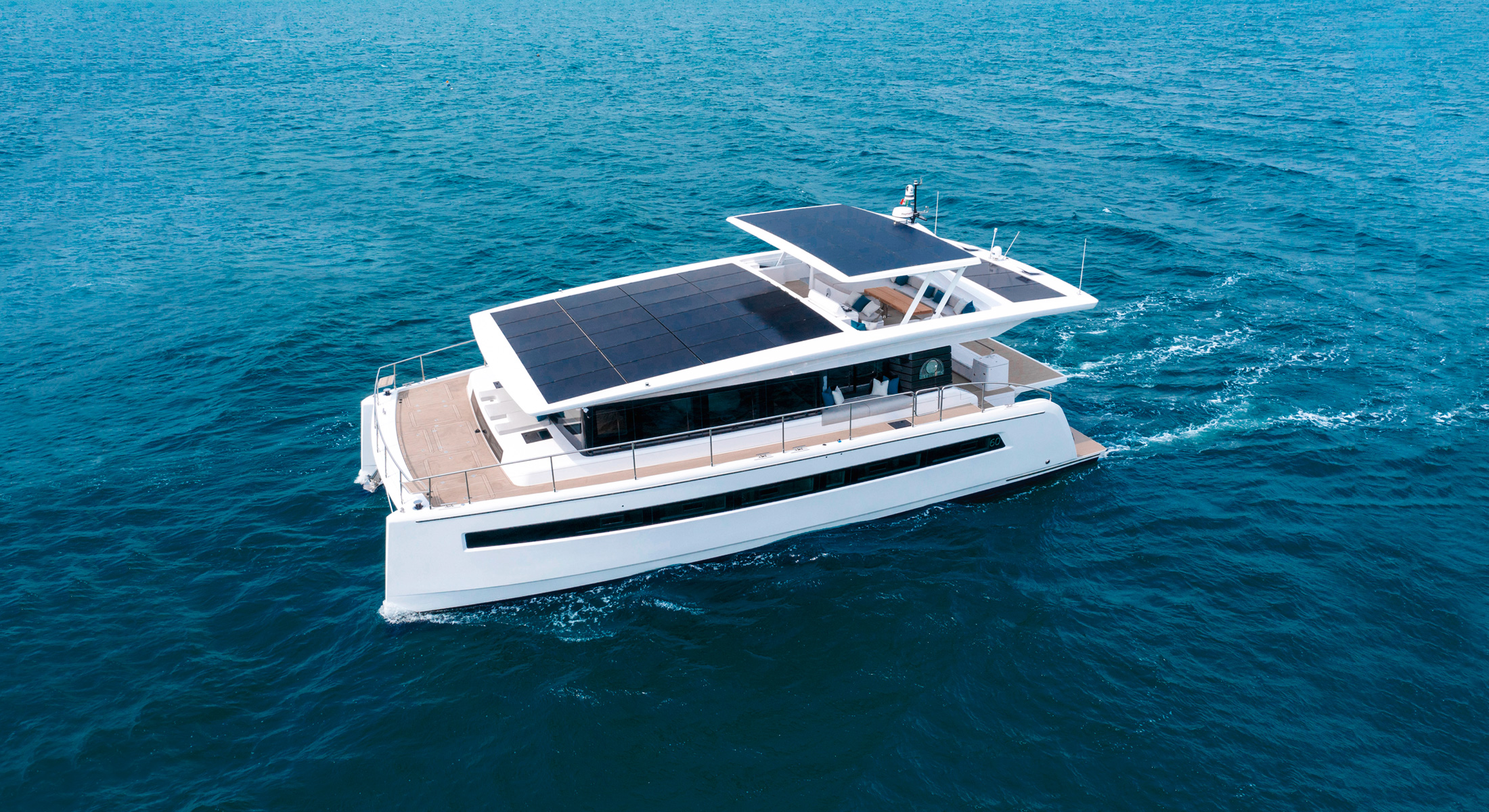
Model variations
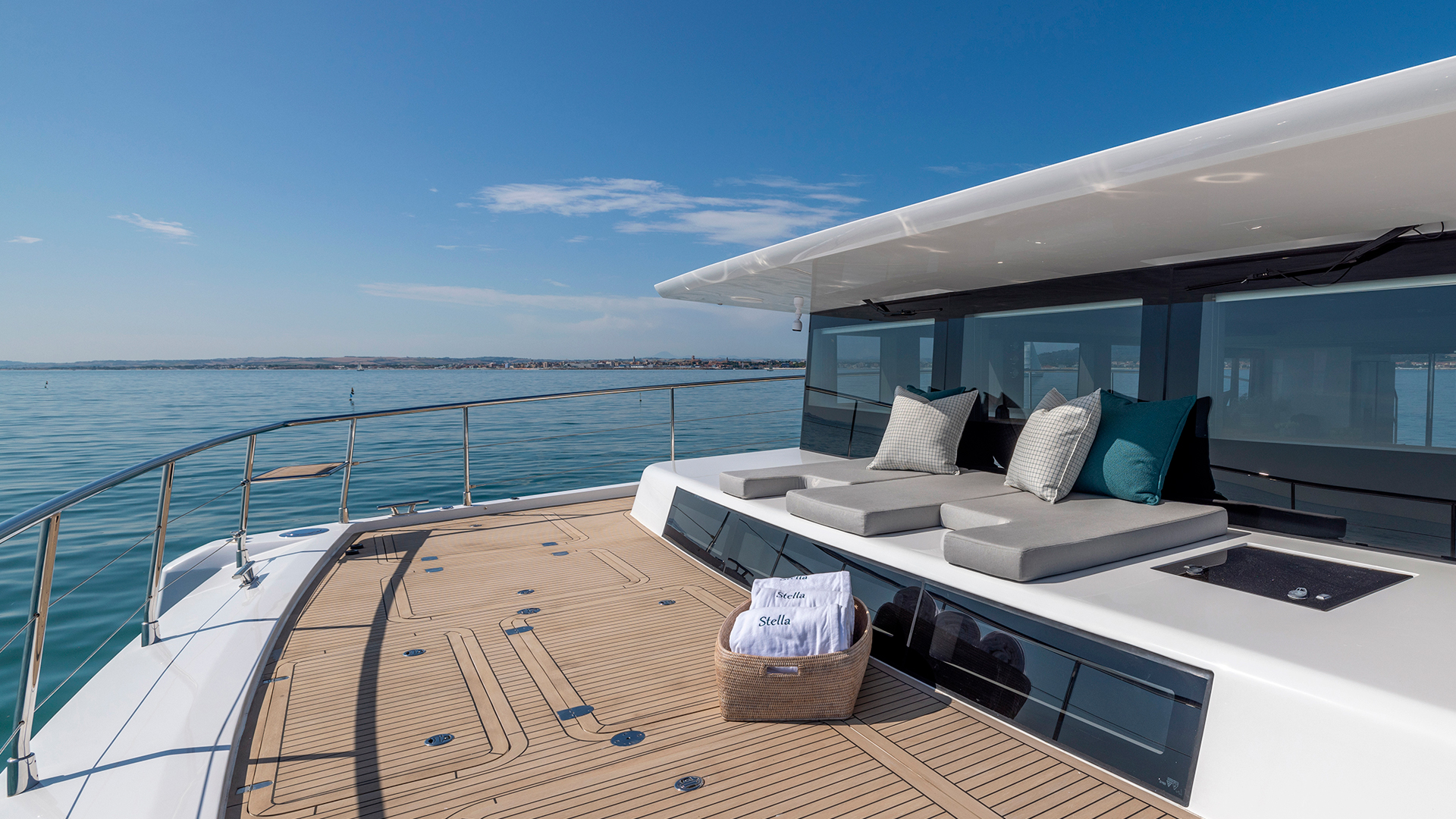
Front Master Version
- Available for every deck option (flybridge, 3-deck open & 3-deck closed versions)
The Master cabin is located below the bow in the front of the main deck. This replaces the additional exit in the front of the salon.
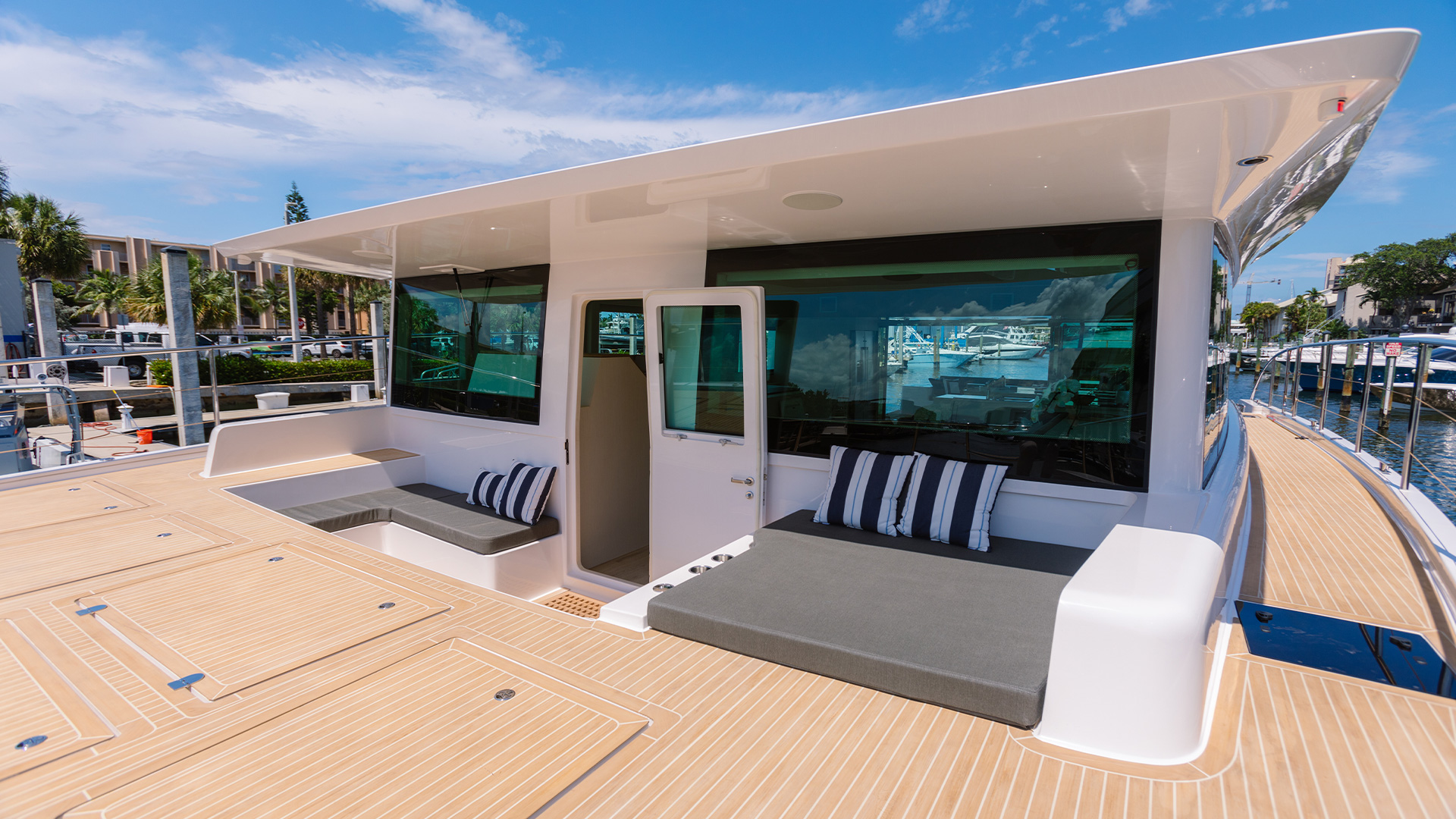
Front Exit Version
Hereby the salon on the main deck is equipped with an additional exit in the front. The Master cabin moves to the side of the hull in the lower deck.
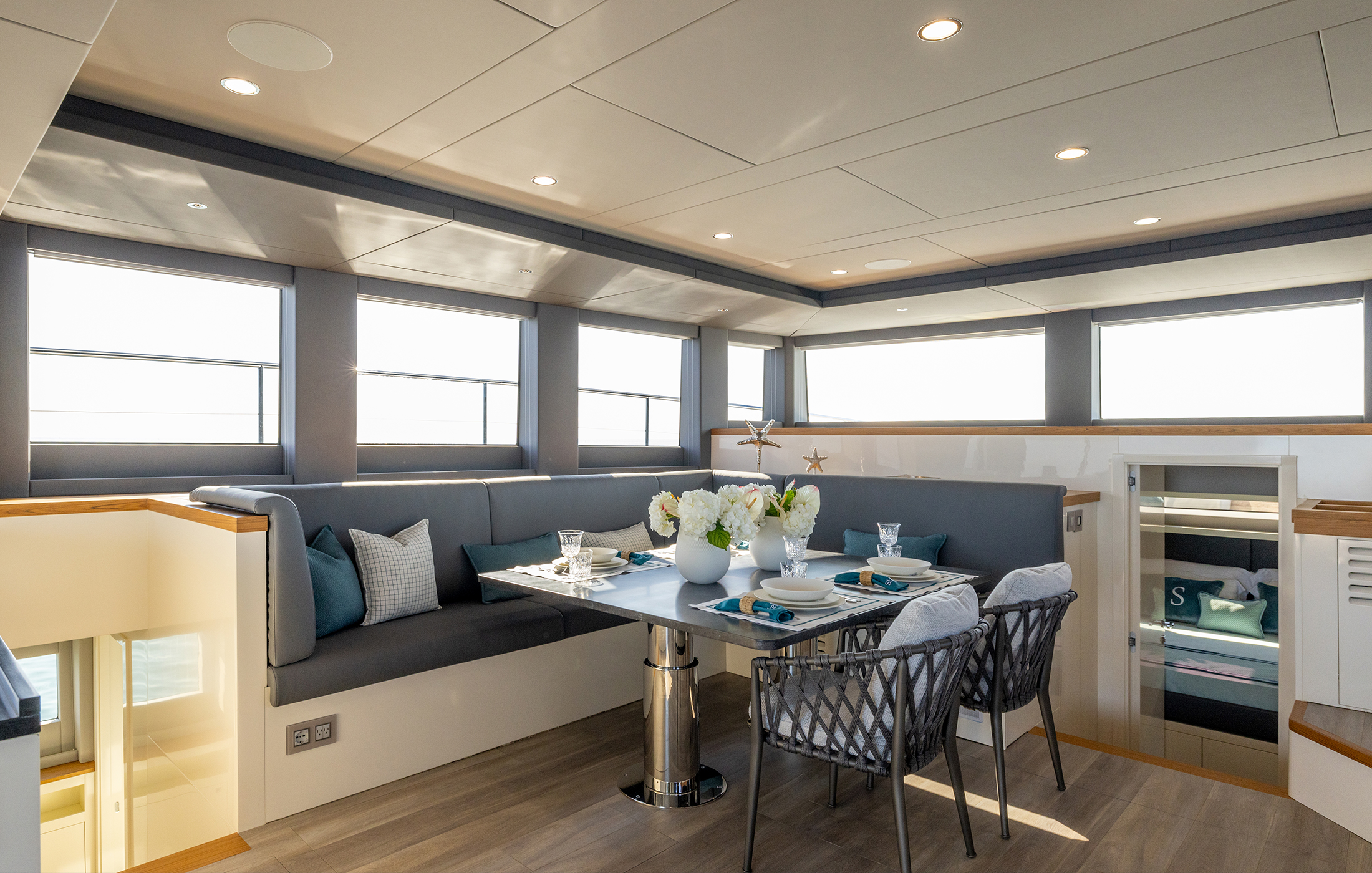
3-Deck Open
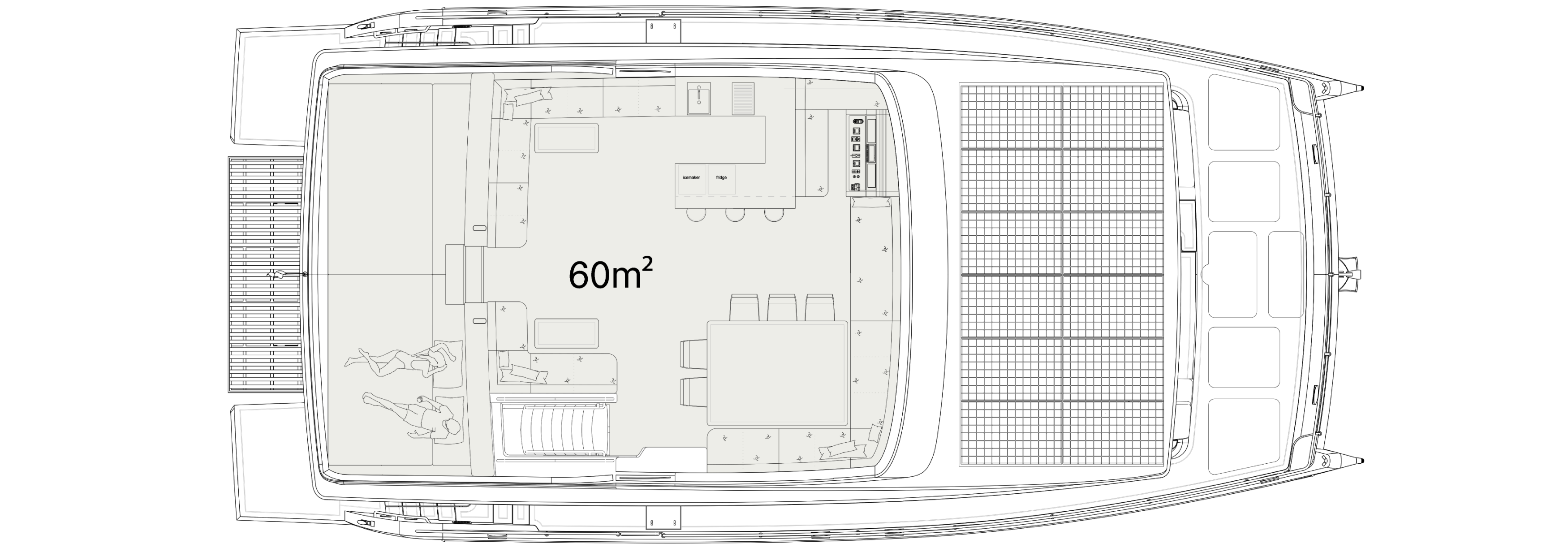
3-Deck Closed
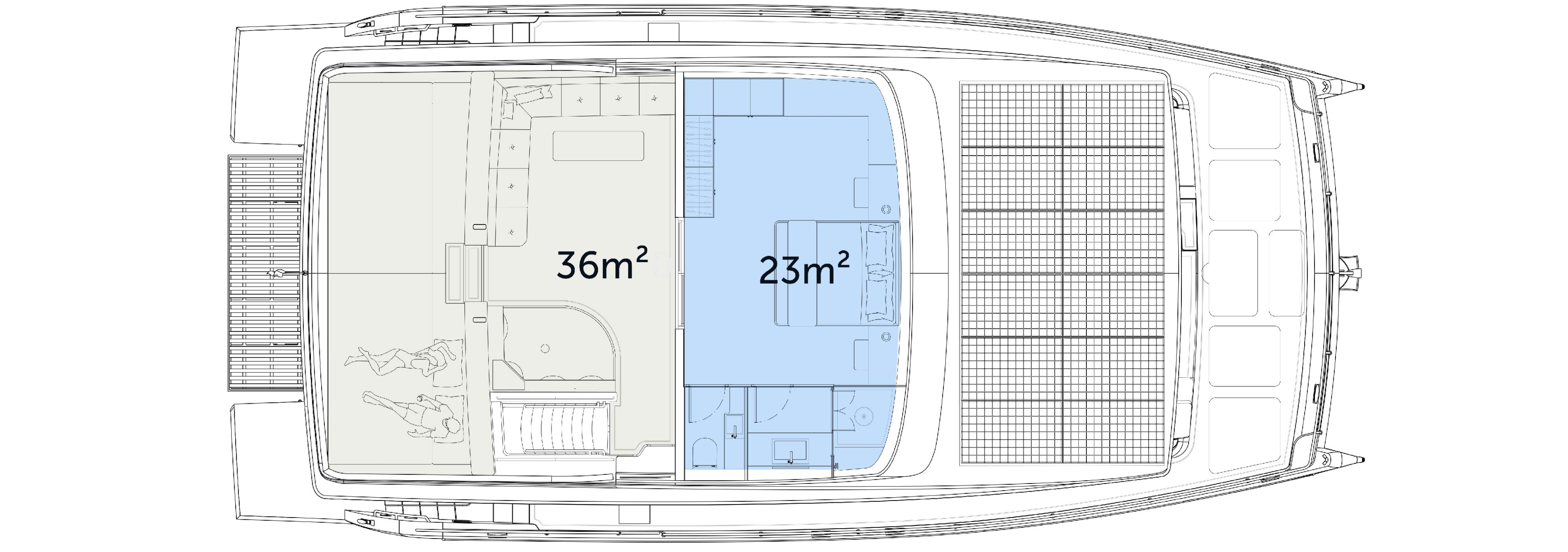
Front Master
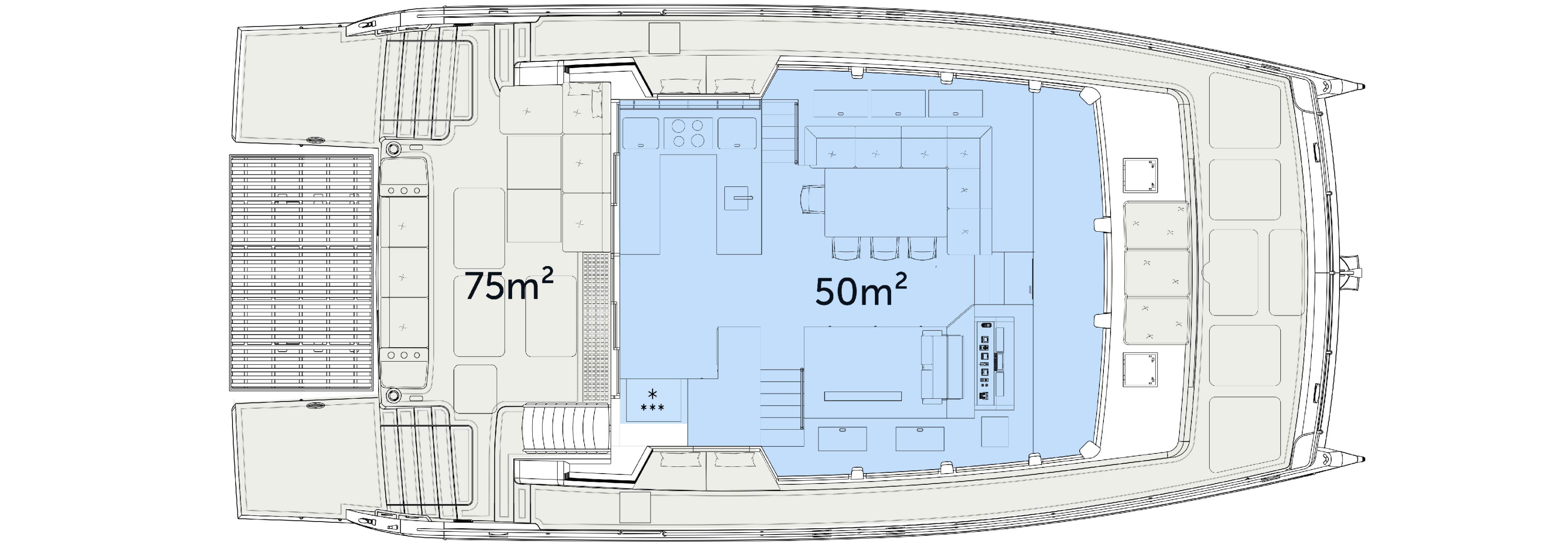
Solar-electric yachting advantages
Unlimited range, noiseless cruising, zero emission, minimal maintenance, powertrains, 6o series highlights.
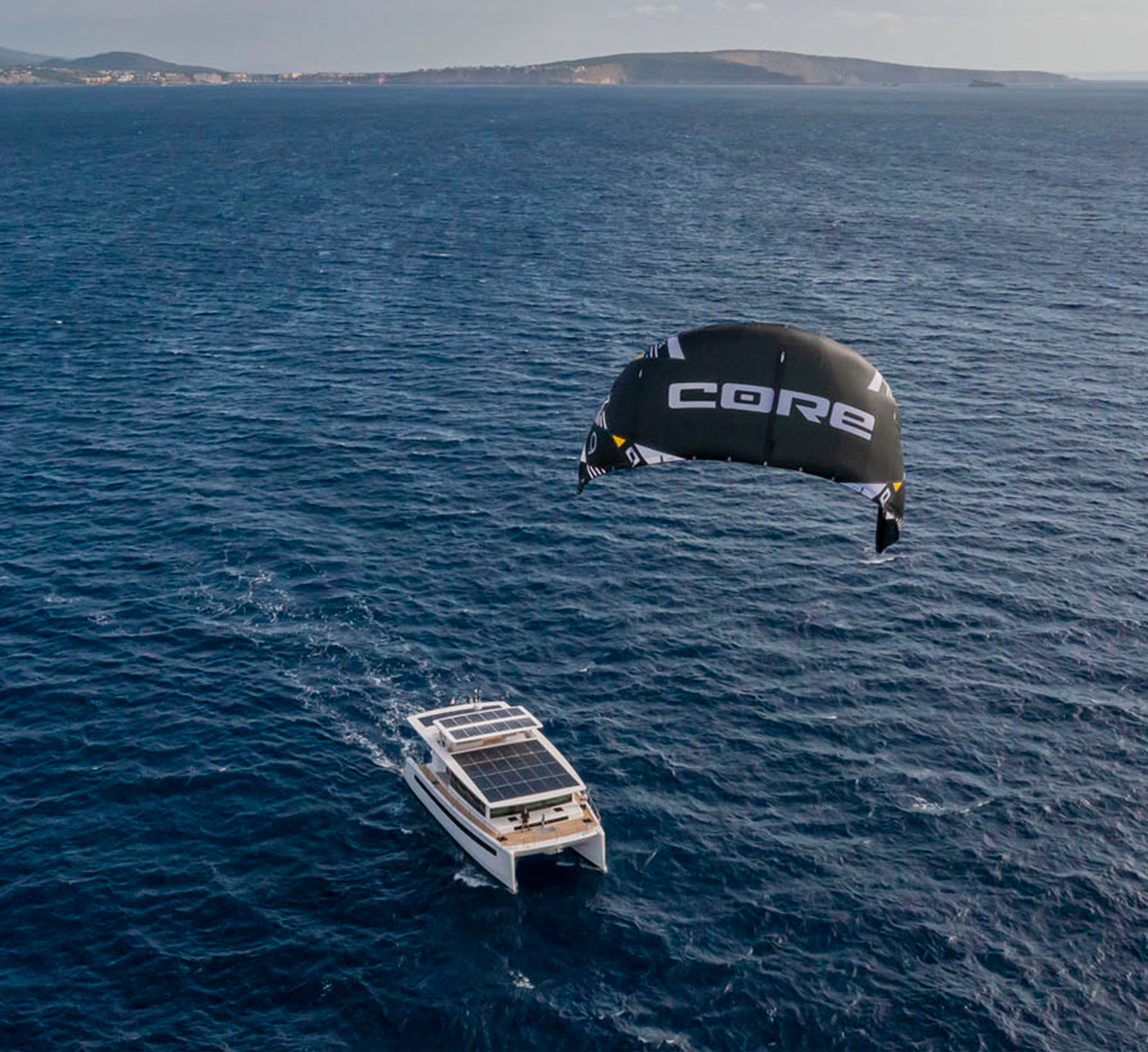
Kite sail system
Adding the option of a fully automatic towing kite gives the 60 Series the opportunity to make use of the wind without shading the panels. The either 9m² or 12 m² sized kite flies at heights where winds are much stronger, thus being able to create up to 10x more pulling power compared to a conventional sail.
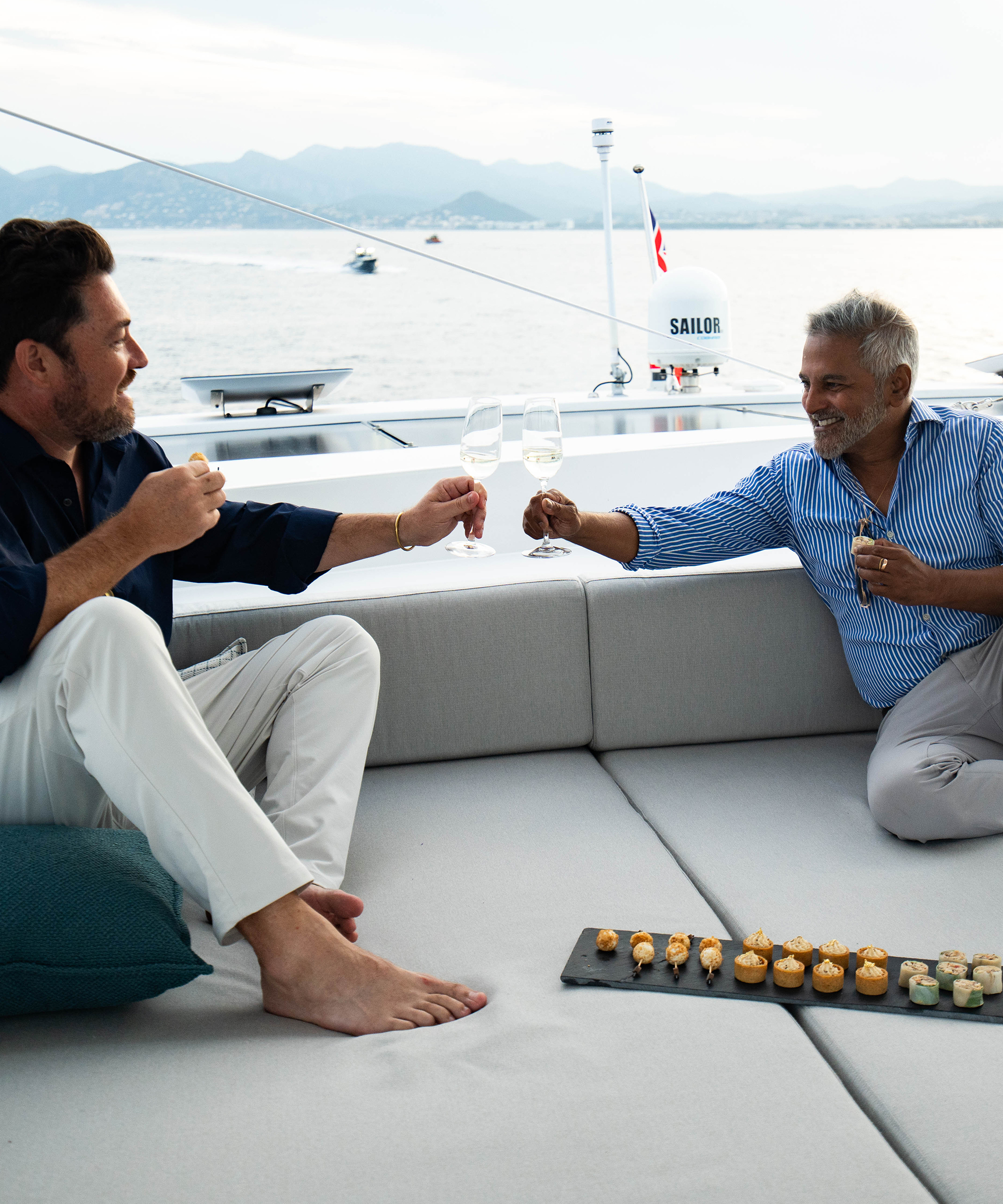
Self-sufficient lifestyle
Designed from the ground up to be fully autonomous. By being able to produce your own energy and water while making use of coolable food supplies for storage as well as a worldwide internet connection, you have the possibility of creating a fully self-sufficient lifestyle on board.
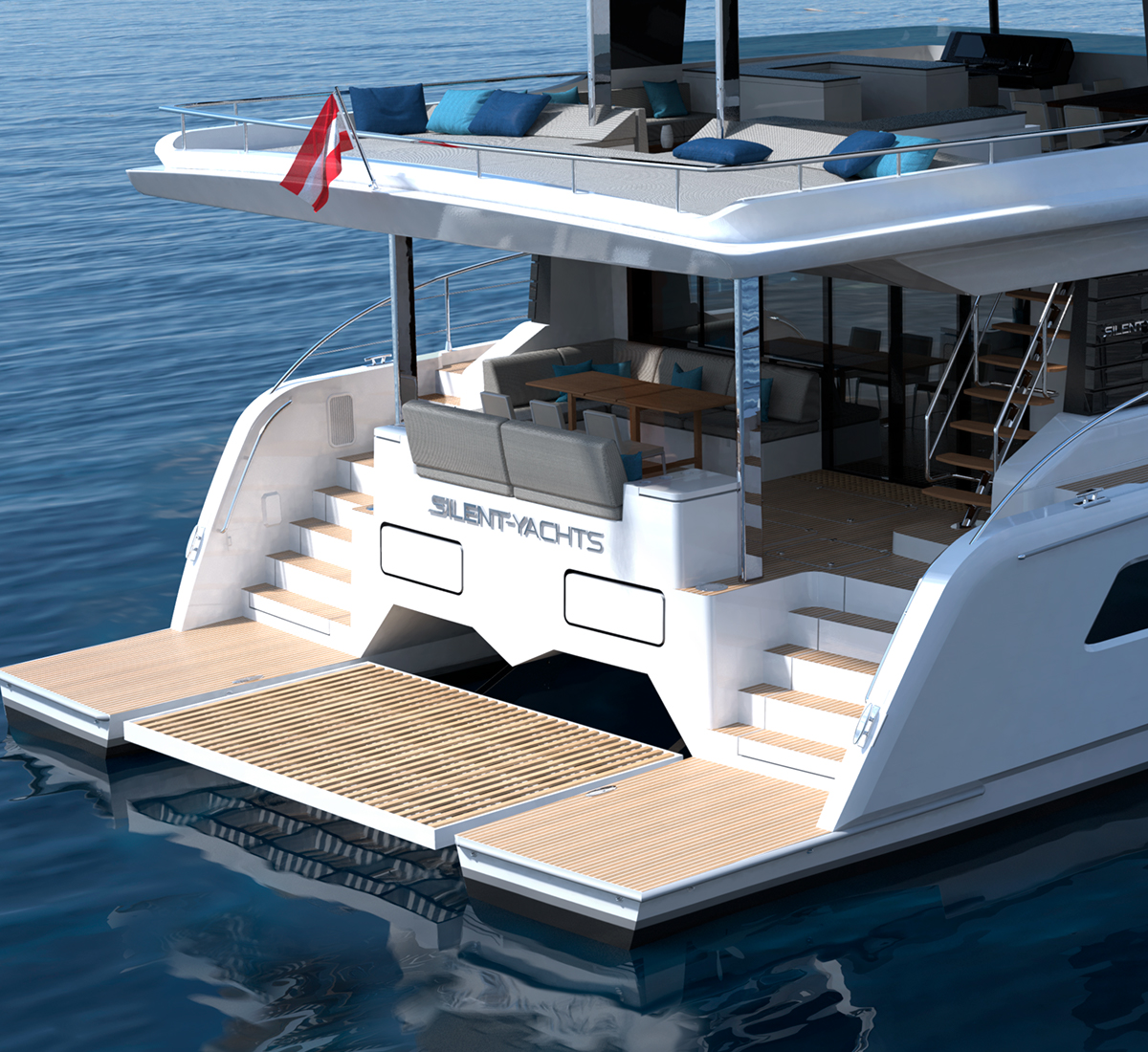
Bridgedeck storage
Under the bridge deck, there are two spacious storage boxes for SUPs, surfboards, small RIBs or compact sailboats. Both of them can be accessed either from the aft cockpit deck or directly from the hydraulic tender lift.
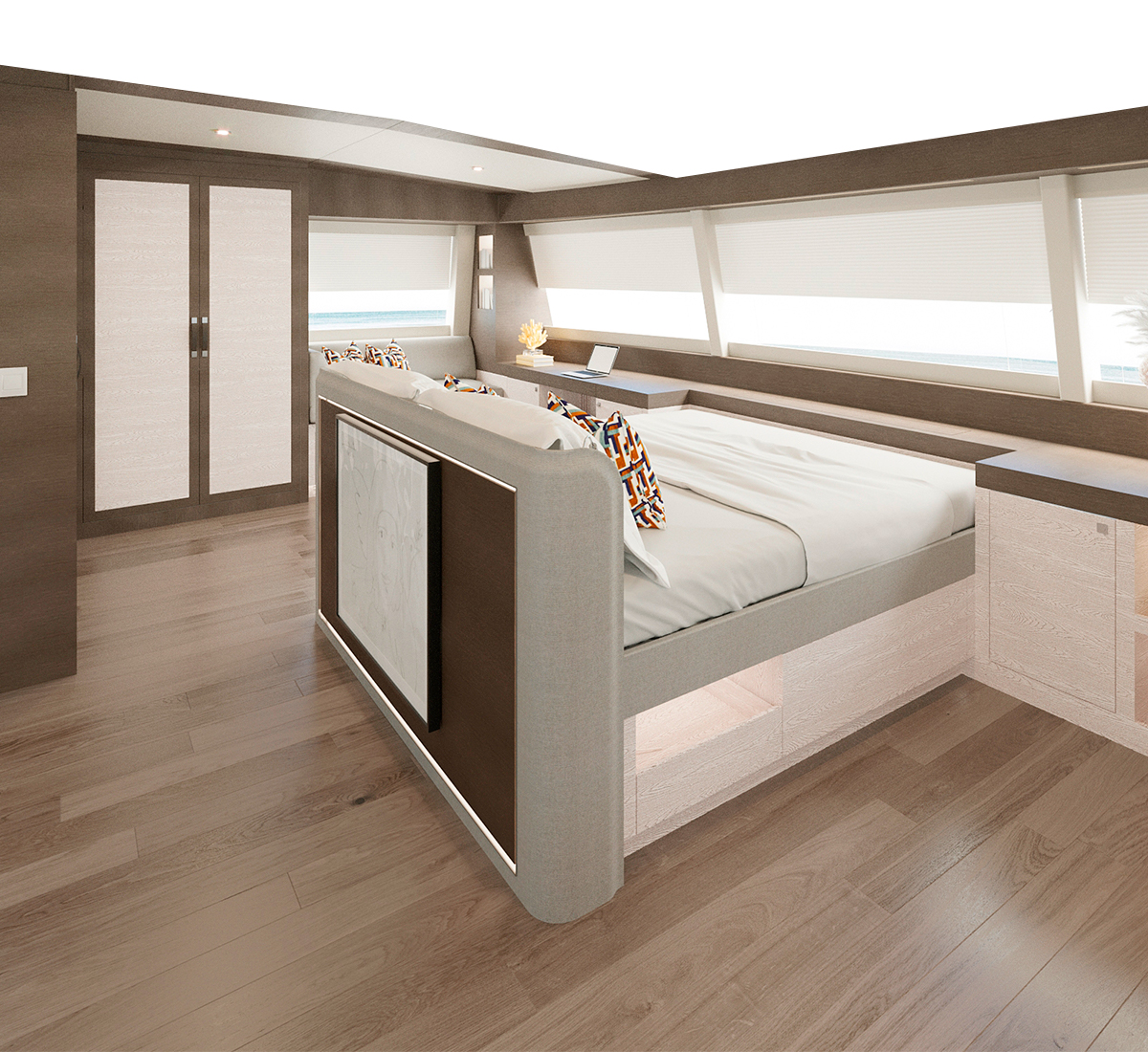
Owner's suite
Being able to design the 60 Series with an exclusive owner’s suite on the 3rd deck us unique amongst 60-foot catamarans. The suite itself is fully equipped with an en-suite bathroom and measures 23 m² in size. It also gives direct access to the 36 m² lounge area in the aft.
8 Years Warranty Battery Banks
4 0 years warranty solar panels, lifetime warranty electric motors, ce-a category certification, ocean crossing capabilities.
If you would like to enquire about this electric yacht and get in touch with a member of our team, please click on the button below.
Other models
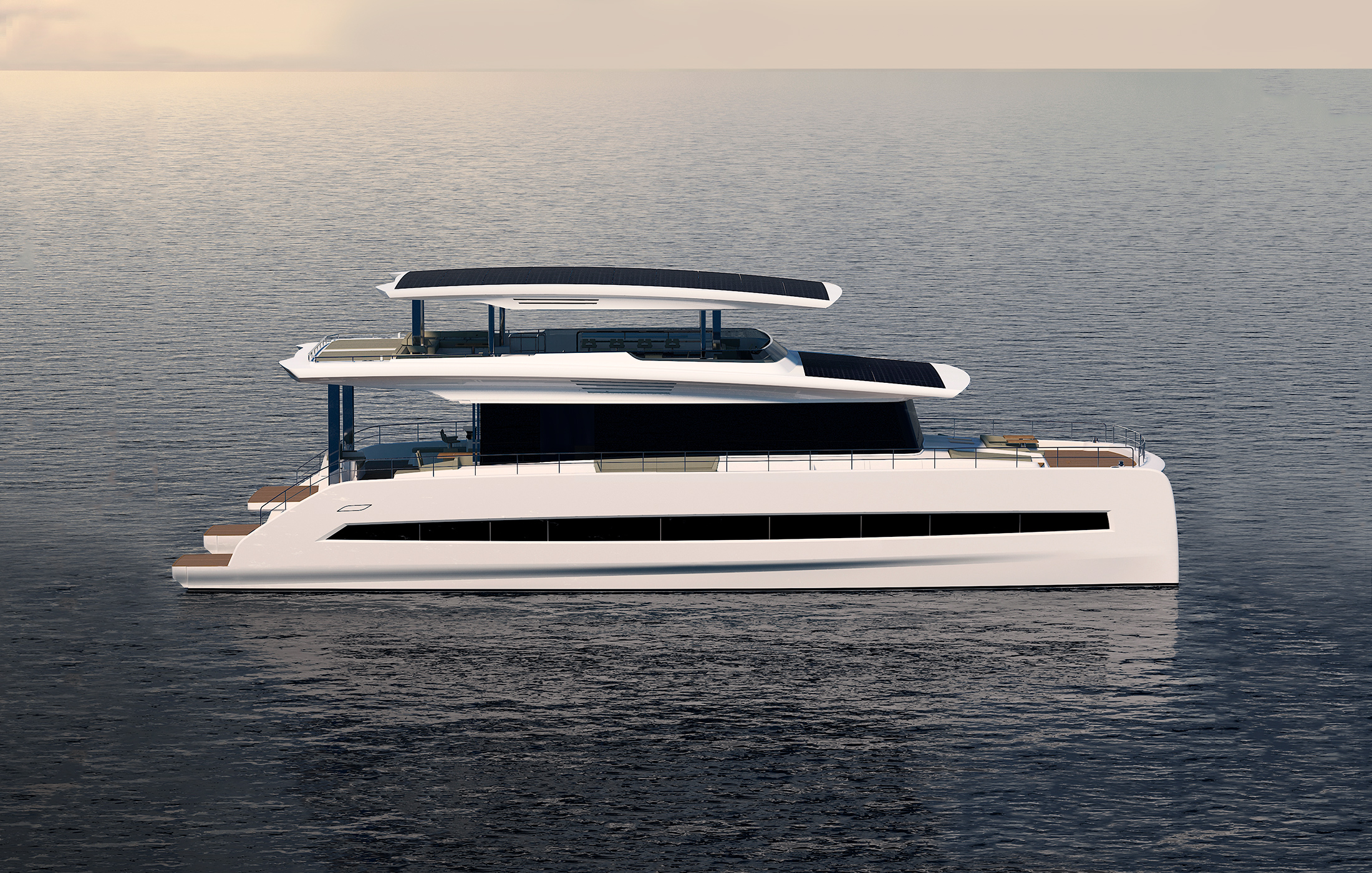
120 Explorer
Silent Group
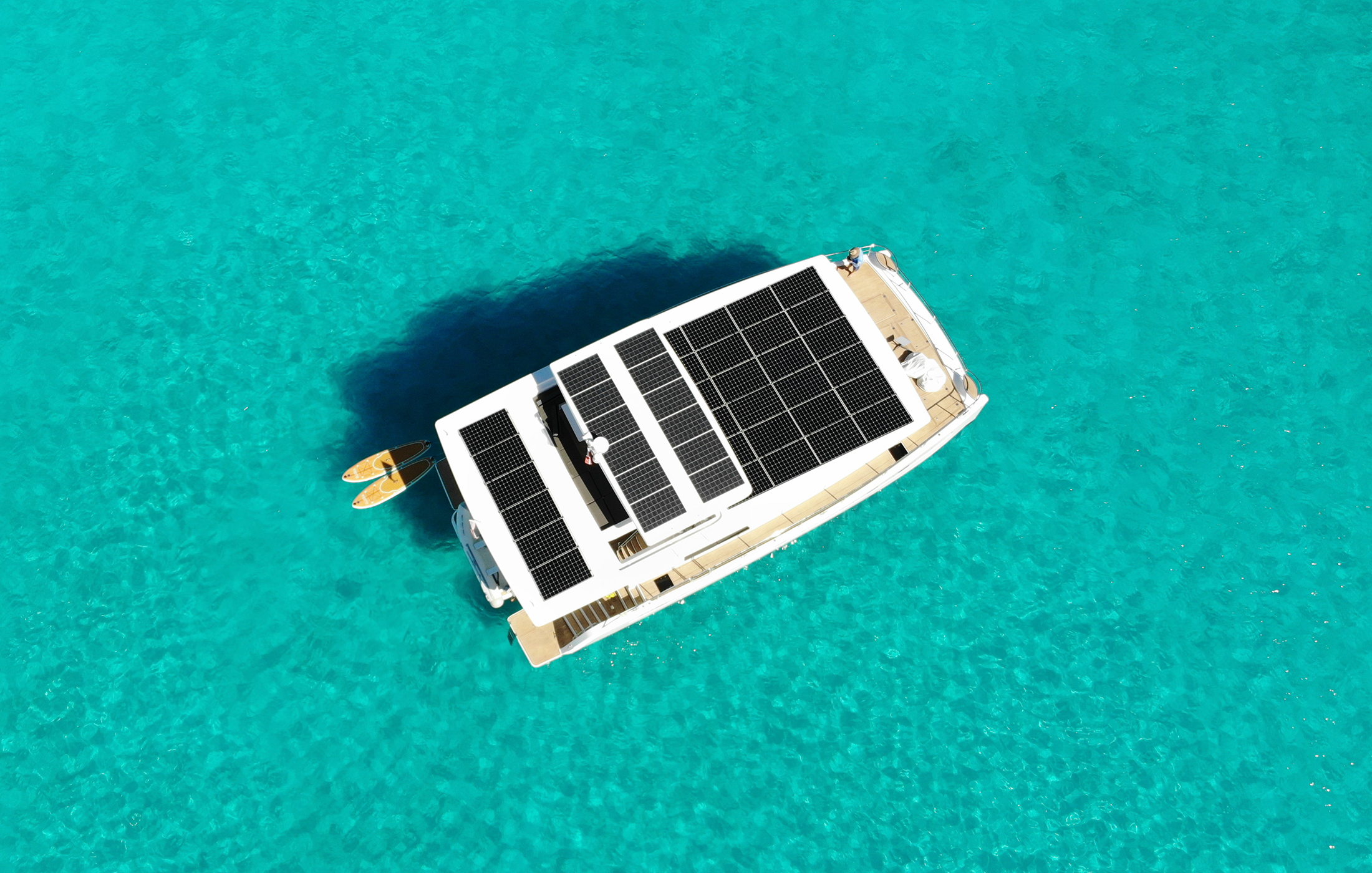
Our charters offer you the opportunity to book a memorable vacation on board of our electric yachts. Including our helpful crew, consisting of a captain and a chef, you will experience the comfort of solar powered yachting.
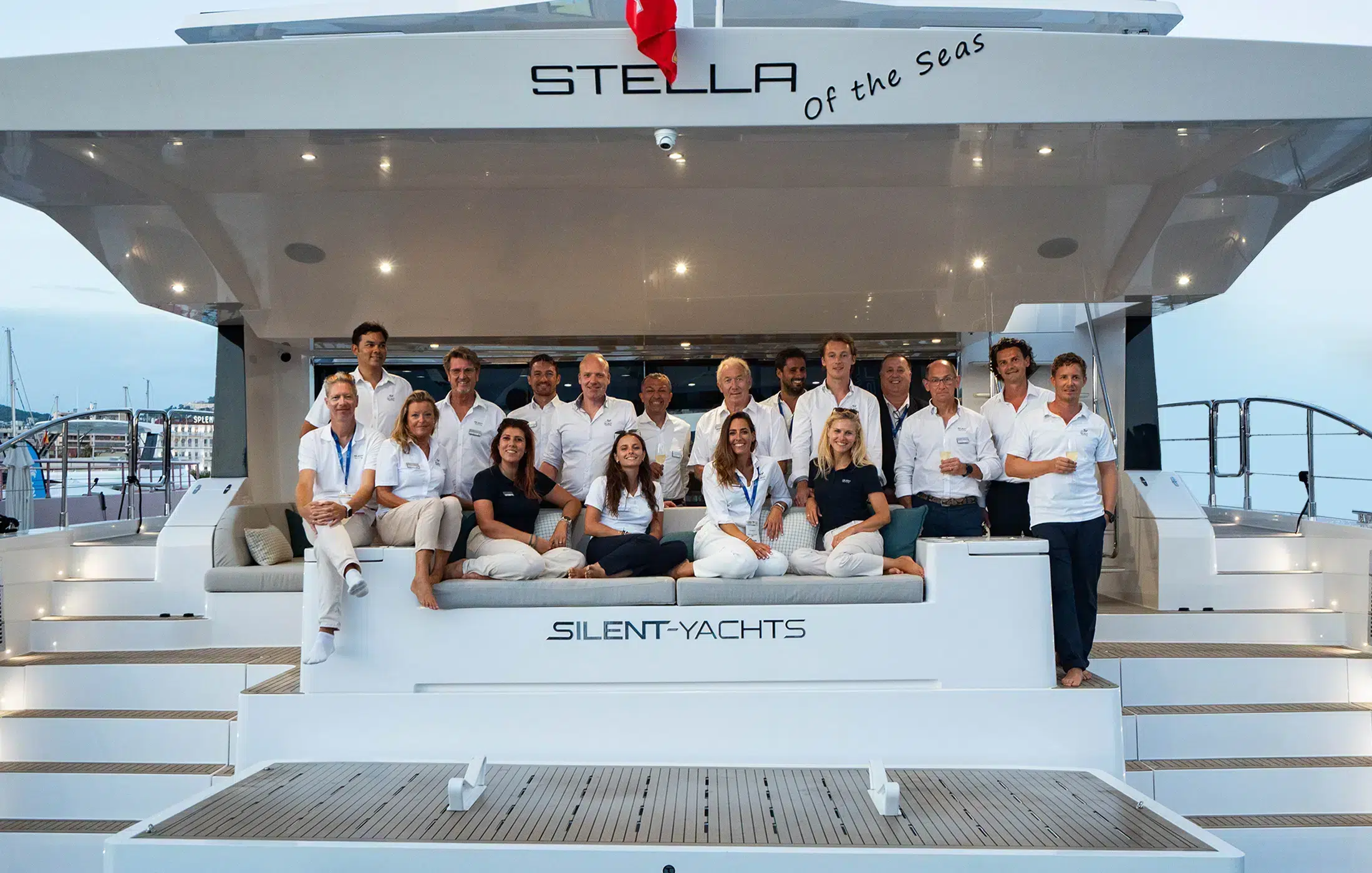
As the pioneers of solar yachting, we have almost three decades of experience regarding the research, design and build of electric yachts. Our team, shipyard and the hiring of new talent are the backbone of our operations.
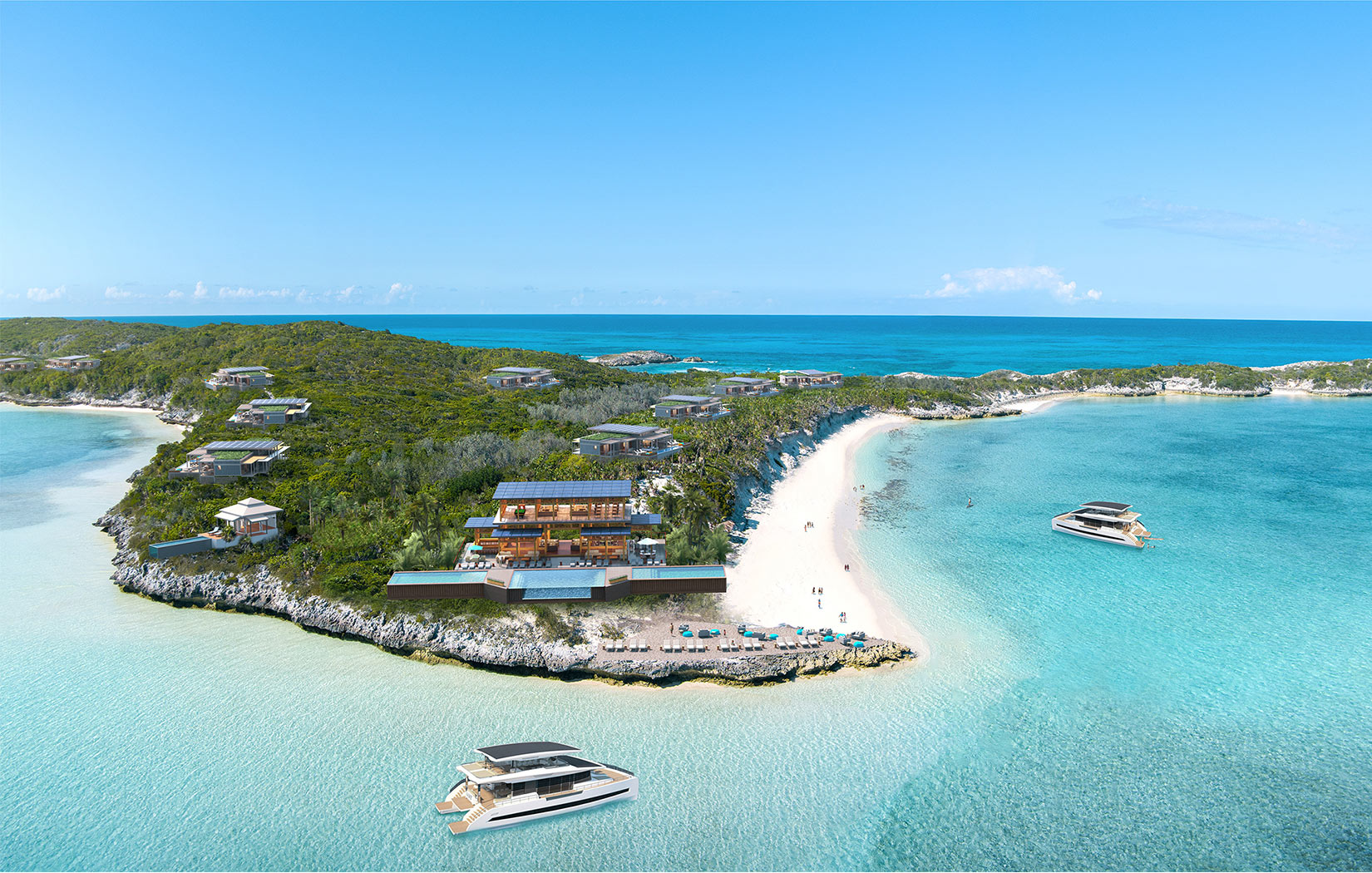
By transferring our solar yachting technology, Silent Resorts develops sustainable beachfront resorts in beautiful locations worldwide. Memberships offer full or part ownership of an eco-property and a Silent yacht.
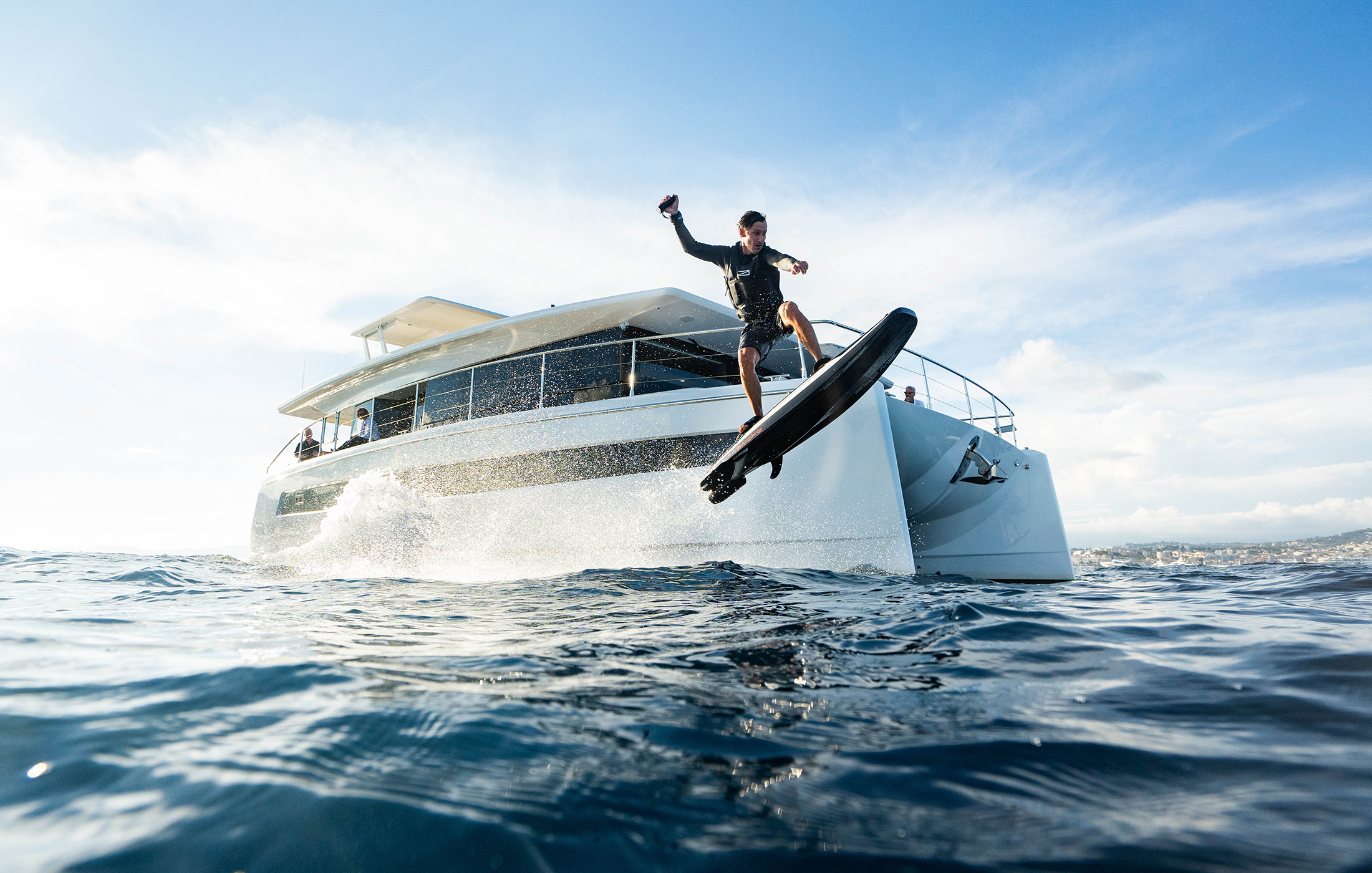
Create your infinite playground on the water. A selection of premium electric water toys, which can be recharged by simply connecting them to your Silent yacht, as well as other accessories for the ultimate experience on board.

The ZEN50 is a game changer. World’s first series production catamaran equipped with a wingsail, it defines a new distinctive class of its own, where genuine zero-emission meets high comfort and performance, limitlessly.
Designed from scratch for ZEN Yachts by award-winning naval architect Julien Mélot , this full carbon catamaran is the ultimate essence of technology driven, high performance and luxurious, eco-friendly leisure yachting.
The blue water capable ZEN50 lightweight racing carbon hulls are combined with a huge solar roof for an unrivaled solar power vs. displacement ratio above 1:1 (18 kW / 17 tonnes), making this yacht completely energy self-sufficient. A revolutionary, fully automated, wingsail - by Ayro© - can be added as a range and speed extender. The yacht’s high capacity battery bank powers a powerful silent electric propulsion, allowing the ZEN50 to achieve 14 knots and maintain high continuous speeds in unrivaled safety and comfort, indefinitely…
The ZEN50 is offered with or without wingsail and comes in 3 main different versions: Racer, Cruiser and Explorer, each dedicated to a different usage and owner profile. We use these versions as a basis to define a final, bespoke specification for each of our valued clients and ZEN Community Members. Scroll down for more details, specifications and prices.

1st WINGSAIL series production yacht in the world!
The OceanWings32 - by Ayro© - was initially developed for Team Oracle, for the America’s Cup 2010 in Valencia. Over years, it has further been developed and automated by VPLP and was installed on Energy Observer in 2019. Two years of field feedback have allowed the Ayro team to fine tune the algorithm commanding the wingsail. The ZEN50 is the first series production leisure craft to be equipped with this fully automated wingsail. It is controlled at the touch of a finger on screens, is automatically adjusted and has several safety modes and features. The two parts of the wingsail can be hoisted and lowered independently and with the simple touch of a button. The wingsail OceanWings32 is the ideal complement for the solar roof for those wishing to cruise long distances off-shore with zero-emissions.
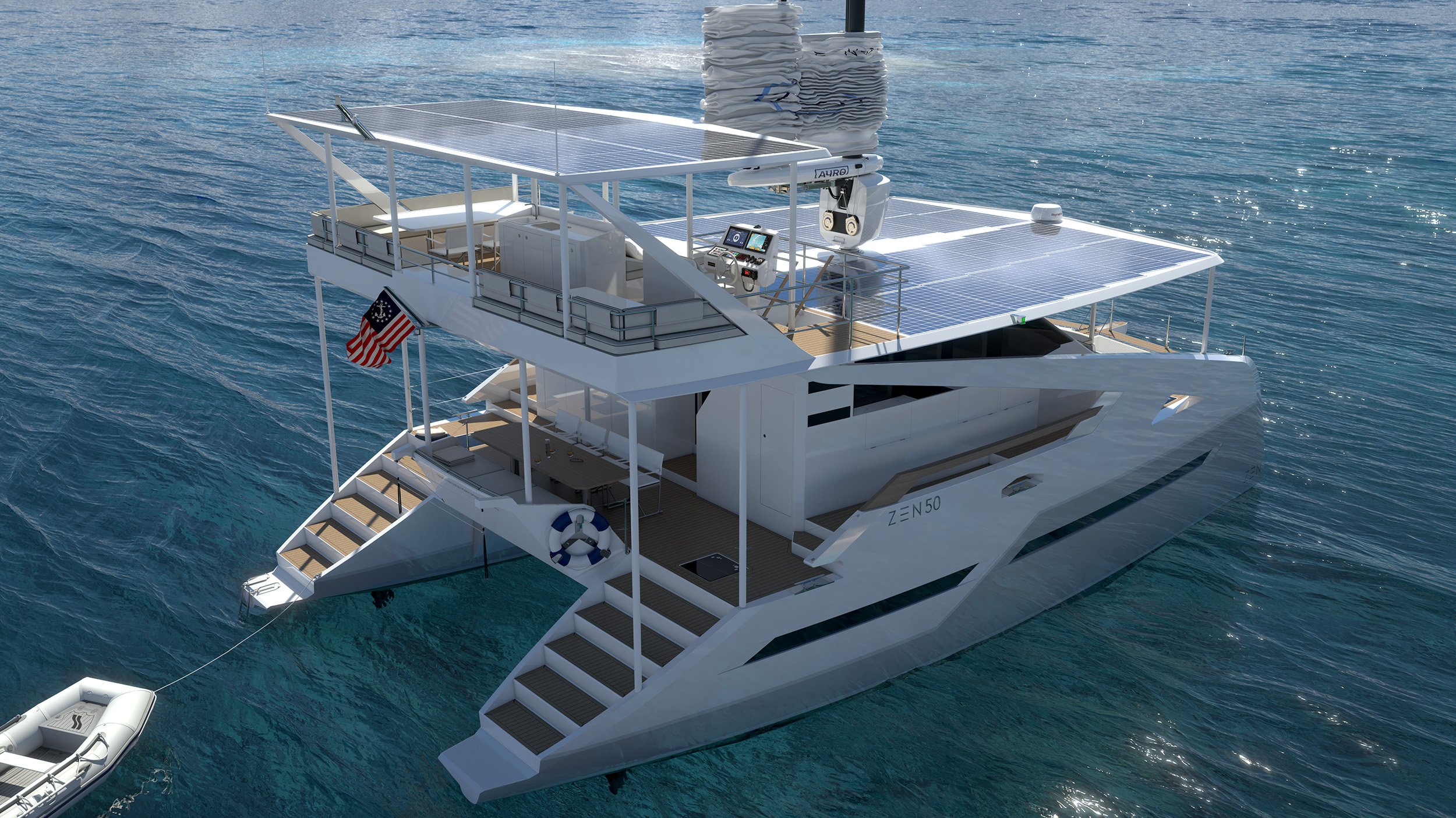
Greatest ratio SOLAR POWER / weight on the market
At 17 tonnes lightweight and 18,000 W of peak solar power, the ratio of the ZEN50 is at over 1 kW per displaced tonne of water or beyond 1:1 which is far beyond any other blue water CE Cat A yacht in this size range. Lots of solar power for little water to displace is the strong and healthy foundation the energy self-sufficient ZEN50 is built upon.
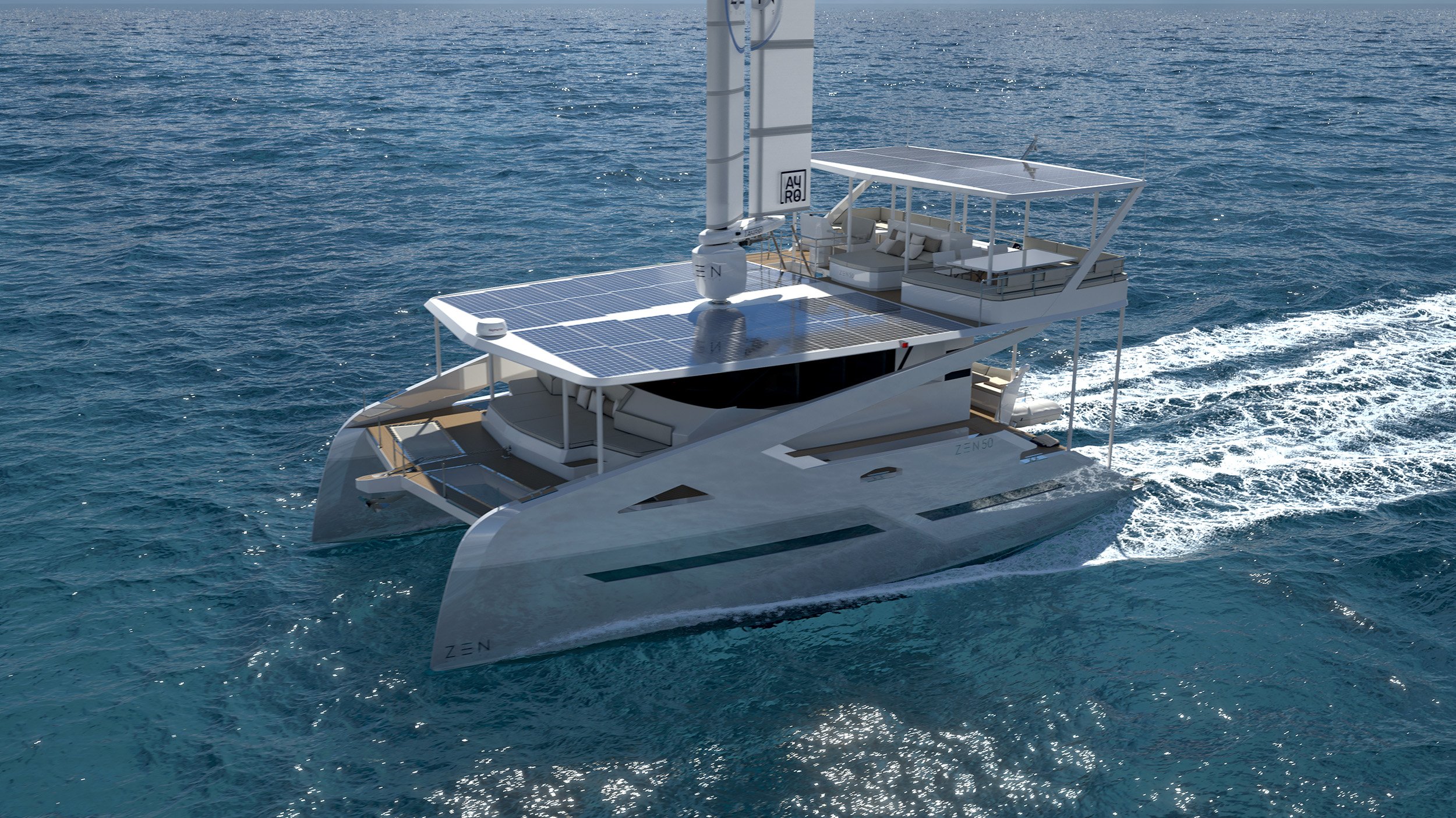
Performance CARBON sandwich hulls
The hulls of the ZEN50 have been designed from a blank screen for ultimate efficiency - understand minimum drag or minimal energy consumption for a range of speeds from 6 to 10 knots. Their shape is aggressive, sharp and slender. Their reverse bows cut through water like a sword cuts through butter and their curvature is reminiscent of graceful dolphin bodies. These hulls are undoubtedly of the performance type and are built with the best available composites: Carbon fibre and Corecell™. The combination of high strength, low weight and performance design allow the ZEN50 to reach speeds of up to 14 knots.
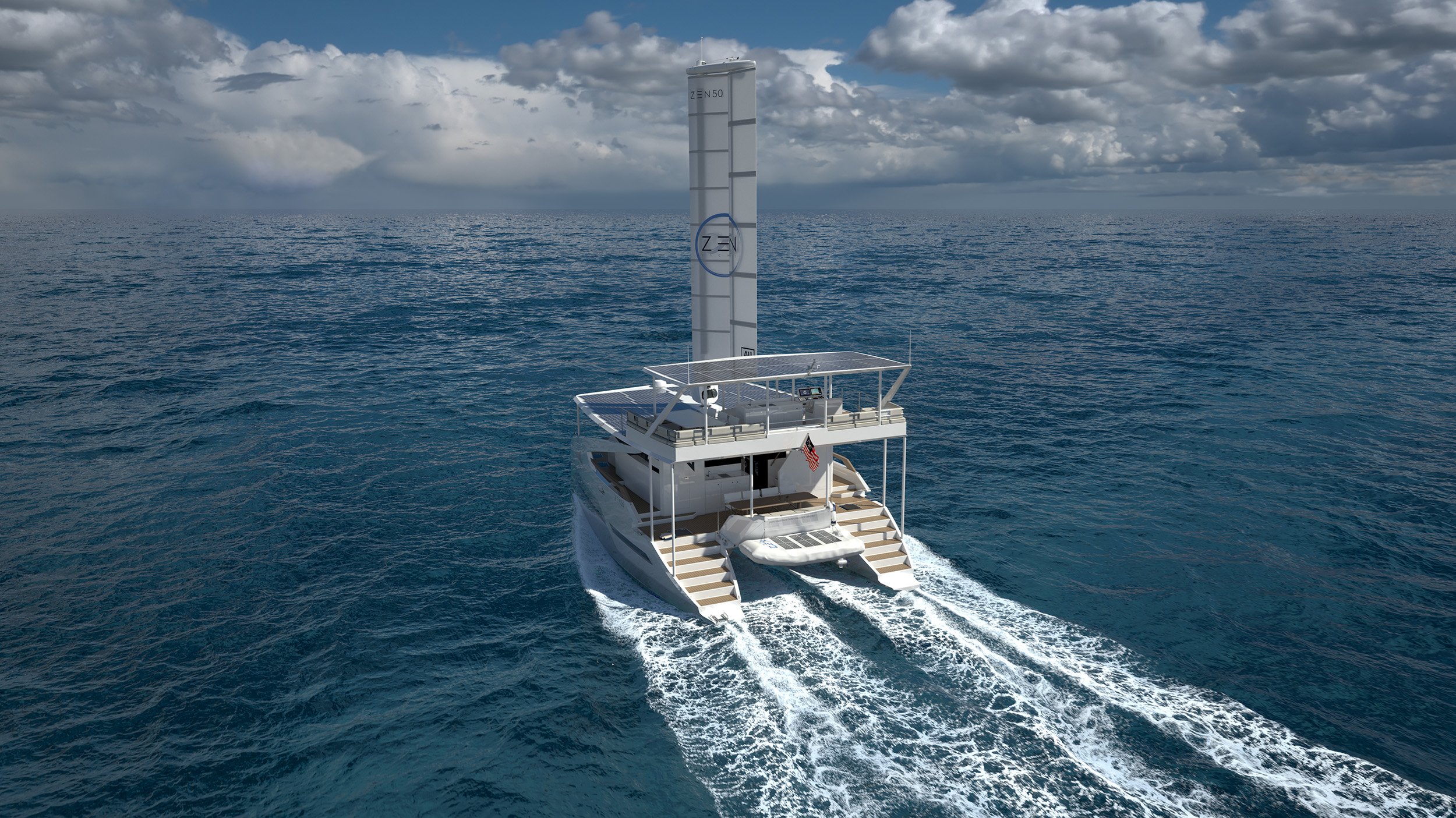
INFINITE range at high CONTINUOUS speeds
With maximized solar and wind power and minimized energy consumption… the ZEN50 can sail continuously at speeds varying between 6 and 10 knots. Thorough simulations in various sea states and weather system have consistently shown the ZEN50 will be able to achieve performance catamaran speeds continuously without using a genset. With the ZEN50, the world is your oyster and the wildest destinations are within your reach with this self-reliant vessel!

True ZERO-EMISSION operation
The first ZEN50 unit, whose construction started in March 2023, will not be equipped with a genset at all and will not have any fossil fuels onboard. The ZEN50 energy system with its very large capacity 160 kWh battery bank, has been designed to function for days in complete safety with minimal solar energy harvest and no wind. It is perfectly safe with no backup genset and operates 24/7 without any polluting emissions.
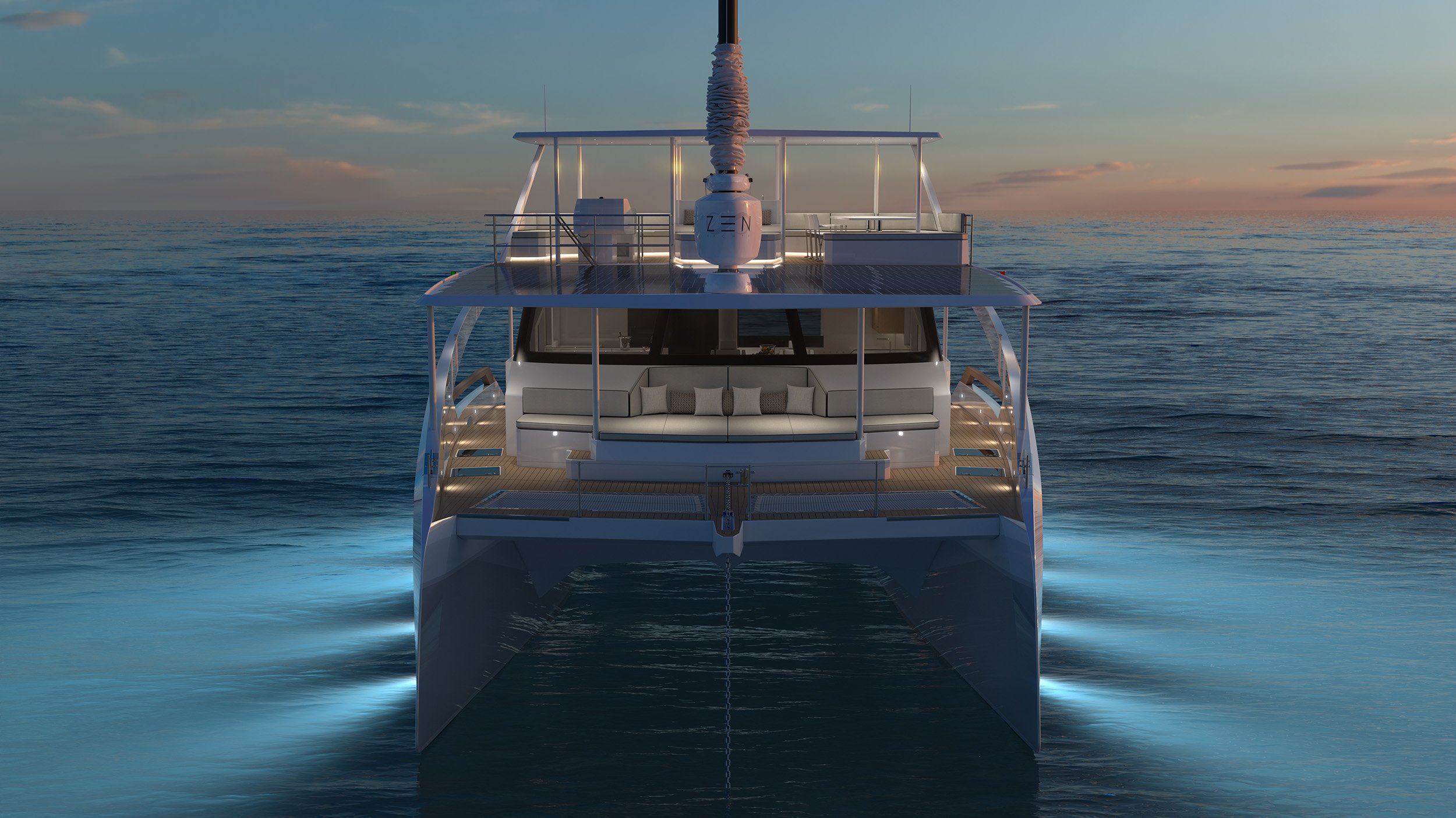
NO FUEL , no costs
Naturally, requiring no fuel to operate day in day out is great news for the environment, it is also fantastic news when sailing into remote areas where fuel bunkering might be near impossible or where the fuel quality might be an issue. Finally, it also makes a massive difference in this yacht’s costs of operation. Imagine the hundreds of liters of diesel saved over just a week, the obsolete engine maintenance schedules, the clogged filters and dirty tanks from another age… Welcome to a new burden-free, energy self-sufficient era, welcome to clean and graceful eco-yachting, welcome to ZEN Yachts.
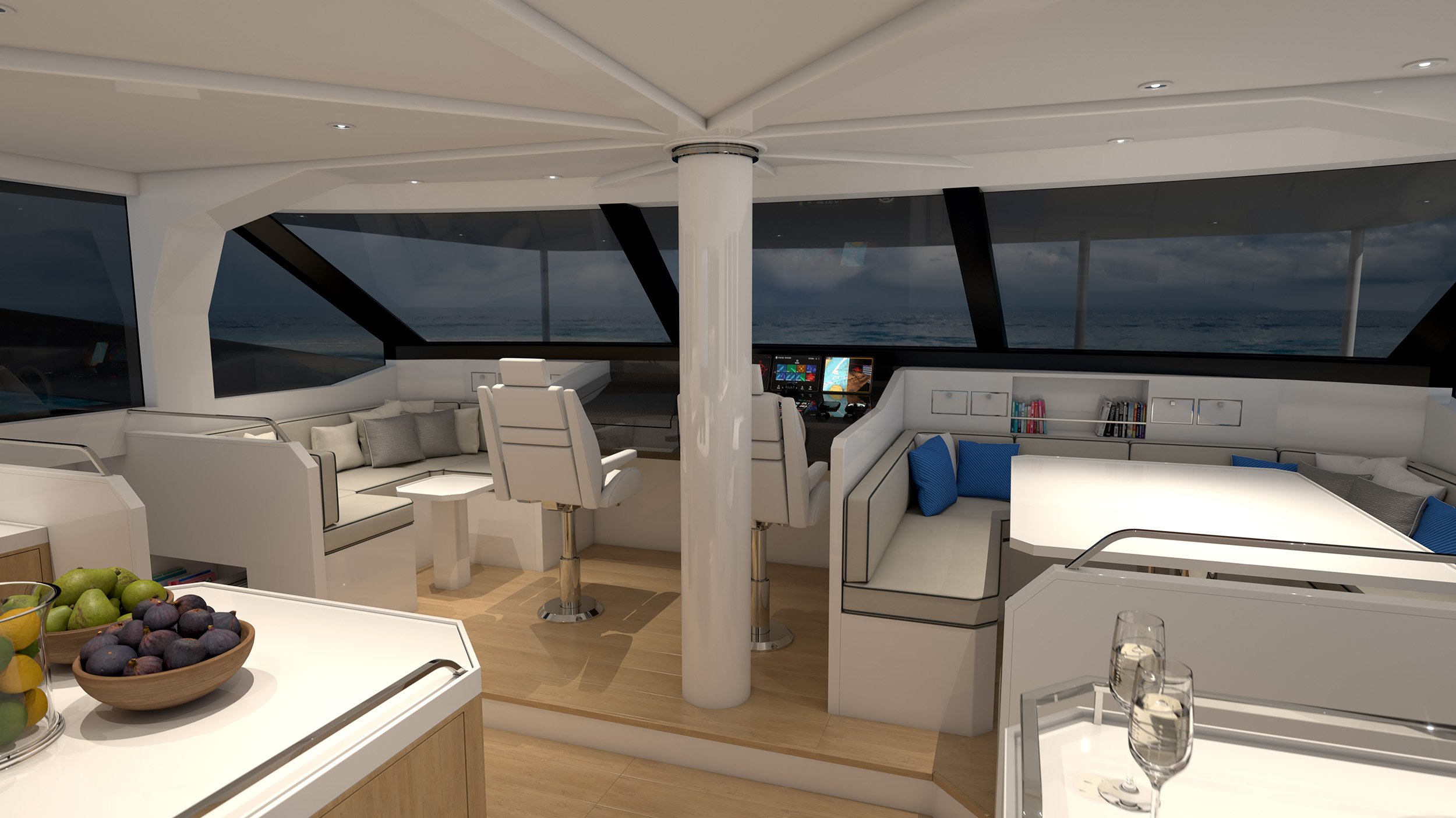
Highest SAFETY & reliability
At ZEN Yachts, we have made some design choices to attain energy self-reliance with the ZEN50 that reduces the habitable volume in the hulls, similar to performance catamarans. Where we have not and will never compromise is on safety. Our main voltage system is 48V making it perfectly safe to work on. The level of redundancy of the batteries and solar panels is 10! The main electrical architecture is split in 2 so that should anything happen on 1 hull, the entire vessel can still operate normally. There are 2 independent helm stations and the ZEN50 is packed with special safety features, nonsubmersible compartments and we can even offer an in-depth practical course on safety equipment usage and management. Sailing with the ZEN50 is not only exhilarating and clean, it is ultra safe!
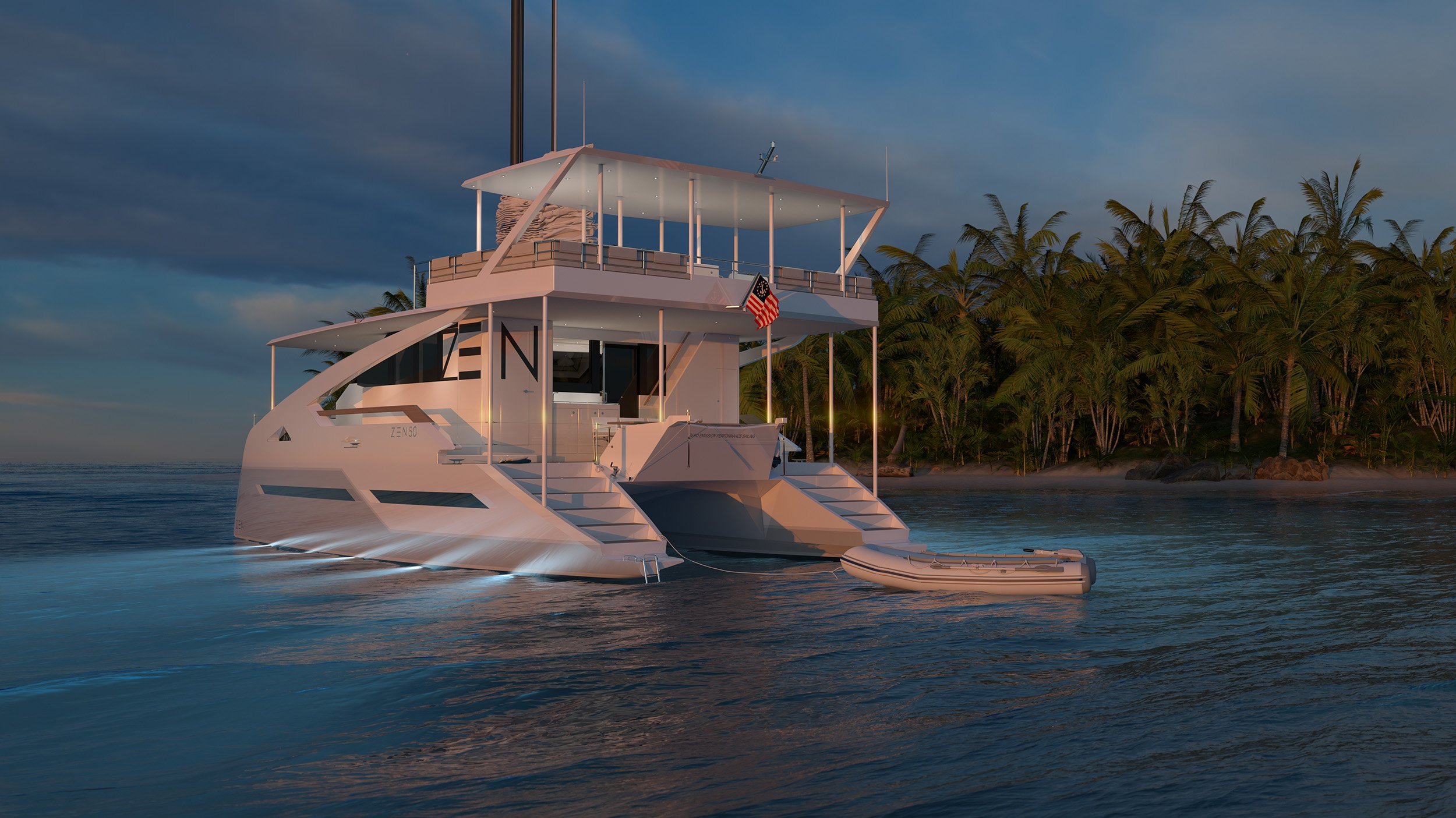
Unrivaled space & COMFORT
The ZEN50 offers the speeds of a performance catamaran, the comfort of a large motor yacht and the simplicity of an electric car. No less than 2 large day beds, 3 dining areas for over 10 people, 1 professional galley and 2 wet kitchens, 5 heads, up to 4 double ensuite cabins, 1 bunk double and 1 single together with both saloon and dining areas converting into extra sleeping areas, this is simply unrivaled on a 50 ft. catamaran. Add an electric tender, dive compressor, satellite internet, 2 helm stations (cockpit and flybridge), a solar roof that converts into a gigantic upper deck to enjoy the most epic sunrises and sunsets, welcome onboard the ZEN50!
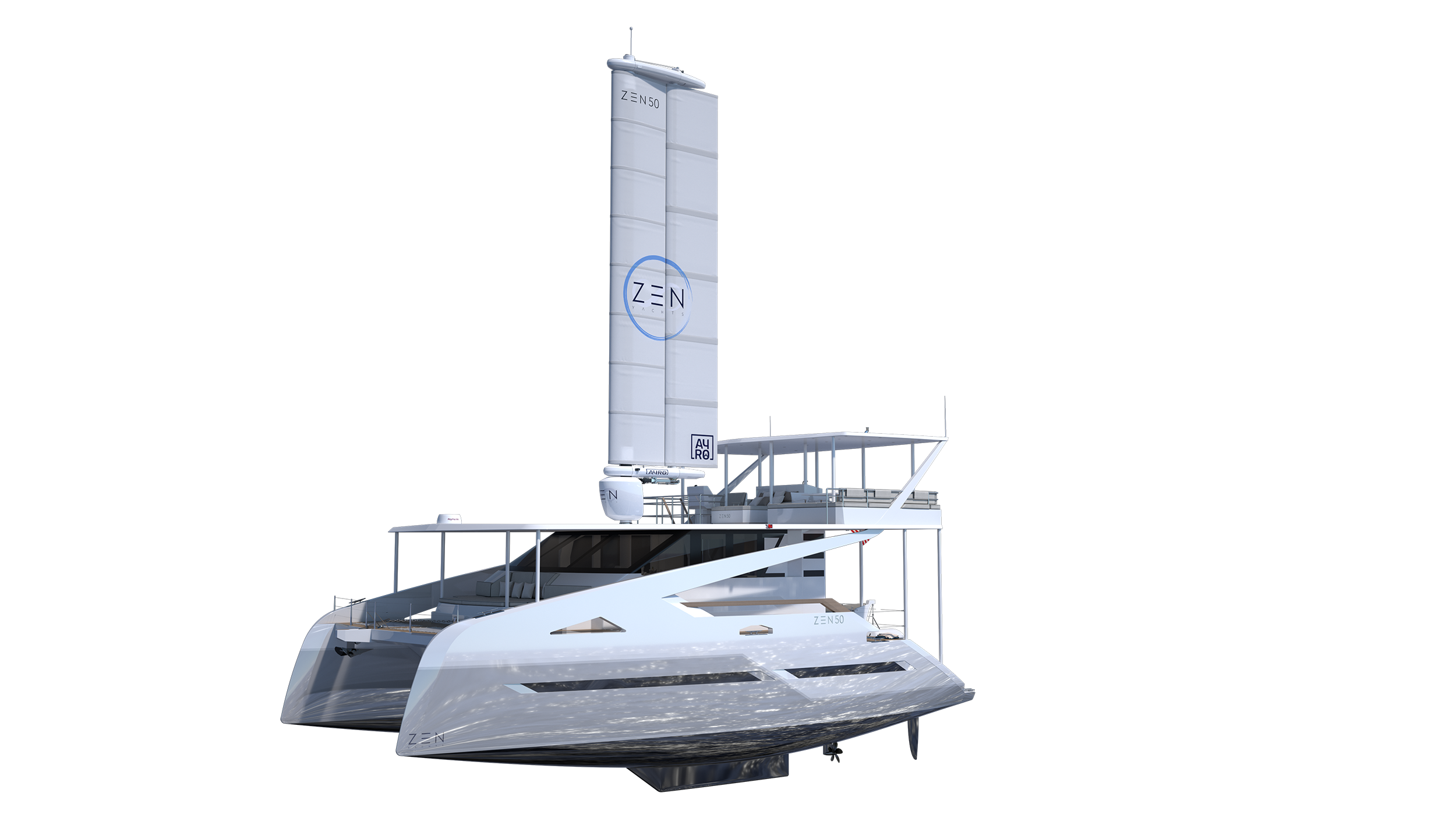
SPECIFICATIONS
Main particulars.
• Length Over All: 15.7m
• Beam: 8.4m
• Depth Molded: 2.7m at midship
• Displacement (light) : 17 T
• Draft (design): 1.3m (4.3ft) incl. keel
• Passenger Capacity: 12
• Berths: 12 (4 x double + 2 x single + saloon)
• Building Material: Carbon Fiber - Corecell™ composite
• Certification: CE Cat A - Unrestricted with 12 persons
Note: Some of the above figures may vary between versions
PROPULSION & ENERGY
• Propulsion: 2 x 50 kW brushless DC motors
• Main Battery Pack Capacity: 160 kWh Lithium
• Solar Roof Peak Power: 18 kWp
• Wingsail: Oceanwings® OWS 3.2 by Ayro©
• Backup Battery Pack Capacity (Nav/Com/Wing): 5 kWh Lithium
• Main System Voltage: 48V - Low voltage for total human safety
• Accommodation Voltage: 110V or 220V
SPEED & RANGE
• Max. Speed on e-motor only: 10 kn
• Max. Speed on e-motor & Wingsail: 14 kn
• Cruising Speed for continuous operation - solar only: 4.5 - 5 kn
• Cruising Speed for continuous operation - solar and wing: 6 - 10 kn
• Cruising Speed day time: 8 - 10 kn
• Range Over 24 h: 180+ nm
Note: These values may vary between versions and sea / weather conditions
EQUIPMENT INCLUDED - RACER VERSION
• Integrated power management system
• Solar power & energy storage system
• Electric propulsion system
• By-wire steering system
• Helm stations at cockpit & flybridge
• Galley counters, storage, sink, oven, stove, fridge, freezer
• 4 en suite heads with enclosed shower, toilet, sink & faucet (in each head)
• All cabin furniture (as shown in layouts)
• Aft deck fixed dining table and aft sofa with collapsible back rest (as shown in layouts)
• Fore deck day bed and lateral seats (as shown in layouts)
• Outdoor marine cork decking / indoor saloon natural bamboo decking
• All cushions In/Outdoor upholstered with Sunbrella® fabric
• 6 deck hatches
• 2 x 500 liter (2 x 132 gal) fresh water tanks
• 2 x 100 liter approx. (2 x 26 gal) fresh water tanks + 1 fresh water pump
• 2 x 350+ liter approx. (2 x 92 gal) holding tanks
• Railings, cleats and fore deck trampolines
• Mooring equipment: 33 kg Rocna® stainless steel anchor + 50 m stainless steel chain 10 mm + 150 m nylon rope + e-windlass
• Regulatory navigation equipment including navigation lights & mast
• 2 x chart plotter 16”; 2 x VHF with DSC button
• Regulatory Life Saving Appliances
• Critical spare parts kit
Note: The above equipment is for the Racer version. Cruiser & Explorer versions carry additional equipment
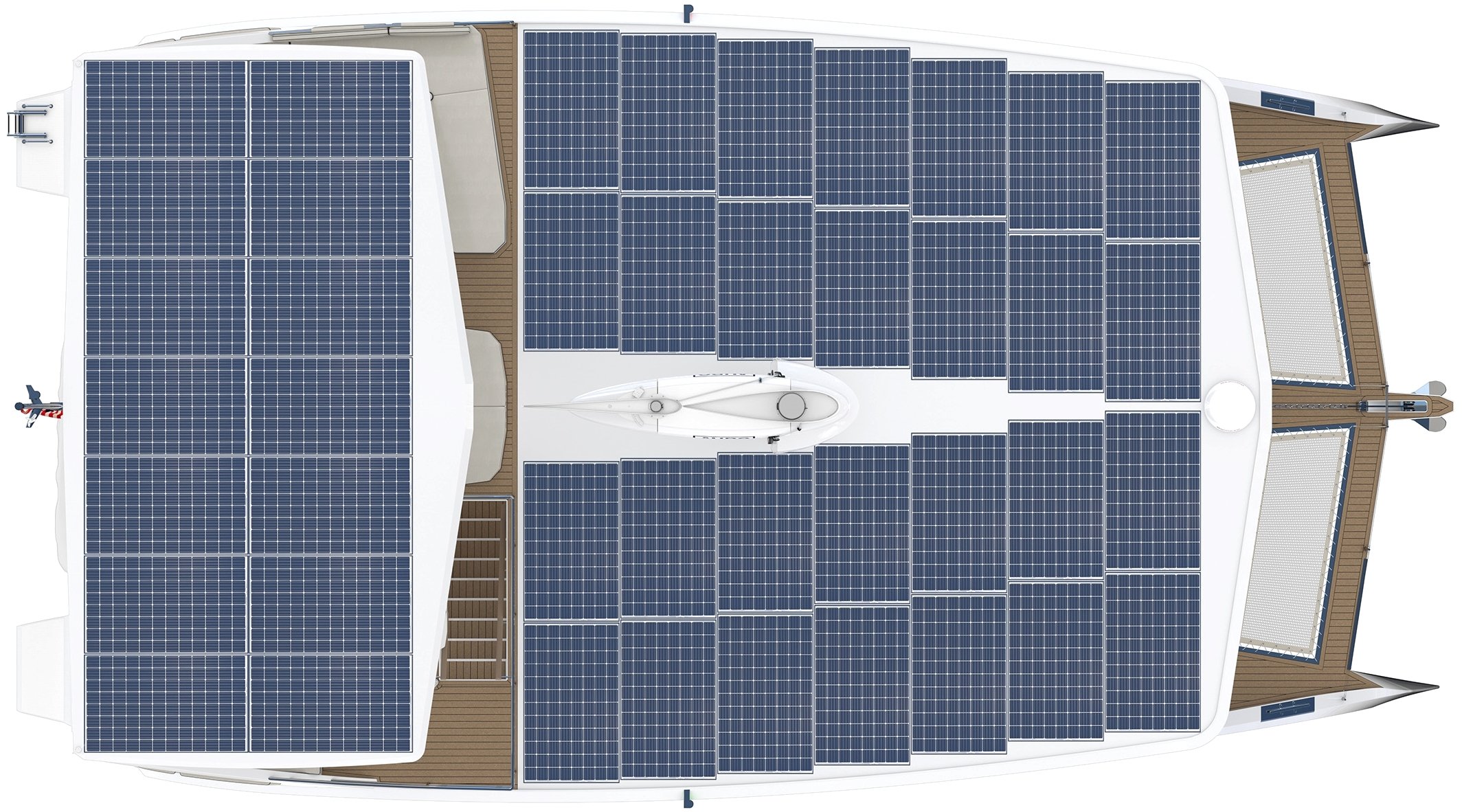
ZEN50 Solar Wingsail Electric Catamaran - Solar Roof Layout

ZEN50 Solar Wingsail Electric Catamaran - Flybridge Layout
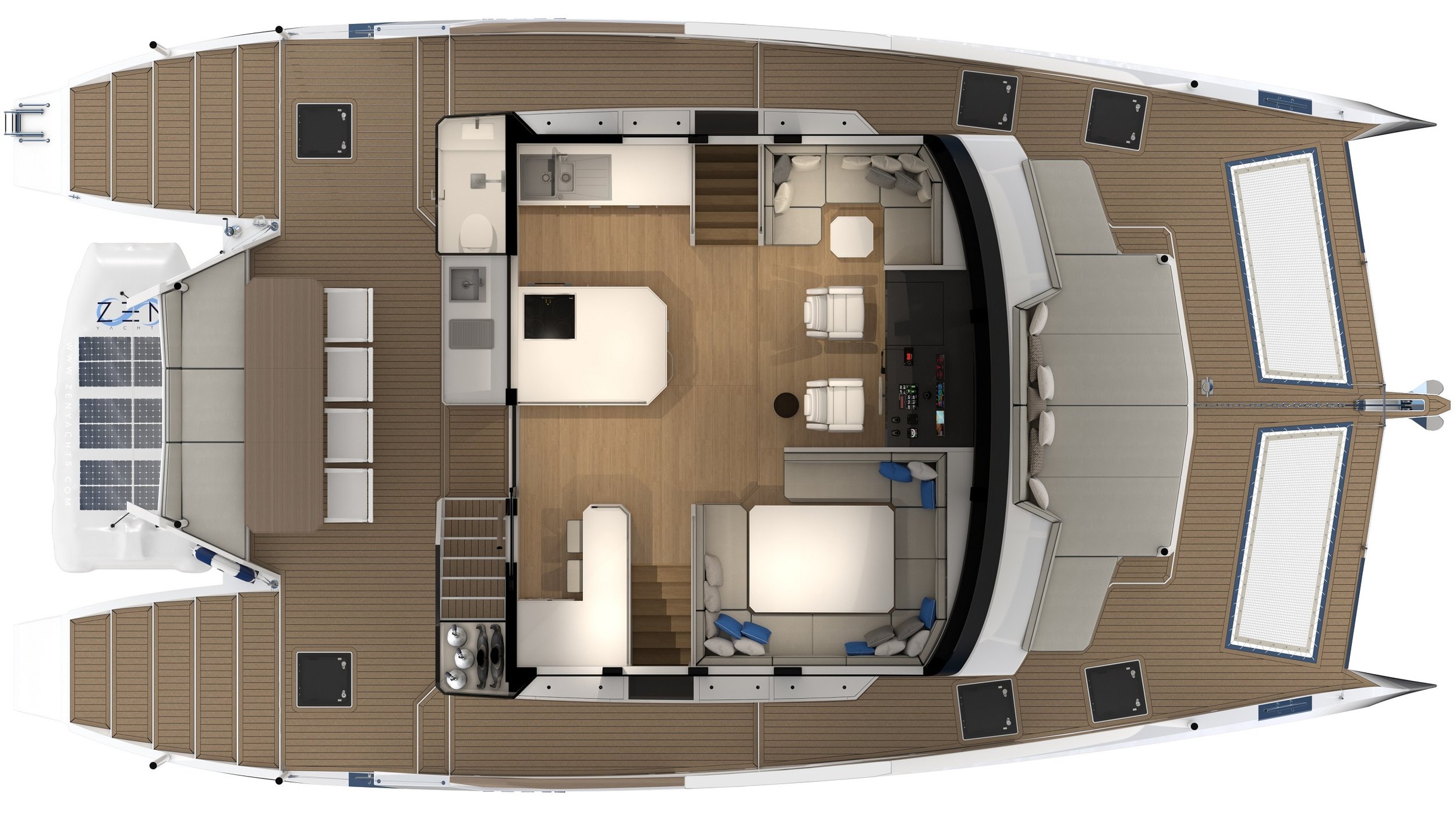
ZEN50 Solar Wingsail Electric Catamaran - Main Deck Layout - Asymmetric D (subject to changes)
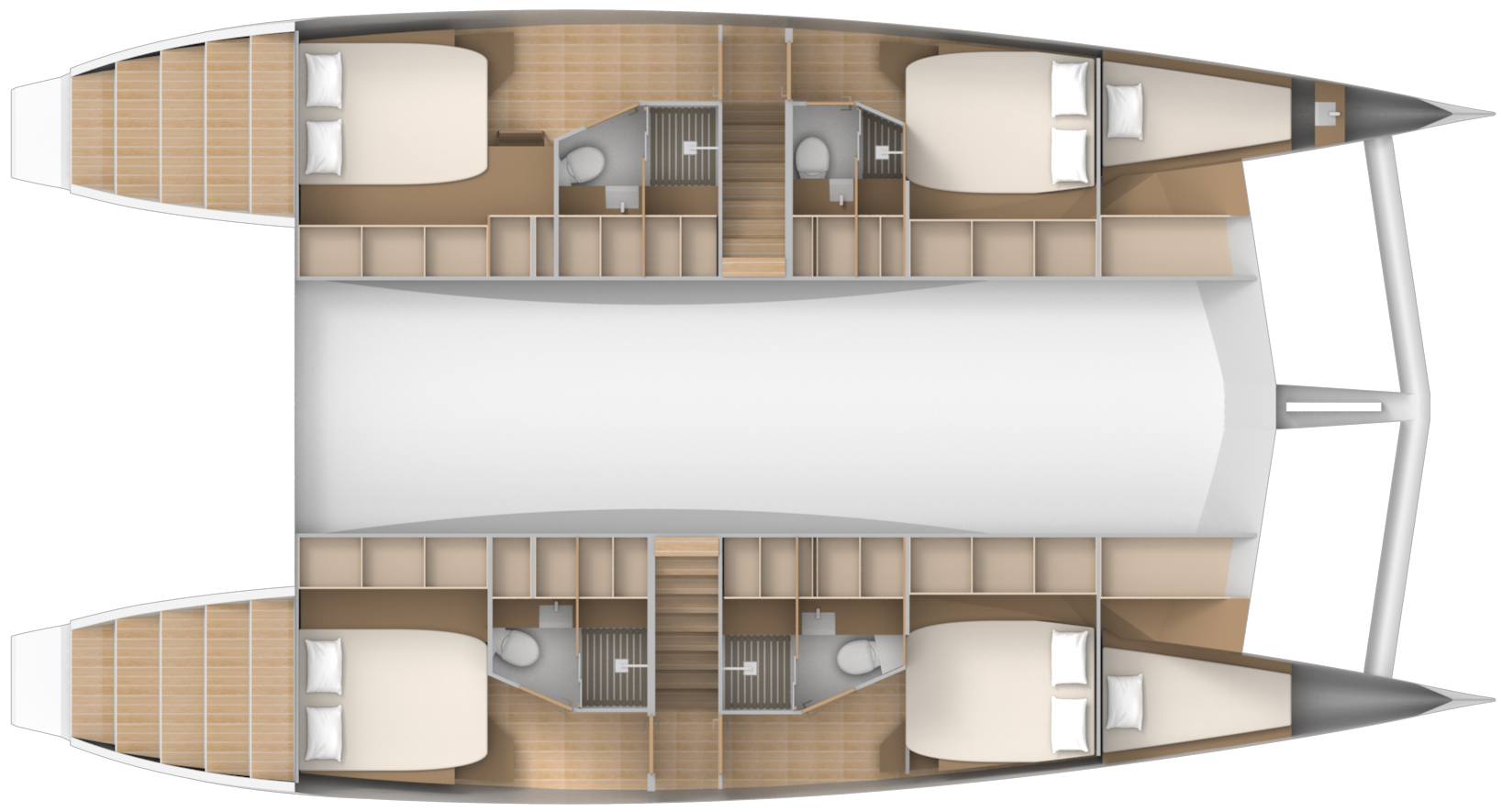
ZEN50 Solar Wingsail Electric Catamaran - Cabin Layout - Asymmetric D (subject to changes)
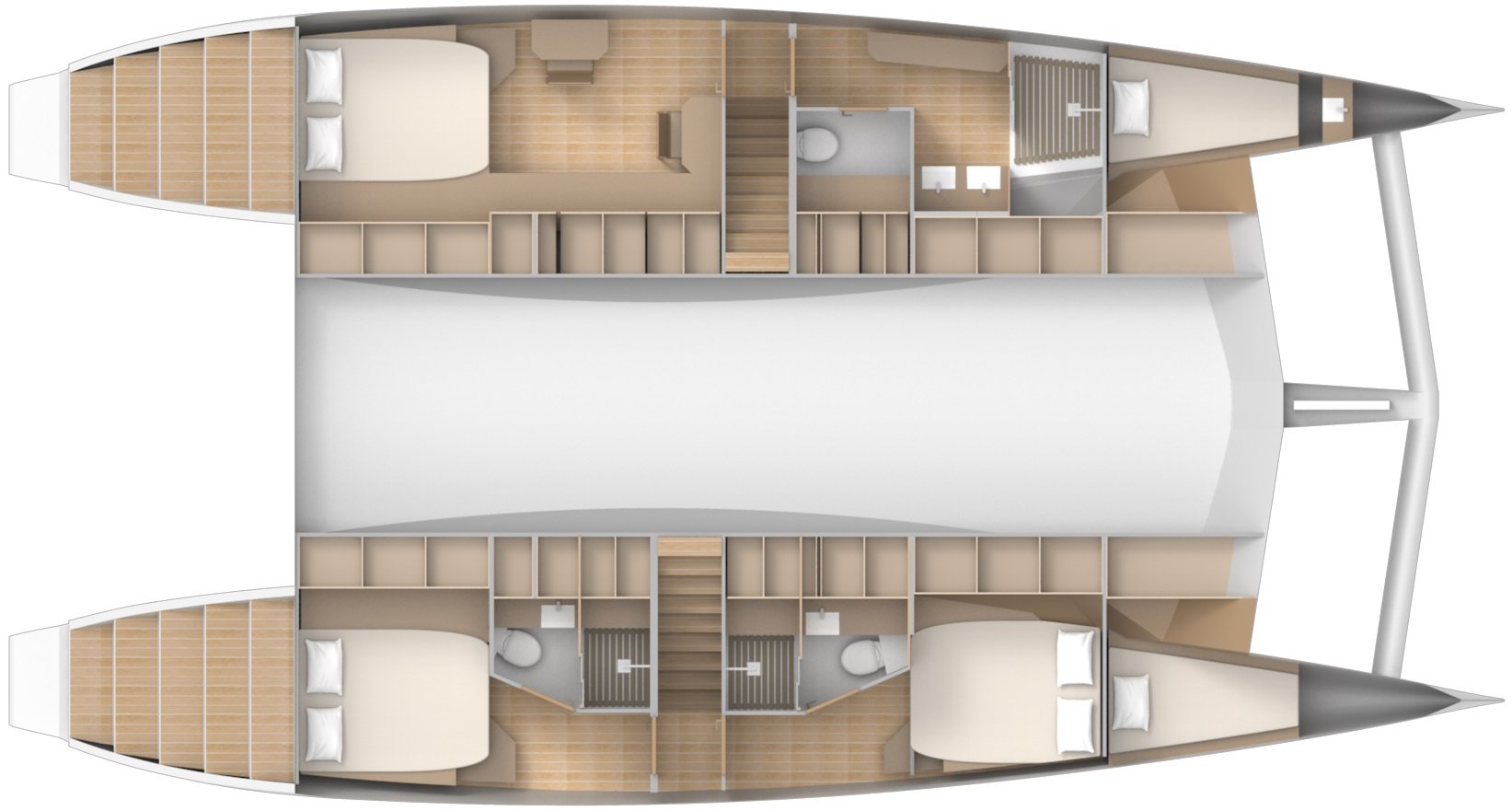
ZEN50 Solar Wingsail Electric Catamaran - Cabin Layout - Asymmetric E (subject to changes)
SOLAR & WINGSAIL
OCEAN RACER
Solar & Wingsail, basic configuration ready to sail, navigation, safety, fridge, etc.
EUR 2 400 000
WORLD CRUISER
Solar & Wingsail, well equipped configuration with, among other options, electric tender, AC and water maker
EUR 2 650 000
ARCTIC EXPLORER
Solar & Wingsail ultimate configuration with all available options
EUR 2 850 000
Solar only, ready to sail basic configuration with navigation, safety, fridge, etc.
EUR 1 850 000
CONTINENTAL CRUISER
Solar only, well equipped configuration with, among other options, electric tender, AC and water maker
EUR 2 100 000
TROPICAL EXPLORER
Solar only, ultimate configuration with all available options
EUR 2 300 000
Ready to reserve your ZEN50?
Want more information .
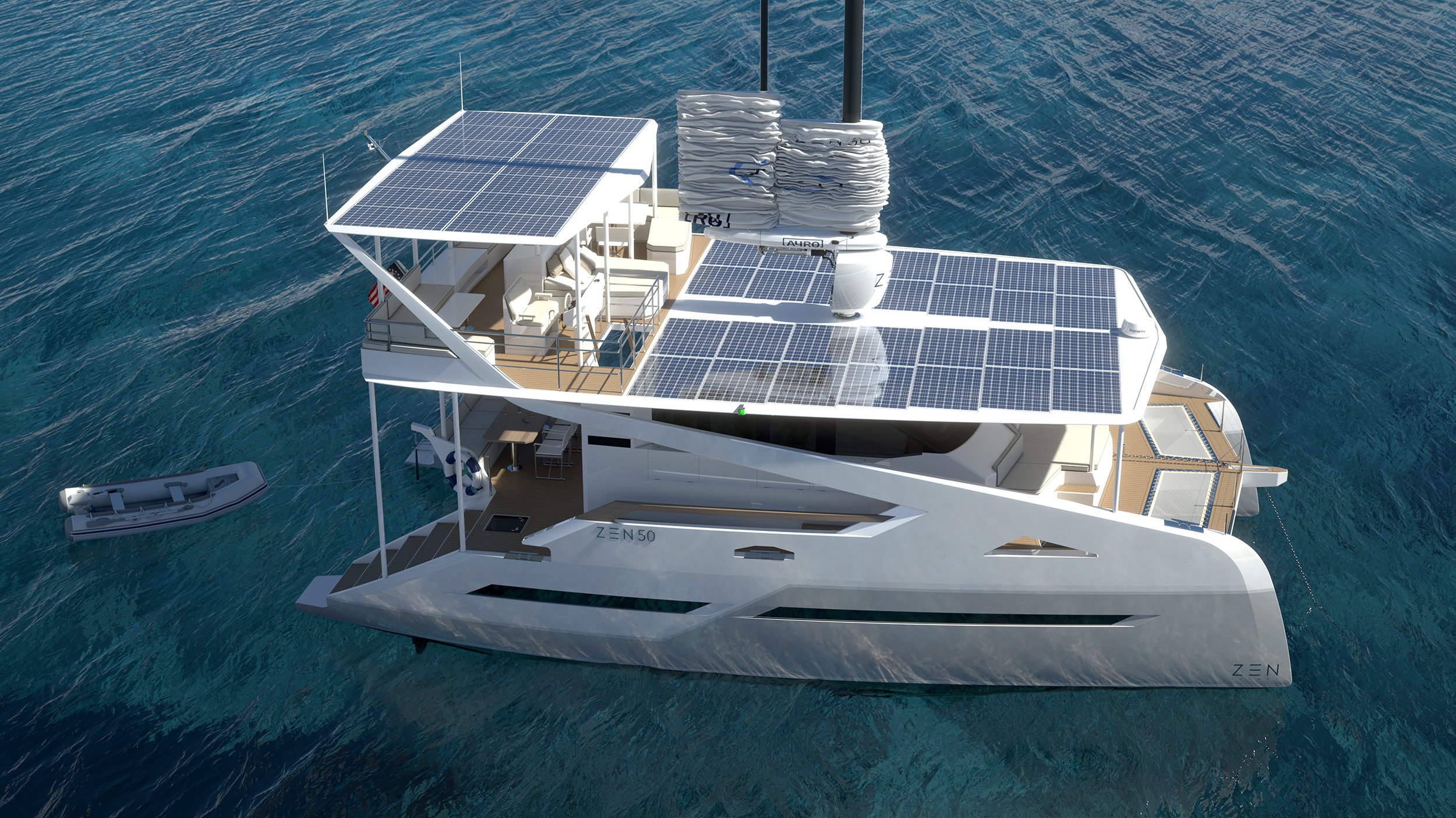
- <img title="Elan Yachts - Elan E4 - sideview" alt="Elan Yachts - Elan E4" src="https://media.elan-yachts.com/img/YACHTS-Sideview-E4.png"><h3><strong>E4</strong> - 34' 9" ft</h3>
- <img title="Elan Yachts - Elan E5 - sideview" alt="Elan Yachts - Elan E5" src="https://media.elan-yachts.com/img/YACHTS-Sideview-E5.png"><h3><strong>E5</strong> - 39'3" ft</h3>
- <img title="Elan Yachts - Elan E6 - sideview" alt="Elan Yachts - Elan E6" src="https://media.elan-yachts.com/img/YACHTS-Sideview-E5.png"><h3><strong>E6</strong> - 50'2" ft</h3>
- <img title="Elan Yachts - Elan i43 - sideview" alt="Elan Yachts - Elan i43" src="https://media.elan-yachts.com/img/I43-YACHTS-Sideview.png"><h3><strong>IMPRESSION 43</strong> - 43'8" ft</h3>
- <img title="Elan Yachts - Elan i50.1 - sideview" alt="Elan Yachts - Elan i50.1" src="https://media.elan-yachts.com/img/YACHTS-Sideview-i501.png"><h3><strong>IMPRESSION 50.1</strong> - 49'10" ft</h3>
- <img title="Elan Yachts - Elan GT5 - sideview" alt="Elan Yachts - Elan GT5" src="https://media.elan-yachts.com/img/YACHTS-Sideview-GT5.png"><h3><strong>GT5</strong> - 43'4' ft</h3>
- <img title="Elan Yachts - Elan GT6 - sideview" alt="Elan Yachts - Elan GT6" src="https://media.elan-yachts.com/img/YACHTS-Sideview-GT6.png"><h3><strong>GT6</strong> - 49'9" ft</h3>
- <img title="Elan Yachts - Elan GT6 X - sideview" alt="Elan Yachts - Elan GT6" src="https://media.elan-yachts.com/img/GT6X-YACHTS-Sideview.png"><h3><strong>GT6 X</strong> - 49'8" ft</h3>
- <img title="Elan Yachts - Elan i40.1 - sideview" alt="Elan Yachts - Elan i40.1" src="https://media.elan-yachts.com/img/YACHTS-Sideview-i401.png"><h3><strong>IMPRESSION 40.1</strong> - 39'4" ft</h3>
- <img title="Elan Yachts - Elan i45.1 - sideview" alt="Elan Yachts - Elan i45.1" src="https://media.elan-yachts.com/img/YACHTS-Sideview-i451.png"><h3><strong>IMPRESSION 45.1</strong> - 45'5" ft</h3>
- Elan Yachting Experience
- Distributors
- Elan Technology
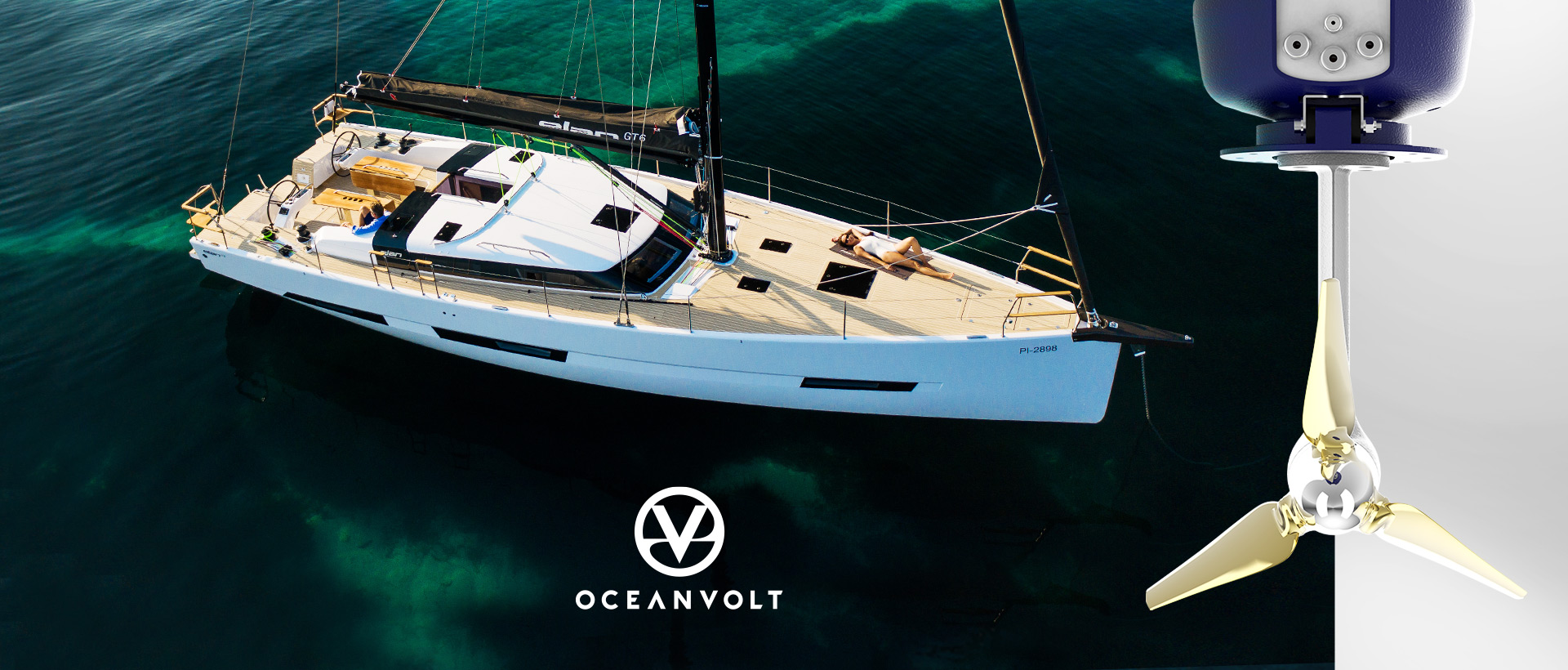
What You Need to Know Before Buying an Electric Sailing Yacht or Sailboat
It’s no secret that we’re approaching, or have maybe even passed the moment in history where most buyers are considering buying an electric vehicle. The awkward early adopter phase is long gone, doubters few and far between, and every car manufacturer has at least some EV options, while others focus exclusively on electric and are experiencing massive growth. Mass adoption is here, the prices are falling, and infrastructure and legislature are hurrying to catch up.
All of this has left many people wondering why not bring sailing boats into the electric world? Sailing was never about motoring, never about engine speed – it is about that connection to nature, the serenity of the sea and the challenge. So why not get rid of the “dirty and loud” diesel engine, and simply exchange it for “clean and quiet” electric propulsion? Motor out of the marina or bay in silence, then use the sun, wind and waves to continue your journey.
Well – it turns out that like all good things in life, it’s not that simple, but it can be completely viable if approached correctly, and Elan and Oceanvolt have partnered-up to offer just that.
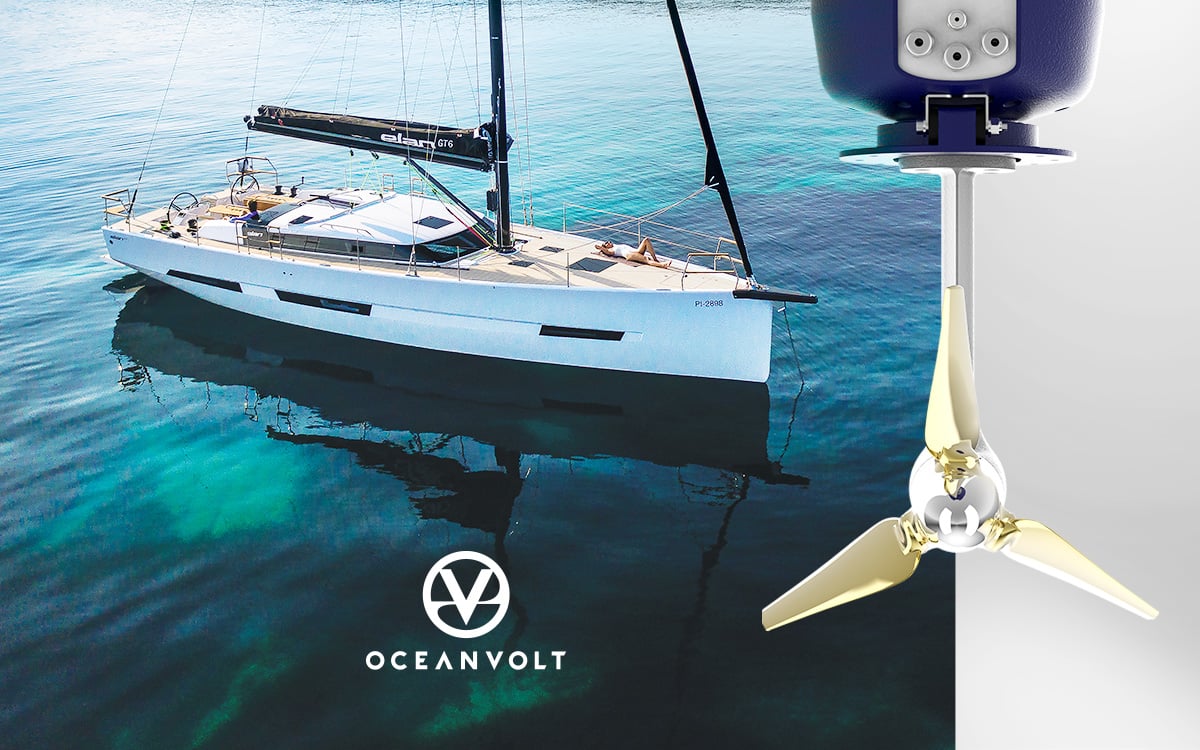
EARLY ADOPTER PHASE
Unlike the automobile industry, electric-powered yachting is still in the early adopter phase. That is why picking experienced manufacturers is crucial. Elan Yachts, for instance, had built various highly successful projects with Oceanvolt in the past and were part of the pioneering few boatbuilders to take on the challenge. The partnership flourished and matured so that Elan is now working exclusively with Oceanvolt and has extended the offer to their whole range of yachts. But what does being an early adopter mean for the buyer? Mostly that the technology is here, but the price is high. For a well-rounded, high-quality and reliable system, you can expect to pay 20-30% more than a comparable diesel-powered sailing yacht. And since a large part of that cost is for the batteries, do not expect that to change very soon as the demand for Lithium-ion batteries is only increasing.
FOR SERIOUS SAILORS
However, let’s assume that the price is not a problem. You want to be among the first few with a zero-emissions yacht – no noise, no exhaust, no smell and no environmental restrictions. You want to sail without the use of fossil fuels. You want the famous instant power output benefits of electricity in emergency situations, no engine rev settling, no pre-start waiting and low maintenance costs. You want to use the wind and the sun to re-charge. All of these are actual benefits of electric yacht propulsion, but what are the downsides? For committed sailors, there are not many. The operating range of high-end electric propulsion systems like the one from Oceanvolt is from 25 to 70 miles at 5 knots (and more, depending on the battery pack options and power generation), which is more than enough to get you in and out of marinas and bays and still have plenty left over to get you out of a bind. The rest, you sail. And if the yacht is fast, the winds are fair and you achieve 5 knots or more, Oceanvolt’s hydrogeneration kicks in and generates power for recharging the battery bank. Hydrogeneration creates drag of only 0.1 knot at a boat speed of 7.0 knots – so it is barely noticeable. If you can go even faster, the power generation increases exponentially (see GRAPH 1).
GRAPH 1: Elan E4 Power generation prediction

(Source: Oceanvolt)
LIVING ABOARD
Buying an electric-powered yacht is still far from an off-the-shelf experience. You need a trusted team of specialists who will guide you through the process and make sure they create a custom solution according to your needs and a good partnership between the shipyard and the electric propulsion provider is crucial. Why is this so different from a car? A yacht is an independent element on the sea and, unlike a car, it will need to provide its owner with much more than just propulsion. It is imperative therefore to consider everything, from the way the yacht is built to the equipment on board. Since you will spend most of your time sailing, you need a yacht that performs well and is easy to sail. A good, reliable sail plan and rig, like the one on Elan yachts, will give you enough options to substitute the practicality of a diesel engine. Elan’s VAIL technology keeps the weight down, its short-handed sailing approach and comfort-centric design will keep you comfortable even when sailing for longer periods, and the high-end electronics are designed to keep consumption low. That is crucial because you will need to bear in mind cooking, refrigeration, water and cabin heating and entertainment, as well as the availability of ports/marinas with good electrical infrastructure. Of course, there are fossil fuel solutions for all these challenges, and Elan’s and Oceanvolt’s partnership offers a hybrid option with a 48V DC generator, which is very practical, if on the pricier side. Purists, however, will want to go full electric. And for them, more renewable power generation options like photovoltaics, a wind generator or a humbler approach to on-board living will be crucial, especially in colder climates. Bear in mind that experienced shipyards like Elan Yachts will be able to provide a complete solution, including solar panel procurement and installation.
POWER OPTIONS
How powerful are electric motors on sailboats? Well, Oceanvolt offers two different propulsion systems. The Finland-based company has developed a 6, 8, 10 and 15kW SD saildrive, as well as a special 10 and 15kW ServoProp with even better hydrogeneration, thanks to its patented and DAME-awarded software-controlled propeller blades, which change pitch to generate as much power as possible. Depending on the yacht, the entry-level SD saildrive enables 5 knots of cruising speed and a top speed of 7 knots on the 30 ft Elan E3. Bear in mind that power consumption and speed is inverse in relation to power generation – as you go faster, you consume exponentially more power (see GRAPH 2) The good part is that the motor and the saildrive weigh only 42.5 kg, which offsets some of the battery weight. In addition, all of the motors are all closed-circuit liquid-cooled, so there is no annoying spluttering.
GRAPH 2 : Elan E3 RANGE PREDICTION
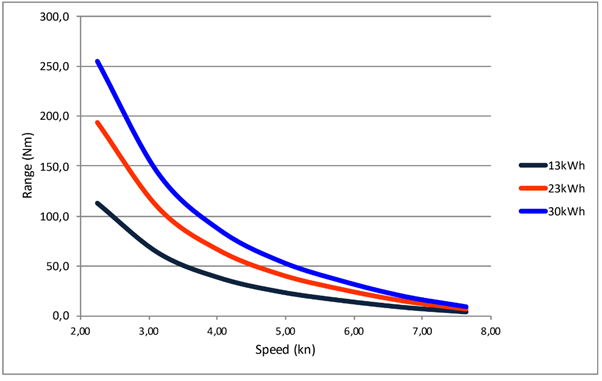
Source: (Oceanvolt)
Want to go electric?
Get in touch with Elan Yachts, and request the configuration of your ideal electric-powered sailboat. Elan is the only yacht manufacturer offering complete electric propulsion solution for the whole range of yachts. Contact our experts, build an energy balance sheet for your needs and your new Elan, taking into account the type of sailing, the environment, living habits and other possible criteria, to create the optimal setup.
E Line Crossover

IMPRESSION Cruising
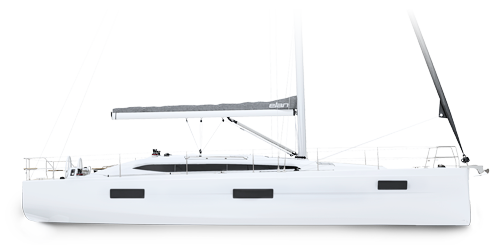
IMPRESSION 43 - 43'8"
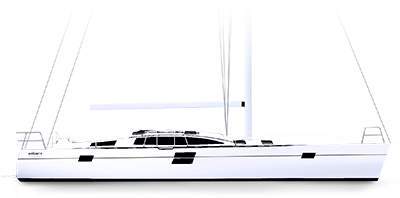
IMPRESSION 50.1 - 48'8"
Gt line luxury performance.
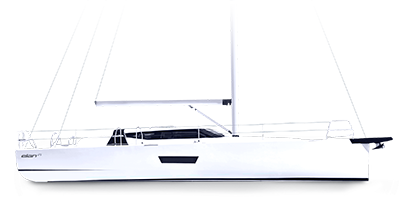
GT5 - 40'9"
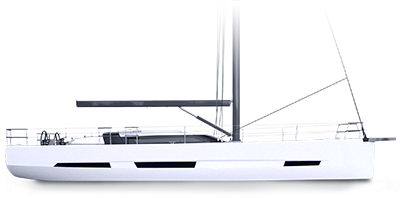
GT6 X - 49'8"
Get in touch.
- Weekly Newsletter
California's Boating & Fishing News

Hunter 33 sailboat anchored in Avalon, Catalina Island Walt White image.
Advantages of Choosing 48V DC Systems for Electric Yachts
NEWPORT BEACH— As the global focus turns to cleaner, greener energy sources, converting yachts from internal combustion engines (ICE) to electric propulsion has become increasingly popular. Among the voltage options available, 48V DC systems offer numerous advantages, including safety, availability, and cost-effectiveness. In this article, we will explore the benefits of opting for a 48V DC system when transitioning a yacht from diesel or gas to electric propulsion.
Electric propulsion is particularly well-suited for sailboats, as the vessel’s sails provide an additional source of power, supplementing or even serving as the primary means of propulsion. The electric motor can act as a secondary power source, making it an ideal fit for sailing enthusiasts who prioritize efficiency and environmentally friendly options. The complementary nature of sail and electric power allows sailors to optimize their energy consumption while maintaining an eco-conscious approach to boating.
Creating an Optimal Electric Propulsion Experience:
Making a great user experience with electric propulsion involves several key factors :
- Smooth and quiet operation
- Ease of use
- Reliable performance
- Efficient energy management
- Easy maintenance
- Clear monitoring and display
- Quick and efficient charging
- Safety features
- Safety and Regulatory Advantages of 48V DC Systems
Electrical Safety on Boats:
Compliance with marine electrical standards, such as those set by the American Boat and Yacht Council (ABYC), is crucial for safety. Systems using voltages higher than 48V DC often involve additional safety and regulatory requirements. By selecting a 48V DC system, the voltage stays below the 60V DC limit, bypassing these extra regulations and ensuring a “touch-safe” environment on board.
Compatibility with Electrical Equipment:
First let’s look at a list of typical “house loads” on a yacht (these are all the electrical loads on board, except for the electric motor used for propulsion).
Grouped into AC and DC loads, with approximate power consumption for each:
- Interior and exterior lighting (LED) – 1-3W per light
- Navigation equipment (chartplotter, GPS, radar, etc.) – 10-50W
- Communication equipment (VHF radio, AIS, satellite phone, etc.) – 5-25W
- Starlink Satellite Internet Service – 75W
- Water pumps (freshwater, bilge, shower sump, etc.) – 10-50W
- Refrigeration and freezer units – 40-200W
- Marine electronics and instruments (depth sounder, wind instruments, autopilot, etc.) – 5-50W
- Battery charging systems (for main and auxiliary batteries) – 10-50A
- Electric toilets and holding tank pumps – 10-50W
- Anchor windlass – 500-2000W
- Bow and/or stern thrusters – 2-8kW
- Electric winches and sail handling equipment – 100-800W
- Ventilation fans and blowers – 10-50W
- Security and monitoring systems (alarms, cameras, etc.) – 5-20W
- Entertainment systems (TV, stereo, speakers, etc.) – 50-300W
- Galley appliances (microwave, stove, oven, etc.) – 500-1800W
- Air conditioning and heating systems – 500W-10kW
- Inverter and/or generator for AC power supply – 50-2000W (depending on the size of the inverter/generator)
- Shore power connections and charging systems – 500-2000W
- Electric dinghy davit or crane system – 500-2000W
- Water-makers and water purification systems – 300-2000W
One significant advantage of a 48V DC system is the broad range of compatible electrical equipment available for yacht re-powering. Retrofitting or replacing house loads with a 48V DC system is generally a straightforward task for marine electrical technicians, and often even for boat owners, as it avoids the complexities associated with high-voltage systems.
Inboard motors for propulsion, like the Newport-25, operate on 48V DC power, eliminating the need for any high-voltage systems on board. Other essential components such as power inverters, battery chargers, and solar chargers are also more readily available and affordable for 48V DC systems compared to higher voltage alternatives.
Simplified and Cost-Effective Power Conversion:
Converting power from the main battery to support various onboard loads is a crucial aspect of re-powering a yacht with an electric propulsion system. With a 48V DC system, it is simpler and more cost-effective to convert power to the commonly used 12V DC for house loads, such as pumps, lights, cockpit instruments, and radios. This conversion can be easily achieved using a DC-DC converter that steps down the voltage from 48V to 12V DC. With the exception of the windlass and bow thrusters, high-power 12V DC systems can be easily accommodated with this setup.
In Summary:
Choosing a 48V DC system for re-powering a yacht from diesel or gas to electric propulsion offers numerous benefits, such as enhanced safety, compatibility with a wide range of equipment, and cost-effective power conversion. By staying within the “touch-safe” range and avoiding additional regulatory requirements, yacht owners can experience a seamless transition to cleaner and more sustainable electric propulsion without compromising on performance or convenience.
Sailboats are well suited for electric propulsion. They typically have lower power and speed requirements than power yachts, which makes them a fitting choice. The lower power demands mean that they can operate with smaller battery banks and motors, reducing both the weight and cost of the overall system. As a result, sailboats can enjoy the advantages of electric propulsion, such as reduced noise, minimal vibrations, and easier maintenance, without the need for large, expensive power systems. The combination of sails and electric propulsion provides a sustainable and enjoyable boating experience that emphasizes the importance of harmony with nature while meeting the needs of today’s eco-conscious sailors.
About the Author:
Walt White is the founder and CEO of NewportElectricBoats.com and Systems engineer, working to bring products to market that are best in class and make a positive impact on the environment. Our electric motors and monitoring electronics help sailboats transition to battery powered electric propulsion. Newport Electric Boats designs electric propulsion systems for sailboats.
Caption: Hunter 33 sailboat anchored in Avalon, Catalina Island
Walt White image.
This article was reprinted with permission from the author, Walt White, CEO of Newport Electric Boats and was edited for formatting by the Log. The article can also be found at newportelectricboats.com .
Share This:
- ← Fast Facts: Chain of Command— The Bosun and Their Role
- Ask A Maritime Attorney: Can you explain the property tax allocation after purchasing a used boat? →
Comments Cancel reply
Your email address will not be published. Required fields are marked *
Your Thoughts are Appreciated
Save my name, email, and website in this browser for the next time I comment.
JavaScript seems to be disabled in your browser. For the best experience on our site, be sure to turn on Javascript in your browser.

- X Shore PRO
- Design & Order
- Sustainability
- Press & media

- Compare Products
High performance
The Eelex 8000 is built for high performance and offers a truly unique boating experience. Explore the oceans, lakes and nature without the harmful noise and fumes a fossil. Fuel engine emits with the true power of electric silence. And the modular design with 10+ layouts can be adapted to every need - from fishing to socializing.

Eelex 8000 Specs
8m / 26.2 ft, 2.6 m / 8.5 ft, 0.8 m / 2.6 ft, 2,600 kg / 5,730 lbs.
Acceleration
0-20 knots in 4.2 Seconds
Cruising speed
Battery Capacity
100 NM at lower speeds
1h 10 min fast charging, 24 inch touchscreen.


IMAGES
VIDEO
COMMENTS
ALVA Yachts, the German builder of luxury electric solar catamarans and sail boats, has announced it is currently building the world's first fuelless 90ft superyacht catamaran with wings, the OCEAN ECO 90 H2. The first superyacht catamaran to run without fossil fuels and producing zero emission, the OCEAN ECO 90 H2 is designed with luxury ...
Cheoy Lee Clipper on Lake Superior. Jan 2, 2023. Sailing with an Electric Motor In 2021 we installed the QuietTorque™ 10.0 Electric Motor by Electric Yacht on our 1972 Cheoy Lee Clipper Sailboat, which we use for day charters from May through October on Lake Superior. We have been extremely satisfied with the...
In addition to emissions-free yachting, electric yachts deliver quiet, vibration-free rides that are easy to get used to. Courtesy Sunreef Yachts. Finally, there can also be the grin factor. "The Eelex 8000 can accelerate from 0 to 20 knots in 4.2 seconds," Wästberg says.
Apr 3 2024 - 7:20 am PT. Sustainable boatbuilder Sunreef Yachts is adding a sleeker, lighter solar electric catamaran to its portfolio. The new Explorer Eco 40m is the company's smallest ...
QuietTorque™ 30.0 LC Electric Motor $ 15,995.00; QuietTorque™ 10.0 Sail Drive $ 10,495.00; QuietTorque™ 20.0 Sail Drive $ 14,695.00; QuietTorque™ 30.0 LC Sail Drive $ 20,995.00; QuietTorque™ 10.0 Electric Motor $ 5,495.00; QuietTorque™ 5.0DD Electric Motor $ 5,495.00; QuietTorque™ 15.0 LC Electric Motor $ 9,995.00; QuietTorque ...
The Arcona 380Z is a standard production yacht that has been adapted for electric propulsion. Note the increased solar panel surface area with soft panels bonded to the sails. Credit: Jukka Pakainen. A modern electric yacht can come in all shapes and sizes, from the latest high-tech speed boats with recently developed high-performance electric ...
Award Winning Electric Propulsion. Elco Motor Yachts has been at the forefront of marine innovation, proudly boasting a rich history spanning over 130 years. The company supplied 55 groundbreaking electric launches at the 1893 Chicago World's Fair. The vessels, powered by Elco's electric boat motors, swiftly captured the hearts of boating ...
Imported into the US market by Green Marine, the Swedish-built Arcona 435Z is a rarity: an all-electric cruising sailboat. Jon Whittle. This past October, I saw one of the most interesting exhibits in more than 500 new cruising sailboats I've reviewed over two decades. It was the Arcona 435Z, built in Sweden and introduced by Graham Balch of Green Yachts in San Francisco.
The electric yacht's cutting-edge technology-focused design allows you to cruise indefinitely at a comfortable speed of 5 knots without relying on shore power, as the solar panels provide enough electricity for the electric motor. However, you can add a hydrogen or diesel generator in case the clouds are ever not in your favor or if you ...
The company's eco-powered yachts include fully electric-solar cruisers and catamarans from 50 feet (15.20 meters) to 90 feet (27.5 meters). Alva Yachts has also designed two electric sailing yachts, the Ocean Sail 72 (22,25 meters) and the mammoth Ocean Sail 82 (25 meters), likely the first fully-electric 80-foot sailing yacht. Ocean Sail 72
We are proud to be a company settled in La Ciotat Shipyards since year 1996. We intervene mainly on the Barcelona - Genova area in Europe and on the Carribean area. ELECTRIC YACHT EQUIPMENT opens the way to technical performance, proximity to its customers, and greater professionalism in the yachting industry. +33 (0)4 42 83 13 72.
In 2017, Dasher Concept launched as the world's first fully electric luxury yacht. The Dasher story started in 2016 in the wake of a Hinckley-sponsored technology summit to discuss the future of yachting. This gathering of futurists included entrepreneurial leaders, accomplished engineers, and known innovators from all over the world.
Let us help you enhance your boating experience with a Reliable, Clean, Green and Quiet Electric Yacht "plug & play" e-prop or hybrid system. e Marine can also provide "custom" solutions for more specific applications. We can supply the electric drive system and controls, battery bank, cabling and if so desired renewable energy charging system.
A small but growing number of yacht dealers offer new and used electric boats. Green Yacht Sales is an example of a small company that supports the sale of electric yachts and systems from diverse manufacturers. Global clearinghouses, like YachtWorld and Boat Trader, now provide options to filter searches for electric propulsion sailboats.
The current range comprises six models from 20ft to 32ft, however only the models up to 25ft are available as electric boats. The top-of-the-range electric model, the Boesch 750 Portofino Deluxe, has twin 50kW Piktronik motors giving a top speed of 21 knots and a range of 14nm. Boesch 750 Portofino Deluxe specification.
The Swedish-built X Shore Eelex 8000 has the distinction of being one of the first and most widely-recognized electric boats. She is 26.2' (8 m) long and is powered by a 175 kW peak and 145 kW continuous-power, electric motor. Her 1,764-lb. (801 kg.) 126 kWh battery bank is made by Kreisel, the leading European name in lithium-ion marine ...
Electric catamarans can substantially reduce fossil fuel use by relying on sun and wind for energy generation. Yachts equipped with electric engines allow for quiet journeys and provide for a more relaxing environment on board thanks to a silent, vibration and fume-free operation. On top of environmentally friendly propulsion, electric engines ...
Arcona is also a pioneer in electric propulsion. It already has the largest fleet of electric sailboats on the water, the first being the Arcona 380Z (for Zero emission) launched in 2015. In 2019 Graham Balch of Green Yacht Sales wrote about What it's Like to Cross the Atlantic Ocean in an Electric Sailboat. You can read the whole story ...
Electric Yachts | SILENT 60 is the first solar powered yacht that crossed the Atlantic | Electric yachts combined with luxury. Skip To Content. TEL:+39 0721 1631220; Menu. Yachts. Electric Yachts. Silent's complete range of solar-electric yachts. 60 Series 80 Series 120 Explorer.
The blue water capable ZEN50 lightweight racing carbon hulls are combined with a huge solar roof for an unrivaled solar power vs. displacement ratio above 1:1 (18 kW / 17 tonnes), making this yacht completely energy self-sufficient. A revolutionary, fully automated, wingsail - by Ayro© - can be added as a range and speed extender.
Hydrogeneration creates drag of only 0.1 knot at a boat speed of 7.0 knots - so it is barely noticeable. If you can go even faster, the power generation increases exponentially (see GRAPH 1). GRAPH 1: Elan E4 Power generation prediction. (Source: Oceanvolt) LIVING ABOARD. Buying an electric-powered yacht is still far from an off-the-shelf ...
One significant advantage of a 48V DC system is the broad range of compatible electrical equipment available for yacht re-powering. Retrofitting or replacing house loads with a 48V DC system is generally a straightforward task for marine electrical technicians, and often even for boat owners, as it avoids the complexities associated with high ...
Outstanding speed and resilience. Eelex 8000 is built for high performance with a responsive drivetrain and a hull optimized for low resistance and maximum hull efficiency. With a 170 kW motor and a 126 kWh battery capacity, it will reach a speed of 30+ knots with a cruising speed of 20 knots. Motor. 170 kW.
Don't forget that If you have a fuel card for a lawn mower, generator, boat motor, pump or other piece of equipment, those cards are expiring too!! ... Surprisingly the winner was not a pure electric vehicle, it was a plug-in hybrid Prius Prime. The top 12 consists of seven battery EVs, two plug-in hybrids like the Prius, and two gas-electric ...